
Written and illustrated by Violetta Zein
This part covers the life of Shoghi Effendi from the age of 54 in 1951 to the age of 55 in 1952.
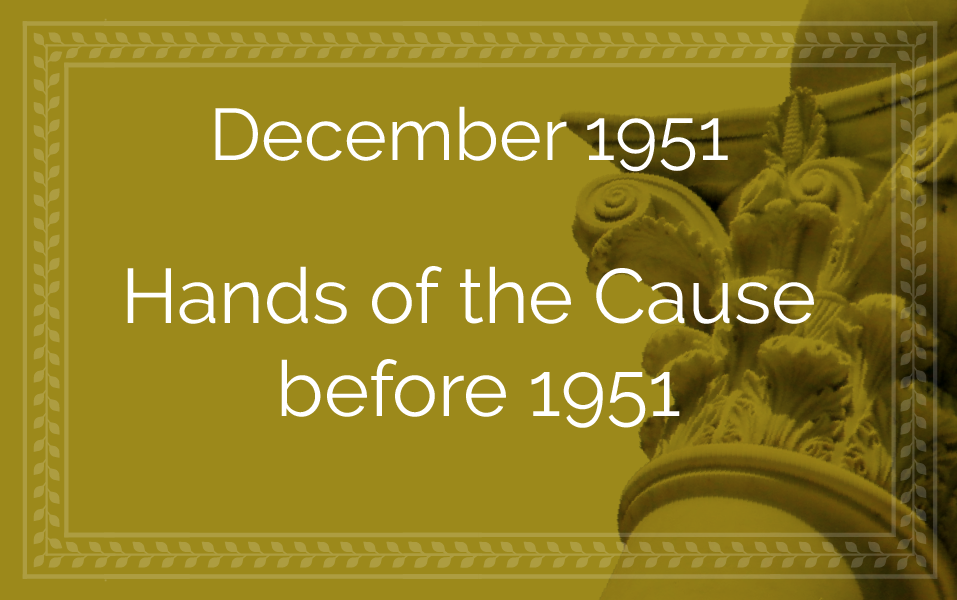
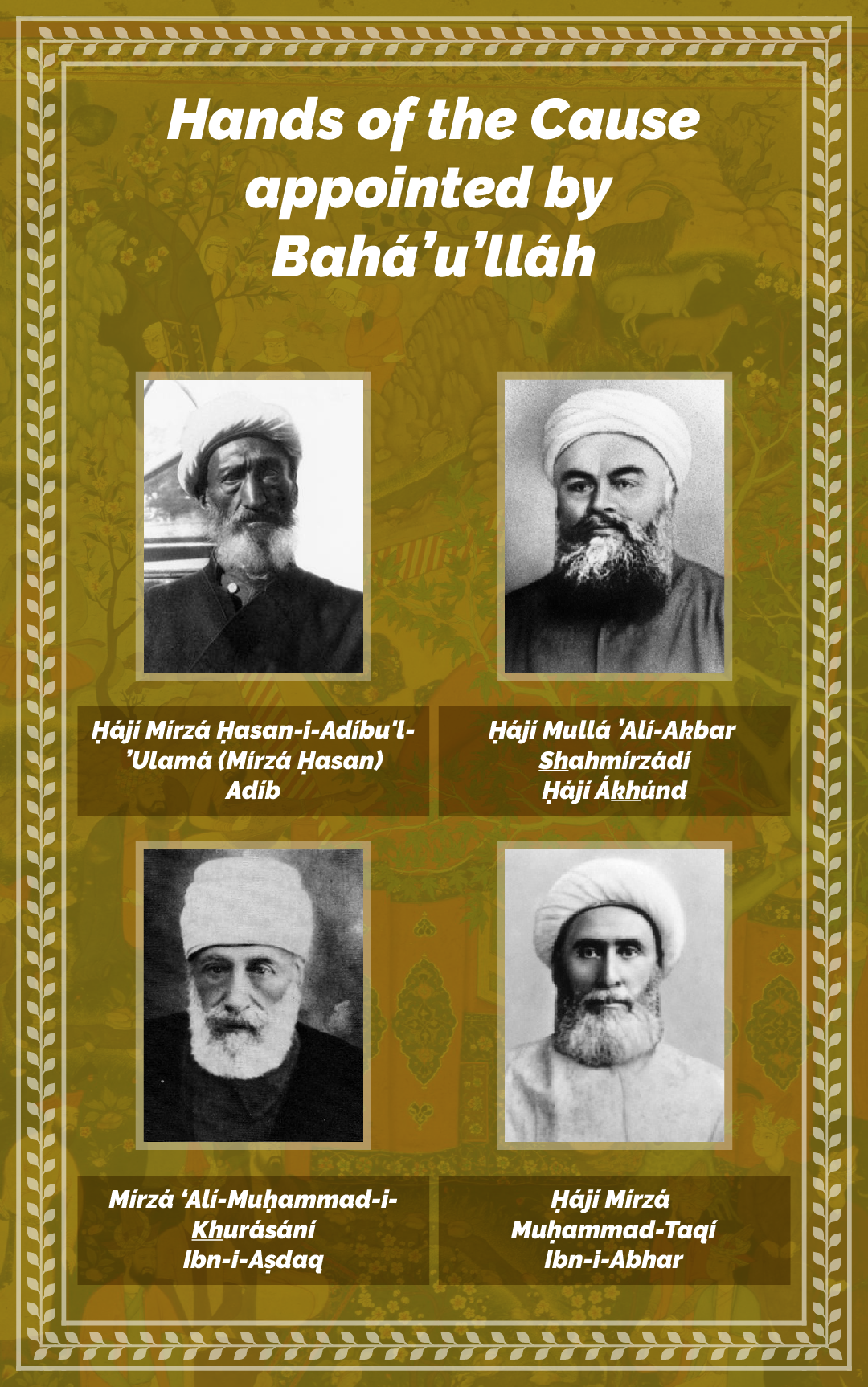
The four Hands of the Cause whom Bahá'u'lláh appointed during His lifetime. Background image: Persian miniature from The British Museum.
The station of Hand of the Cause was established by Bahá’u’lláh during in the Kitáb-i-Aqdas:
In this holy cycle the “learned” are, on the one hand, the Hands of the Cause of God, and, on the other, the teachers and diffusers of His Teachings who do not rank as Hands, but who have attained an eminent position in the teaching work.
and He Himself appointed four living Hands of the Cause—extraordinary believers—who carried out their dual task of propagating the Faith and protecting it:
- Ḥájí Mírzá Ḥasan-i-Adíbu'l-ʻUlamá, also called Mírzá Ḥasan, but better known as simply Adíb
- Ḥájí Mullá ʻAlí-Akbar S͟hahmírzádí, known as Ḥájí Ákhúnd
- Mírzá ʻAlí-Muḥammad-i-K͟hurásání, known as Ibn-i-Aṣdaq
- Ḥájí Mírzá Muḥammad-Taqí, known as Ibn-i-Abhar
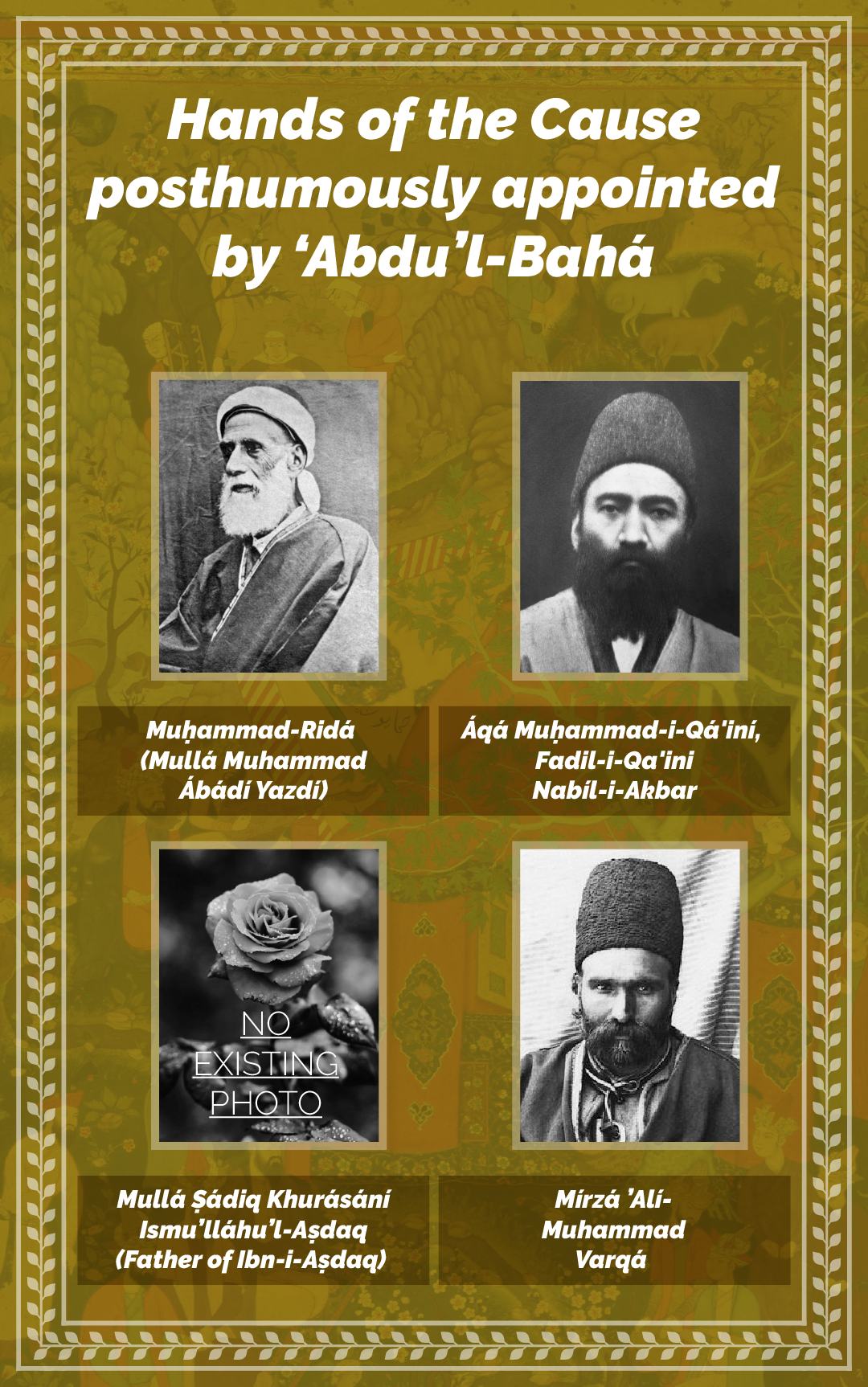
The four Hands of the Cause whom 'Abdu'l-Bahá appointed during posthumously in 1915. Background image: Persian miniature from The British Museum.
'Abdu'l-Bahá Himself did not appoint living Hands of the Cause. He appointed four Hands of the Cause posthumously in the course of giving the talks in 1915 that were eventually published as Memorials of the Faithful:
- Muḥammad-Ridá (Mullá Muhammad Ábádí Yazdí)
- Áqá Muḥammad-i-Qá'iní, also called Fadil-i-Qa'ini, but better known as Nabíl-i-Akbar
- Mullá Ṣádiq Khurásání, known as Ismu’lláhu’l-Aṣdaq
- Mírzá ʻAlí-Muhammad, known Varqá
In His Will and Testament, 'Abdu'l-Bahá stated that only the Guardian could elevate a believer to the rank of Hand of the Cause of God:
O friends! The Hands of the Cause of God must be nominated and appointed by the Guardian of the Cause of God. All must be under his shadow and obey his command.
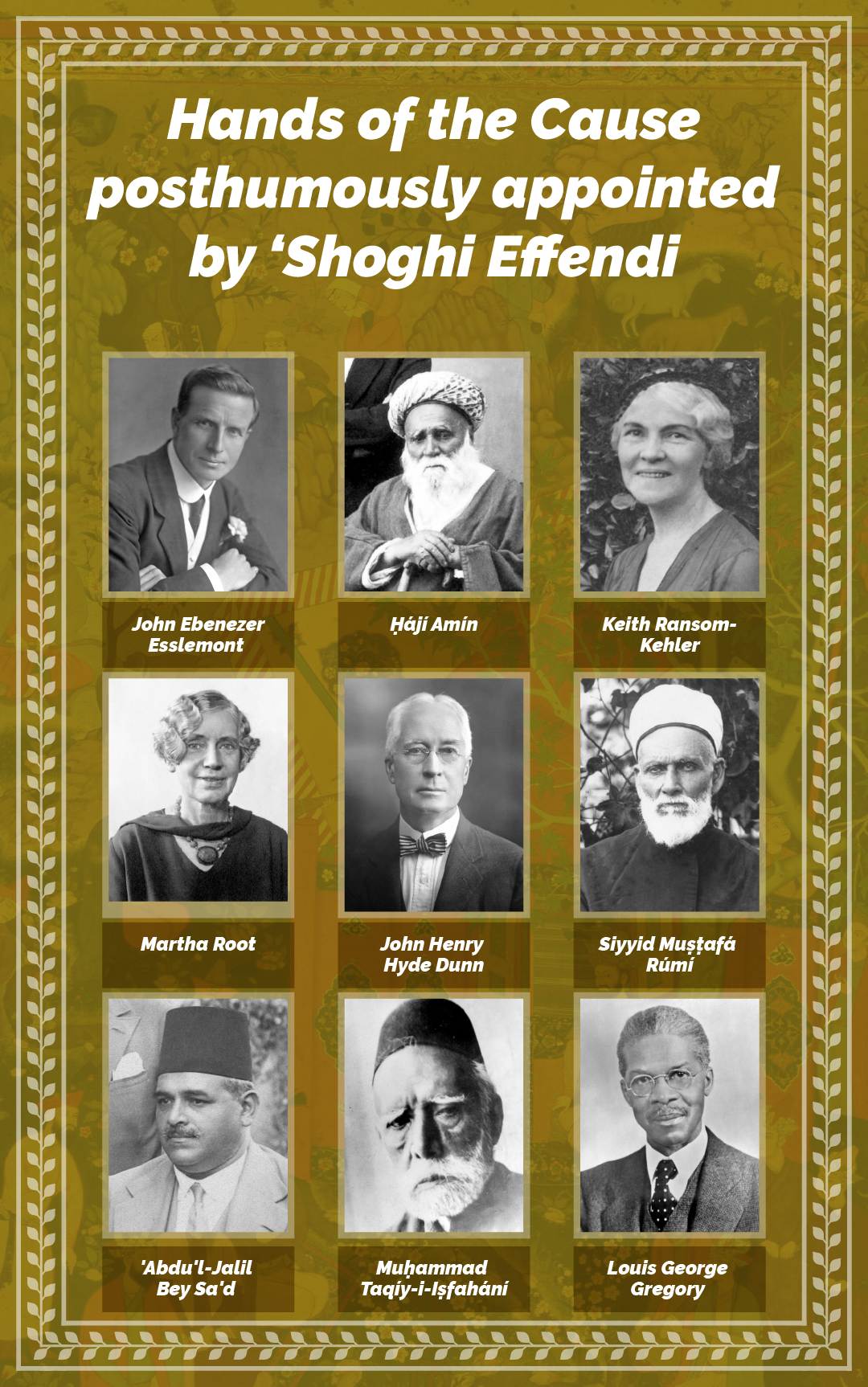
The nine Hands of the Cause whom Shoghi Effendi appointed posthumously during the first 30 years of his ministry, from 1925 to 1951. Background image: Persian miniature from The British Museum.
The station of Hand of the Cause was the highest honor that the Guardian could ever bestow on any Bahá'í, living or dead.
Except for one exception—Amelia Collins, which we looked at on 22 November 1946—for the first three decades of his ministry, Shoghi Effendi followed 'Abdu'l-Bahá’s example and only appointed Hands of the Cause posthumously, either immediately after their death or shortly thereafter:
- John Ebenezer Esslemont (1874–1925) – Posthumously appointed on 30 November 1925
- Ḥájí Amín (1831–1928) – Posthumously appointed in July 1928
- Keith Ransom-Kehler (1876–1933) – Posthumously appointed on 28 October 1933
- Martha Root (1872–1939) – Posthumously appointed on 2 October 1939
- John Henry Hyde Dunn (1855–1941) – Posthumously appointed on 26 April 1952
- Siyyid Muṣṭafá Rúmí (1846–1945) – Posthumously appointed on 14 July 1945
- 'Abdu'l-Jalil Bey Sa'd (d. 1942) – Posthumously appointed on 25 June 1942
- Muhammed Taqíy-i-Iṣfahání (1860–1946) – Posthumously appointed shortly after 13 December 1946
- Roy C. Wilhelm (1875–1951) – Posthumously appointed on 23 December 1951
- Louis George Gregory (1874–1951) – Posthumously appointed on 6 August 1951
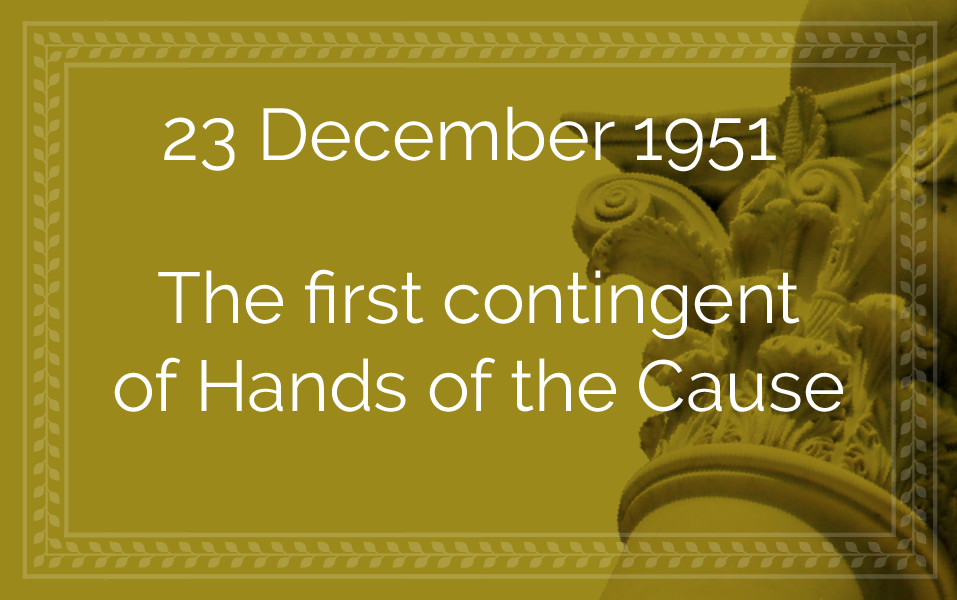
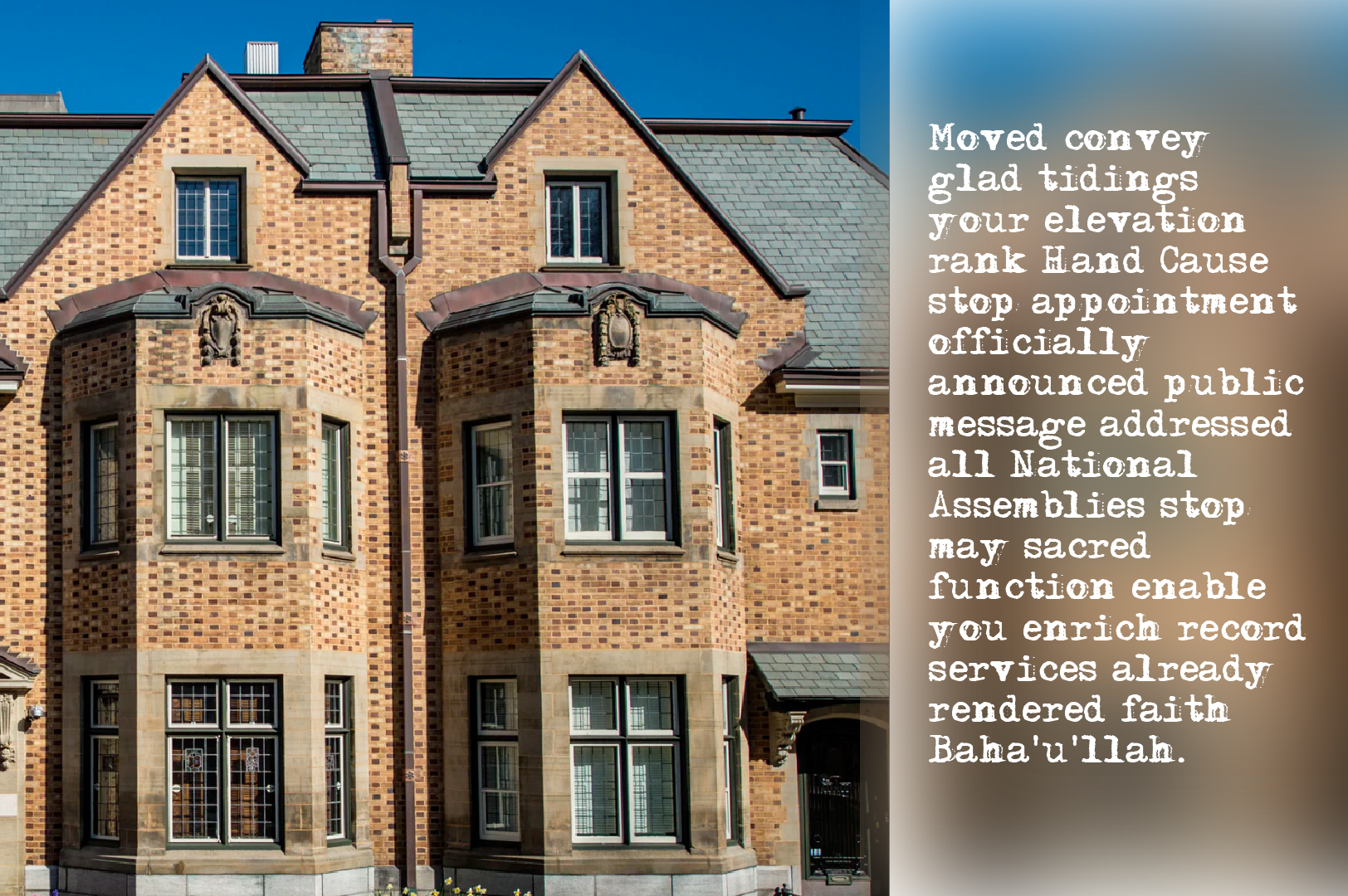
William Sutherland Maxwell’s home at 1548 Pine Avenue in Montreal, now the only Bahá'í Shrine in North America. Source: Bahá'í Media Bank, © Bahá'í International Community 2023.
All the Hands of the Cause received private messages informing them of their elevation to rank of Hand of the Cause, but because William Sutherland Maxwell was the father of Shoghi Effendi’s wife, his cable is shared here.
Sutherland had left for Montreal after his serious illness, and on 23 December 1951, 24 hours before it was publicly announced to the world, he received a life-changing cable from the Guardian:
Moved convey glad tidings your elevation rank Hand Cause stop appointment officially announced public message addressed all National Assemblies stop may sacred function enable you enrich record services already rendered faith Bahá'u'lláh.
Four days later, on 27 December 1951, Rúḥíyyih Khánum sent this proud cable to her beloved father:
Congratulations Daddy dearest on your appointment by beloved Guardian station Hand Cause all my love Mary
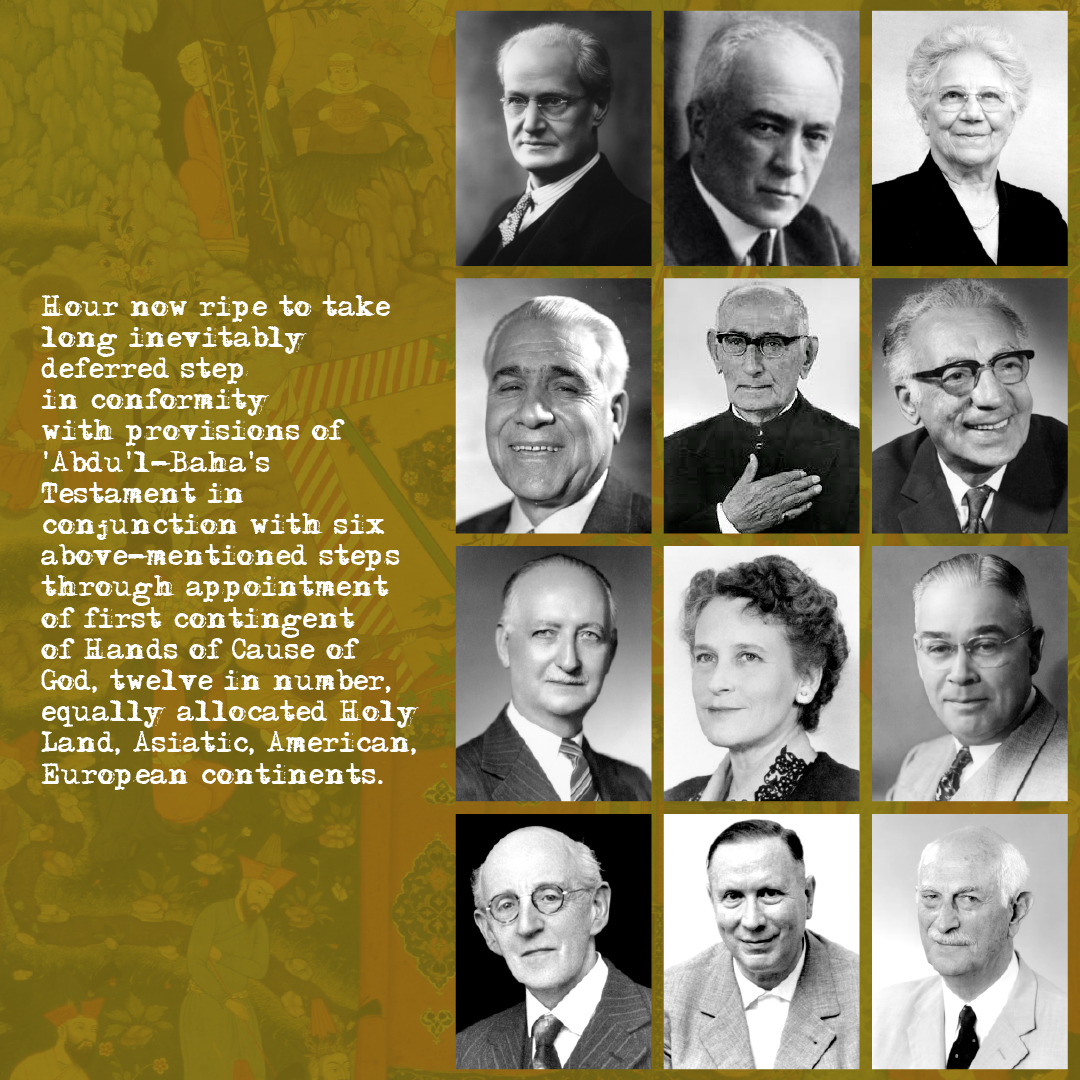
Eleven months after the first thunderclap cable the Guardian sent regarding the International Bahá'í Council, the Bahá'í world saw its worldview regarding its Administrative Order change overnight.
On 24 December 1951, the Guardian suddenly thrust into being the entire appointed arm of the Administrative Order of the Faith, in one fell swoop:
Hour now ripe to take long inevitably deferred step in conformity with provisions of 'Abdu'l-Bahá’s Testament in conjunction with six above-mentioned steps through appointment of first contingent of Hands of Cause of God, twelve in number, equally allocated Holy Land, Asiatic, American, European continents.
But before he did this, in this very long and complex message of 24 December 1951, the Guardian did several things.
Between 1921 and 1946, over the course of the first 25 years of the Formative Age, inaugurated with the ministry of Shoghi Effendi, two of the greatest developments in the history had taken place: One, the local and national institutions of Bahá'u'lláh’s Administrative Order had grown and strengthened, and two, the First Seven Year Plan, at long last, after 20 years, inaugurating the prosecution of 'Abdu'l-Bahá’s Divine Plan.
By late 1951, explained Shoghi Effendi, the Bahá'í world was still in the early years of the second epoch of the formative age.
It was now time for the third “vast majestic fate-laden process,” the crown of Bahá'u'lláh’s embryonic World Order: six nascent institutions at the heart of the Bahá'í World Centre. These institutions, in the order listed by the Guardian himself were:
- First, the superstructure of the Shrine of the Báb, in and of itself the institution at the heart of the Bahá'í World Centre;
- Second, the formation of the International Bahá'í Council in Haifa, the forerunner of the Universal House of Justice, itself the legislative organ of Bahá'u'lláh’s divinely-conceived, worldwide Bahá'í Administrative Order.
- Third, the purchase, legal protection, and restoration of further Holy Places in the Holy Land;
- Fourth, the initiation of formal talks with Israeli authorities to protect the Shrine of Bahá'u'lláh, and further properties around the Shrine of the Báb;
- Fifth, the design of the future Bahá'í House of Worship on Mount Carmel;
- Sixth, the organization of four intercontinental conferences which would take place during the Holy Year in 1953.
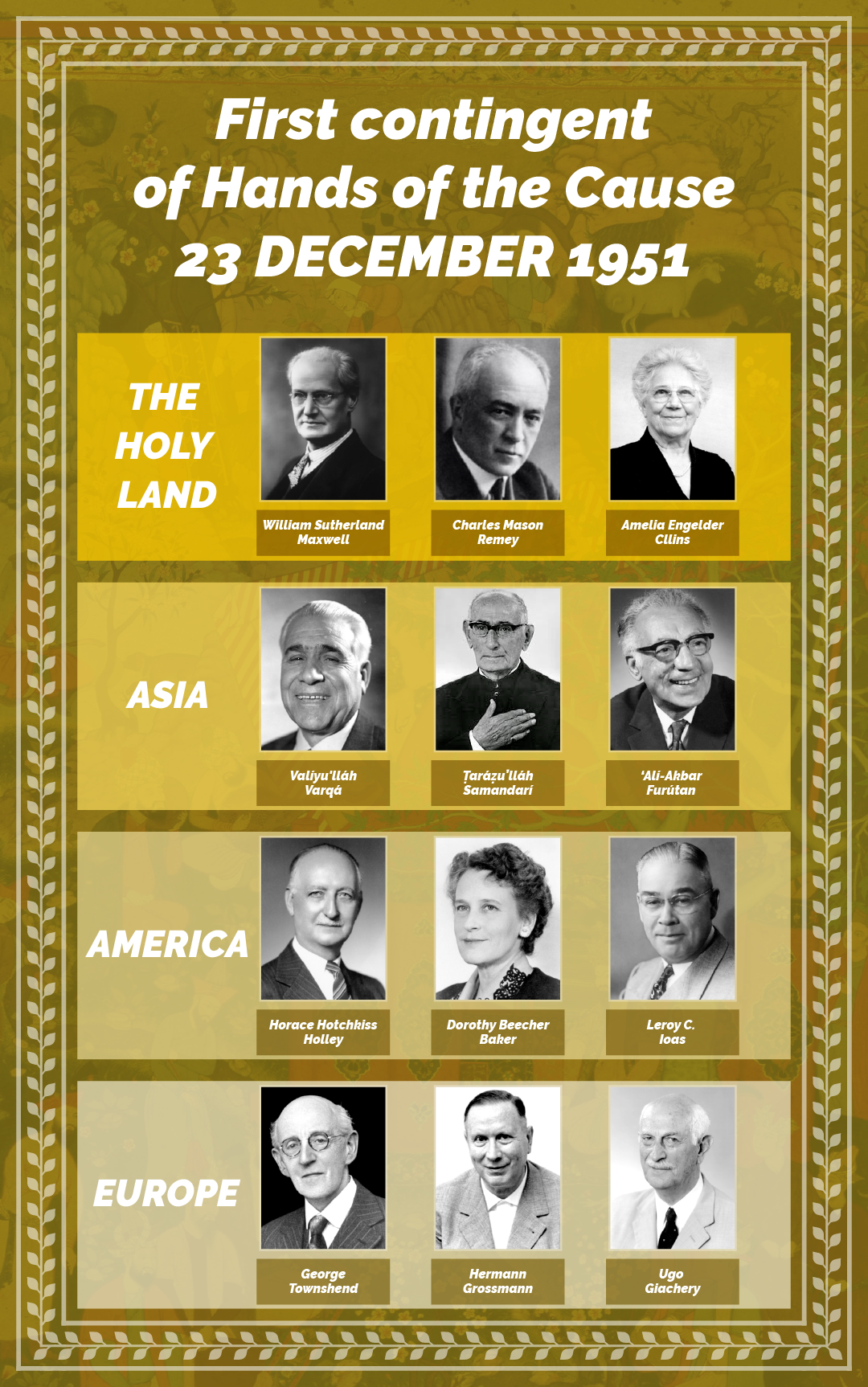
The remainder of the Guardian’s 24 December 1951 message was concerned with explaining the institution of the Hands of the Cause and appointing the Hands themselves.
The Guardian appointed three Hands of the Cause for each continent: the Holy Land, Iran, America, and Europe as the nascent appointed arm of Bahá'u'lláh’s Administrative Order, and 12 people’s lives changed forever.
On 23 December they were 12 exceptional Bahá'ís, talented speakers, skilled administrators, peerless teachers of the Cause and relentless defenders of the Faith.
On 24 December, these 10 men and 2 women and became an Institution: The Institution of the Hands of the Cause.
The Guardian explained that, just like the International Bahá'í Archives was a forerunner of the Universal House of Justice—the elected arm of Bahá'u'lláh’s Administrative Order—the Institution of the Hands of the Cause was a forerunner for the appointed branch—which we know today as the International Teaching Centre.
The Guardian did three things when he appointed the Hands of the Cause: He listed their names and continent assignments, he advised the 9 Hands of the Cause outside the Holy Land to not resign from their current positions, and lastly, he encouraged all the Hands of the Cause to attend as many of the upcoming intercontinental conferences during the Holy Year.
Nominated Hands comprise, Holy Land, Sutherland Maxwell, Mason Remey, Amelia Collins, President, Vice-President, International Bahá'í Council; cradle Faith, Valíyu'lláh Varqá, Ṭaráẓu'lláh Samandarí, `Alí-Akbar Furútan; American continent, Horace Holley, Dorothy Baker, Leroy Ioas; European continent, George Townshend, Hermann Grossmann, Ugo Giachery.
Nine elevated to rank of Hand in three continents outside Holy Land advised remain present posts and continue discharge vital administrative, teaching duties pending assignment of specific functions as need arises.
Urge all nine attend as my representatives all four forthcoming intercontinental conferences as well as discharge whatever responsibilities incumbent upon them at that time as elected representatives of national Bahá'í communities.
The list below, broken down first by continent, and then by Hand of the Cause follows exactly the order in which Shoghi Effendi lists the newly-appointed Hands in his message above:
THE HOLY LAND
William Sutherland Maxwell (1874–1952)
Charles Mason Remey (1874–1974)
Amelia Engelder Collins (1873–1962)
ASIA
Valíyu'lláh Varqá (1884–1955)
Ṭaráẓu’lláh Samandarí (1874–1968)
ʻAlí-Akbar Furútan (1905–2003)
AMERICA
Horace Hotchkiss Holley (1887–1960)
Dorothy Beecher Baker (1898–1954)
Leroy C. Ioas (1896–1965)
EUROPE
George Townshend (1876–1957)
Hermann Grossmann (1899–1968)
Ugo Giachery (1896–1989)
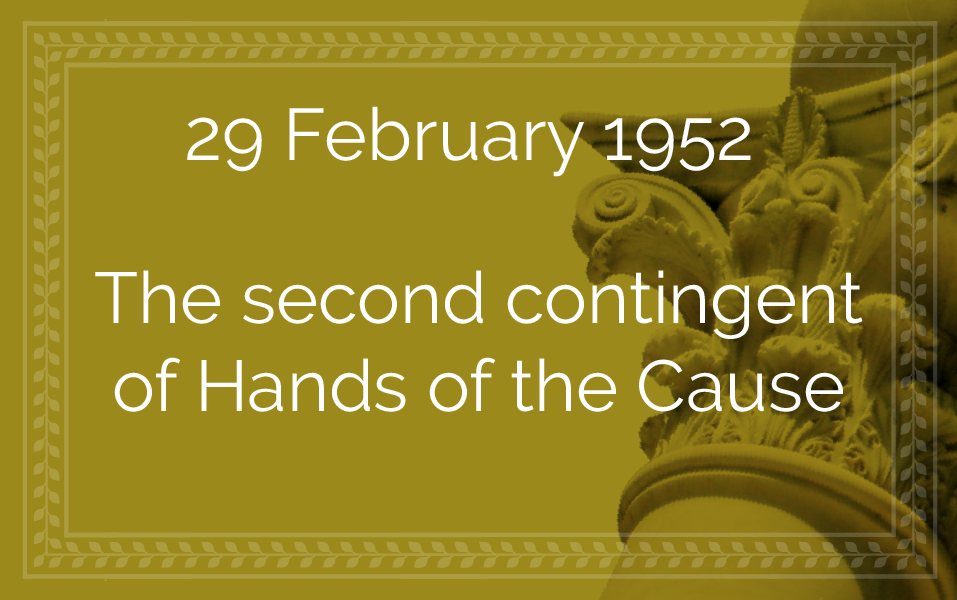

The second contingent of Hands of the Cause appointed by the Guardian on 29 February 1952. Background image: Persian miniature from The British Museum.
Exactly two months after the announcement of the first contingents of Hands of the Cause, the Guardian sent a second announcement on 29 February 1952, elevating seven more Bahá'ís to the rank of Hand of the Cause and bringing the total number of Hands of the Cause worldwide to 19.
The Guardian also announced that the institution of the Hands of the Cause was invested, in conformity with 'Abdu'l-Bahá's Testament, with the two-fold sacred duty of the propagation of the Faith and the preservation of its unity:
Announce friends East and West, through National Assemblies, following nominations raising the number of the present Hands of the Cause of God to nineteen. Dominion Canada and United States, Fred Schopflocher and Corinne True, respectively. Cradle of Faith, Dhikru’lláh Khadem, Shu’á’u’lláh ‘Alá’í. Germany, Africa, Australia, Adelbert Mühlschlegel, Músá Banání, Clara Dunn, respectively.
Members august body invested in conformity with ‘Abdu'l-Bahá's Testament, twofold sacred function, the propagation and preservation of the unity of the Faith of Bahá'u'lláh, and destined to assume individually in the course of time the direction of institutions paralleling those revolving around the Universal House of Justice, the supreme legislative body of the Bahá'í world, are now recruited from all five continents of the globe and representative of the three principal world religions of mankind.
After this announcement, the Guardian informed the Bahá'ís that Hands of the Cause for Canada and Africa had been instructed to take steps to establish national Bahá'í Centers. The list below, broken down first by continent, and then by Hand of the Cause follows exactly the order in which Shoghi Effendi lists the newly-appointed Hands in his message above:
CANADA AND THE UNITED STATES
Fred Schopflocher (1877-1953)
Corinne Knight True (1861-1961)
IRAN
Dhikru'lláh Khádim (1904-1986)
Shu'á'u'lláh ʻAlá’í (1889-1984)
GERMANY
Adelbert Mühlschlegel (1897-1980)
AFRICA
Músá Banání (1886-1971)
AUSTRALIA
Clara Dunn (1869-1960)
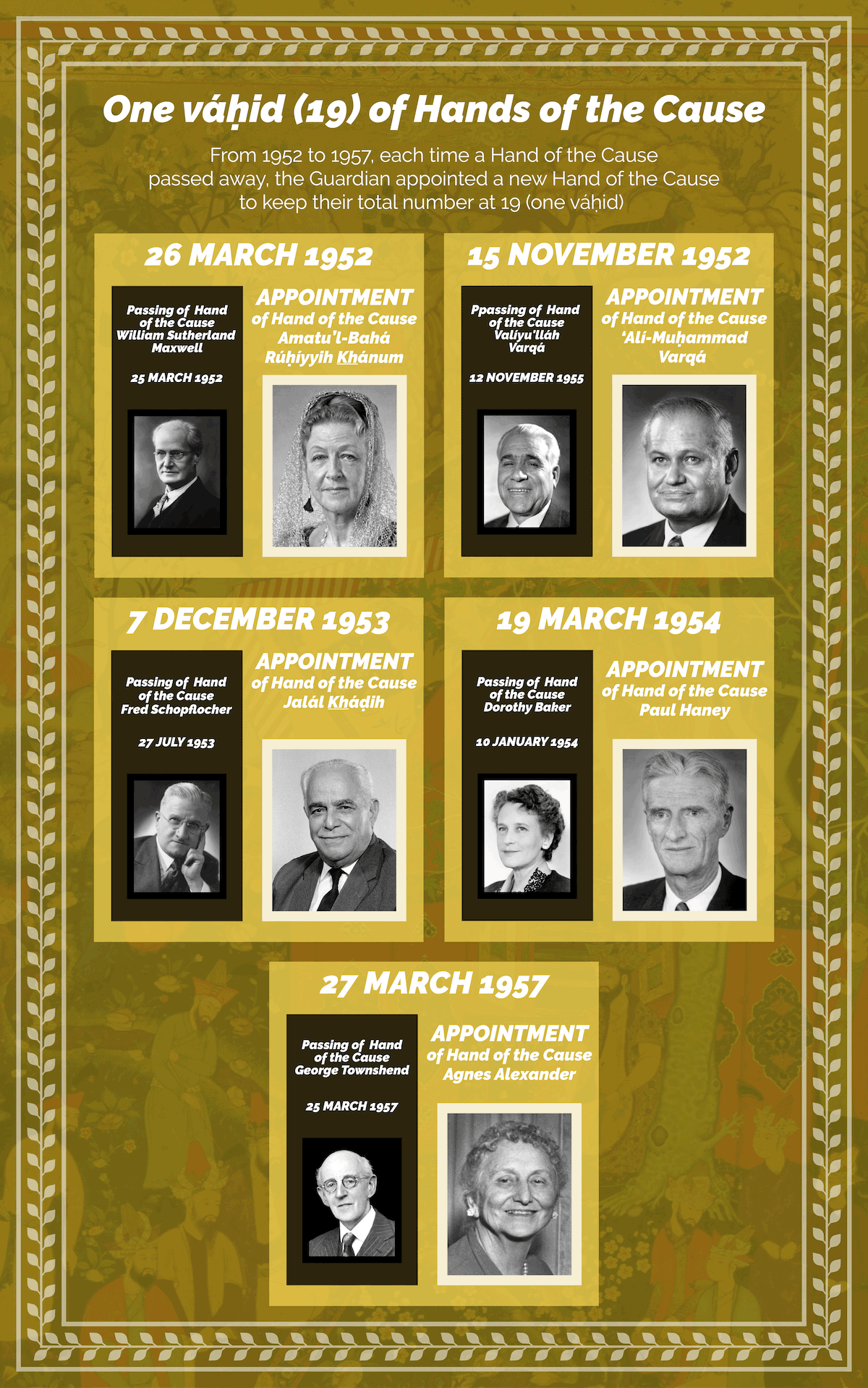
In a two-month period between December 1951 and February 1952, the Guardian appointed 19 Hands of the Cause. In Bahá'í terminology, the number 19 represents one Vaḥíd. One Vaḥíd is considered a unit.
The Guardian, considered this one Vaḥíd (19 Hands of the Cause) as a unit as well.
As far was the 19 living Hands of the Cause between 1952 and 1957, whenever a Hand of the Cause passed away, the Guardian appointed a Hand of the Cause to replace him or her and keep the number of Hands of the Cause to 19.
The Guardian raised two Hands of the Cause to the position which had been occupied by their respective fathers:
- On 26 March 1952, The Guardian appointed Amatu’l-Bahá Rúḥíyyih Khánum as a Hand of the Cause, after the death of her father, Hand of the Cause William Sutherland Maxwell on 25 March 1952.
- On 15 November 1955, ‘Alí-Muḥammad Varqá was appointed to succeed his father, Valíyu'lláh Varqá, who passed away on 12 November 1955. The Guardian also made ‘Alí-Muḥammad Varqá the trustee of the Ḥuqúqu’lláh—as his father had been before him.
Three Hands of the Cause passed away between 1953 and 1957, and the Guardian raised three individuals to the rank of Hand of the Cause after their deaths.
- Following the passing of Fred Schopflocher on 27 July 1953, the Guardian appointed Jalál Kháḍih as Hand of the Cause on 7 December 1953;
- After Dorothy Baker was killed in a plane crash on 10 January 1954, the Guardian made Paul Haney a Hand of the Cause on 19 March 1954;
- Shortly after George Townshend’s death on 25 March 1957, the Guardian appointed Agnes Alexander a Hand of the Cause on 27 March 1957.
The living Hands of the Cause would remain at 19 until 1957, when, with the addition of 8 new Hands of the Cause, their number rose to 27.
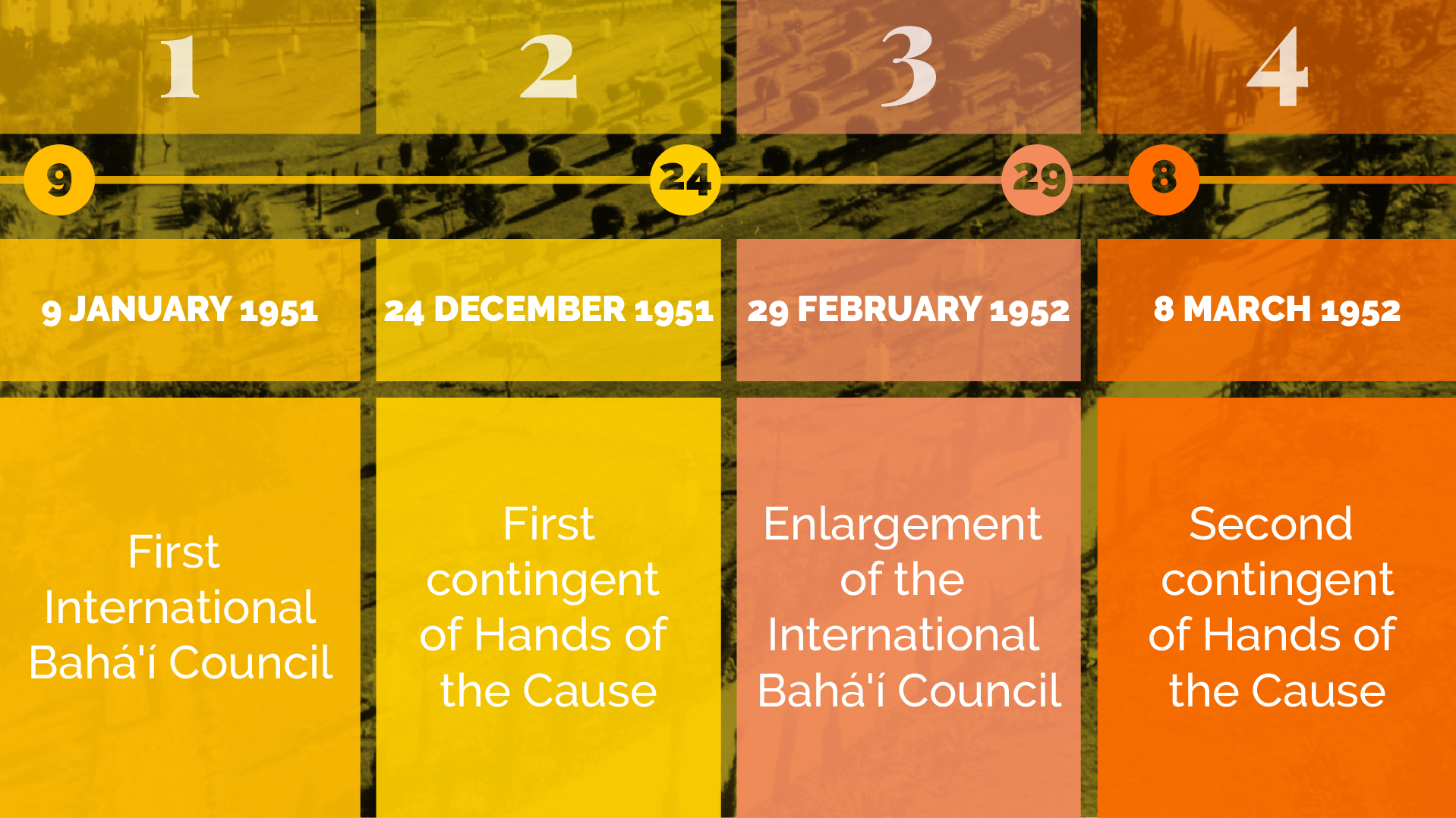
Four far-reaching changes in the international institutions of the Bahá'í Faith which the Guardian instituted in a short period of 13 months between January 1951 and March 1952.
Between January 1951 and March 1952, the Guardian set in motion four far-reaching changes at the Bahá'í World Centre in rapid succession:
- On 9 January 1951, he announced the formation of the first International Bahá'í Council;
- On 24 December 1951, he appointed the first contingent of 12 Hands of the Cause;
- On 29 February 1952, he appointed the second contingent of 7 Hands of the Cause;
- On 8 March 1952, he enlarged the membership of the International Bahá'í Council.
The Guardian described this evolution in the Administrative Order of the Faith as the erection of "the machinery of its highest institutions", "the supreme Organs of its unfolding Order" which were now, in their "embryonic form" developing around the Holy Shrines.
The Guardian had explained to the Bahá'í world that Bahá'u'lláh’s Administrative Order was guided by the directives and spiritual powers released in the three Charters of the Administrative Order:
- The Tablet of Carmel, revealed by Bahá'u'lláh on Mount Carmel;
- 'Abdu'l-Bahá’s Will and Testament;
- The Tablets of the Divine Plan, revealed by 'Abdu'l-Bahá;
The charter of the Tablet of Carmel embodied the development of the Bahá'í World Centre in the Holy Land, which, as he stated was "geographically, spiritually and administratively, constitutes the heart of the entire planet," "the Holy Land, the Centre and Pivot round which the divinely appointed, fast multiplying institutions of a world-encircling, relentlessly marching Faith revolve," "the Holy Land, the Qiblih of a world community, the heart from which the energizing influences of a vivifying Faith continually stream, and the seat and centre around which the diversified activities of a divinely appointed Administrative Order revolve."
The theater of operations of the Charter of the Tablet of Carmel was the Bahá'í World Centre on Mount Carmel, and the hub around which the Tablet of Carmel was itself centered were these words of Bahá'u'lláh: "ere long will God sail His Ark upon thee and will manifest the people of Baha who have been mentioned in the Book of Names."
The People of Bahá, the Guardian explained, were none other than the members of the Universal House of Justice.
The Charter of the Will and Testament of 'Abdu'l-Bahá was directed the erection of the administrative institutions of Bahá'u'lláh’s Administrative Order: the National Spiritual Assemblies, Local Spiritual Assemblies, the Institution of the Hands of the Cause and the Auxiliary Board Members. The theater of operations of this Charter was the world itself.
The Charter of the Tablets of the Divine Plan was the spiritual conquest of the entire planet, the propagation of the teachings of Bahá'u'lláh in every corner of the globe. Same was with the Will and Testament of 'Abdu'l-Bahá, the Charter of the Tablets of the Divine Plan was the entire world.
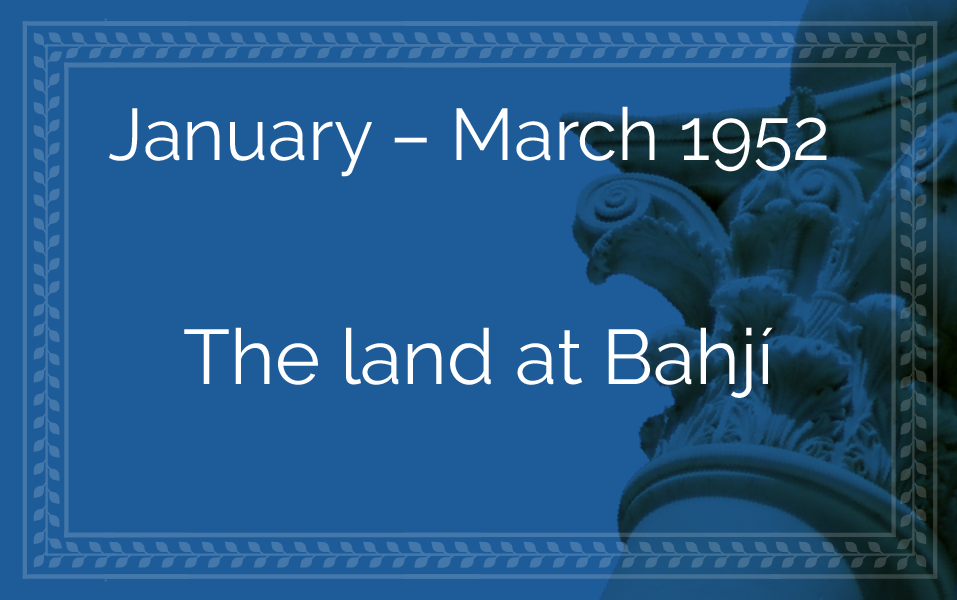

The house of 'Abdu'l-Baha in Haifa where Shoghi Effendi lived for half a century and whence, for thirty-six years as Guardian he administered the affairs of the Baha'i Faith. The two rooms where the Guardian lived and worked were added on to the roof; in 1937 three more were added. Originally printed in The Bahá'í World Volume 13, page 150. Source: Bahaimedia.
In the course of a talk in Johannesburg, South Africa in 1978, Leroy Ioas gave a detailed description of what a day in the life of the Guardian was like. These were his days for weeks on end, and they go a long way in explaining why Shoghi Effendi could not rest in Haifa, and why he had to seek solace, once a year, in his beloved Bernese Alps in Switzerland.
Shoghi Effendi usually woke up around 5:30 AM, and after his morning devotions and meditation, he turned his attention to piles and piles of letters, cables and telegrams, sometimes from the day before, along with those which had just arrived that morning.
As he went through his mail, a process that took hours every single day, Shoghi Effendi made notes on each letter regarding how it should be addressed. The Guardian opened every single letter that was addressed to him, he never delegated this task to anyone.
Sometimes Shoghi Effendi gave the letters either to Rúḥíyyih Khánum or to Leroy Ioas to respond, and those that needed to be answered in Persian, he gave to his Persian secretary, Dr. Luṭfu’lláh Ḥakím.
One evening, he told Leroy Ioas:
Today I received 700 pages of minutes and records from different parts of the world, and I had to read them all.
Of course that volume was unusual, but what was a daily occurrence were the hours and hours of reading the Guardian had to do, not just personal letters or letters from National Spiritual Assemblies but minutes of various committees and Assemblies.
Every afternoon, Shoghi Effendi went up to the gardens of the Shrine of the Báb on Mount Carmel, and met the eastern Pilgrims, walking with them in the gardens, speaking with them, having tea with them, and answering their questions. The Guardian spoke to them in Persian or Arabic about the Faith and its worldwide progress, particularly in the east. Then, the Guardian would accompany them to the Shrine of the Báb, and chant the Tablet of Visitation. And after this, he would drive back down the mountain to the House of the Master, and continue his work with his voluminous correspondence, answering the cables that streamed in throughout the day as they came.
Every evening, Shoghi Effendi would have dinner with the western pilgrims in the Western Pilgrim House, and the members of the International Bahá'í Council, and he would speak to them about the progress of the Faith in their countries, speaking to them in English. The Guardian would ask a pilgrim from Canada, for example:
Well, how is the Cause developing in Canada? How is it progressing? How many centers do you have? How many spiritual assemblies do you have? And how many groups do you have?
The pilgrims would invariable answer:
Well, Shoghi Effendi, I don’t know.
And the Guardian would respond:
It didn’t matter which country, Canada, or Swaziland, the Guardian carried the most recent, most up-to-date statistics in his mind at all times. He could rattle off the exact number of Local Spiritual Assemblies, the number of centers were Bahá'ís lived, or the spiritual condition of the Bahá'í community, at any point, for any part of the world.
So he would talk to each and every one about their own country, about the conditions there, about the social conditions, about the problems under which they worked, and give them hope and encouragement and guidance and instructions.
Shoghi Effendi didn’t have secrets, he spoke with the members of the International Bahá'í Council about the affairs of the Council in front of the pilgrims. And the advice the Guardian gave the members of the International Bahá'í Council was infallible. If they couldn’t solve a problem, he would advise to talk to a certain person, and when they did, the issue was immediately resolved.
After dinner, the Guardian would return to his office to do a few more hours of work, sleeping around midnight each night. This was a typical day for the Guardian, from Monday to Sunday, from 5:30 in the morning to 11:30 at night and sometimes even 3:00 AM, continually burdened, constantly under pressure, always snowed under a mountain of hundreds of letters, day after day, week after week, month after month, for a year.

Colorized portrait of 'Abdu'l-Bahá taken in Paris. In October 1911. Source: Bahá'í Media Bank, © Bahá'í International Community 2023.
Two of Shoghi Effendi’s most distinctive qualities were his humility and his reverence towards the Central Figures of the Faith. This story illustrates both.
Shoghi Effendi never spoke of himself, and never, ever, made reference to his ministry or his Guardianship. He would never say in the time of the Guardianship, but rather in the days after 'Abdu'l-Bahá. When he wrote God Passes By, he never mentioned himself, although the part of God Passes By on the Formative Age of the Faith is equivalent to the time of his Guardianship.
One day, Leroy Ioas was speaking to Shoghi Effendi and made a grave mistake. He mentioned Shoghi Effendi’s name in the same sentence and in the same vein almost as 'Abdu'l-Bahá, and the Guardian stopped him in his tracks, immediately saying:
Don’t ever do that. Don’t ever mention my name in the same breath as you mention the Master. The Master was like the ocean; I am like a drop. The Master was like the sun; and I am like an atom. So don’t ever, ever mention my name in the same theme or same trend of thought as that of the Master. There is a vast gulf between Abdu’l-Bahá and all the rest of creation, and between the Guardian.

June 1843 Reproduction of Plan of Environs of 'Akká by Lieutenant Symonds & Skyring, showing Bahjí at the top center of the map. Source: Archives of Israel.
The Guardian, from the very beginning of his ministry, had always considered protecting and beautifying the Bahá'í Holy Shrines as one of his sacred tasks, but his most preoccupying issue was that the Bahá'í Faith did not own any of the land around Bahjí.
The piece of land the Guardian desperately needed was a 40-acre plot of land owned by the Baydún family, Muslims with close ties to the Covenant-breakers. Their hatred was so entrenched that the Baydún family would not even entertain the possibility of selling land to the Guardian and the Bahá'í Faith. Over time, the Baydúns even dug ditches around the Shrine and planted trees blocking its view.
In the 1880s, Bahá'u'lláh, then still a Prisoner in 'Akká, had directed 'Abdu'l-Bahá to purchase properties near the Sea of Galilee and the Jordan River, including one 35-acre piece of land registered to the name of a descendent of Mírzá Músá’s, Dhikru’lláh, and which was now in the hands of his eldest son, a faithful Bahá'í.
After 1948 and Israel’s independence, the Baydún family was among the 700,000 Arabs who fled the new country, and the Bahjí property they left behind reverted to the state of Israel.
By 1952, the Dhikru’lláh property had become immensely valuable.
It was strategically located between Syria and the West Bank, and the State of Israel was desperate to purchase these 35 acres. Initially, Shoghi Effendi refused to sell the property because 'Abdu'l-Bahá had asked the Bahá'ís to keep the land, but someone suggested exchanging this valuable property for the abandoned Baydún land around the Shrine of Bahá'u'lláh.
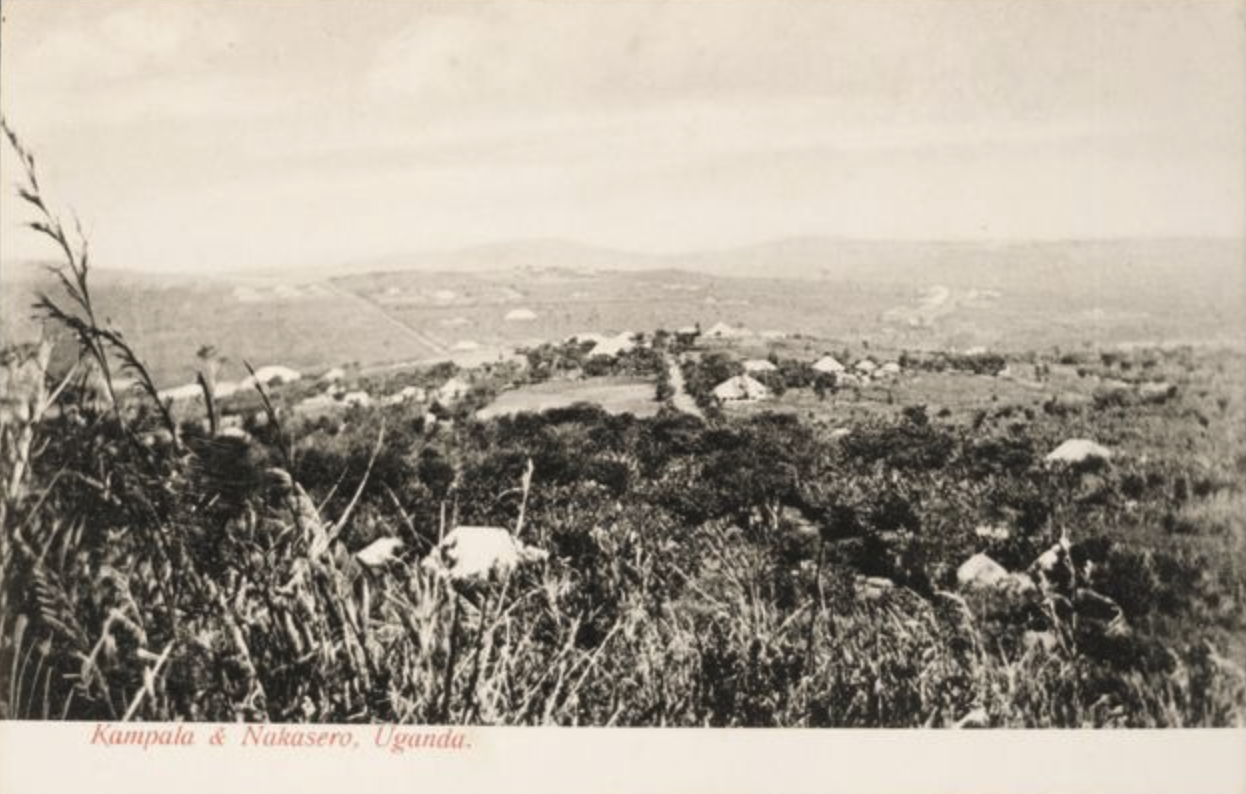
A vintage postcard of Kampala and Nakasero, Uganda. Source: Northwestern Libraries and Digital Collection.
18 years after their first pilgrimage and one year after settling in Kampala, Uganda, Músá and Samíhíh Banání returned for a second pilgrimage in February 1952. Before leaving Kampala, they had agreed with the Bahá'í pioneers that they would hold a special meeting with African seekers while the Banánís were in Haifa, a meeting that would coincide with the appointed time during which Shoghi Effendi visited the Shrines.
The teaching work in Africa was growing exponentially, and Shoghi Effendi was so thrilled with their work and the work of Violette and ‘Alí Nakhjávání, that their reunion with their Guardian was an especially joyful one, and during each day of their pilgrimage, the Guardian gave the Banánís detailed instructions for the development and growth of the Faith in Africa.
At the same time the meeting in Kampala was being held with the African seekers, Shoghi Effendi and Músá Banání prayed together at the Shrines for the progress of the Faith. The next morning was when Enoch Olinga declared his belief in Bahá'u'lláh. By 21 April 1952, there were enough Bahá'ís in Kampala to elect the first Local Spiritual Assembly, and six months later, by October 1952, there were 100 Bahá'ís in Uganda.

Hand of the Cause Músá Banání (seated third from left in the second row) at a deepening school in Kabras, Kenya in 1960. Originally published in Baha'i News Issue 335, page 5. Source: Bahaimedia.
On 29 February 1952, the last day of his pilgrimage, the Guardian informed Músá Banání that he had been elevated to the rank of Hand of the Cause and called him “the spiritual conqueror of Africa” in the cable he had sent the Bahá'í world.
Músá Banání, who was illiterate, protested with his characteristic humility:
I am not worthy. I cannot read or write. My tongue is not eloquent. Give this mantle to ‘Alí Nakhjávání who is doing the lion's share of teaching in Africa.
Shoghi Effendi replied:
It is your arising that has conquered the continent ‘Alí’s turn will come.

Colonel Jalál Kháḍih. Source: Bahaimedia.
Jalál Kháḍih was born into a Bahá'í family in Ṭihrán on 24 February 1897—the same year as the Guardian—and lost his father at the age of 7 because of complications from torture and persecution he had endured in his hometown of Sidih, near Iṣfahán. Jalál Kháḍih completed his compulsory military service in the Persian Army and studied veterinary science at Military Academy.
By the time Jalál Kháḍih was 19, had earned the rank of Lieutenant and married Jamálíyyih Kashání. Together, Jalál and Jamálíyyih had five children, two sons and three daughters, and the family traveled all around Iran for Jalál Kháḍih’s military career, as he was stationed in many cities like Qazvín, Hamadán, Kirmánsháh, Sanandaj, Khurramabád, Burujird, and Ahvaz.
When he retired at the age of 46 in 1943, Jalál Kháḍih was a Colonel, and the next year, in 1944, he was elected on the National Spiritual Assembly of Iran. And then, Jalál Kháḍih went on pilgrimage and met the Guardian. His life would change forever.
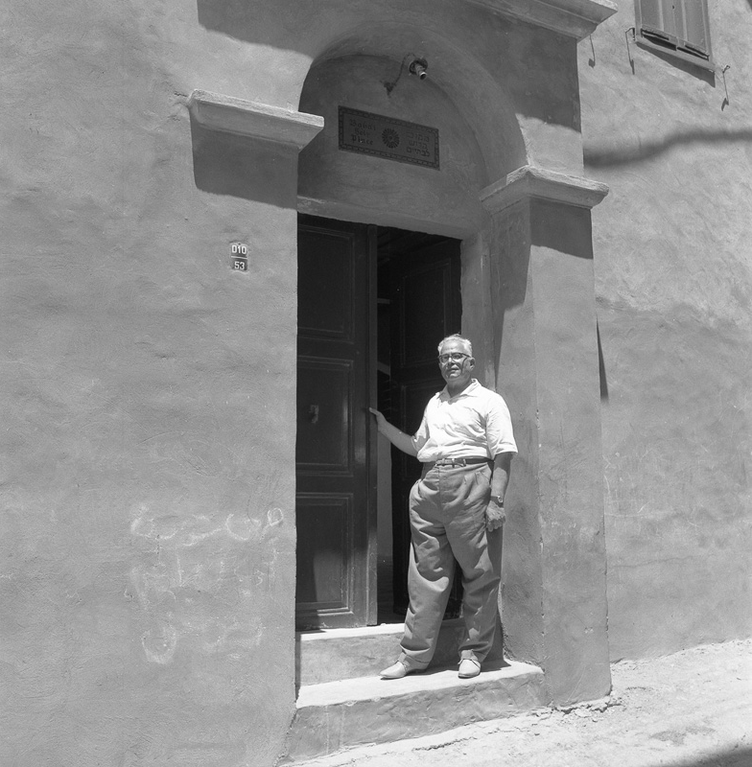
Jalál Kháḍih at the House of ‘Abbúd. Source: Bahaimedia.
The first time Jalál Kháḍih met Shoghi Effendi was during his pilgrimage in March 1952. Jalál Kháḍih, often described himself as a “new creation,” after meeting the Guardian. Entering into Shoghi Effendi’s presence and learning from him for the duration of his pilgrimage was a watershed event in his life: there was a before-the-Guardian Jalál Kháḍih, and an after-the-Guardian Jalál Kháḍih. The following story is one Hand of the Cause Jalál Kháḍih himself used to tell at summer schools.
When Jalál Kháḍih was on pilgrimage, the Guardian himself took the pilgrims to the Shrine of the Báb. The Guardian went forward and placed his head on the threshold, and after a while, he stood up and started walking backwards out of the Shrine. Jalál Kháḍih did not know the protocol for this situation: should he face the Guardian of the Cause of God, walking backwards out of the Shrine or should he face the threshold of the Shrine, and, as one person remembers him saying it, he “half-halfed it,” fumbling and turning somewhere in between the Guardian and the threshold of the Shrine.
When Jalál Kháḍih finally came out of the Shrine, the Guardian was standing there, looked at him and told him:
All of the messengers of God, all the prophets of old are circumambulating this sacred spot.
Jalál Kháḍih realized that he should have faced the threshold. After a short while, the Guardian turned and started walking, the pilgrims following behind. As Shoghi Effendi was walking, Jalál Kháḍih began to think
If all the of the messengers of God, the prophets of old are circumambulating here, then what is happening in Bahjí?
Jalál Kháḍih always said that the very moment that thought entered his head, the Guardian turned around, looked at him straight in the eye and said:
And all of the messengers of God, all the prophets of old, and the soul of the Báb, in turn, are circumambulating the Shrine of Bahá'u'lláh.
Before leaving the Guardian, Jalál Kháḍih secured his approval regarding his plan to resign from the Local Spiritual Assembly of Ṭihrán after having served on it for three years, and travel Iran full time to teach the Faith.

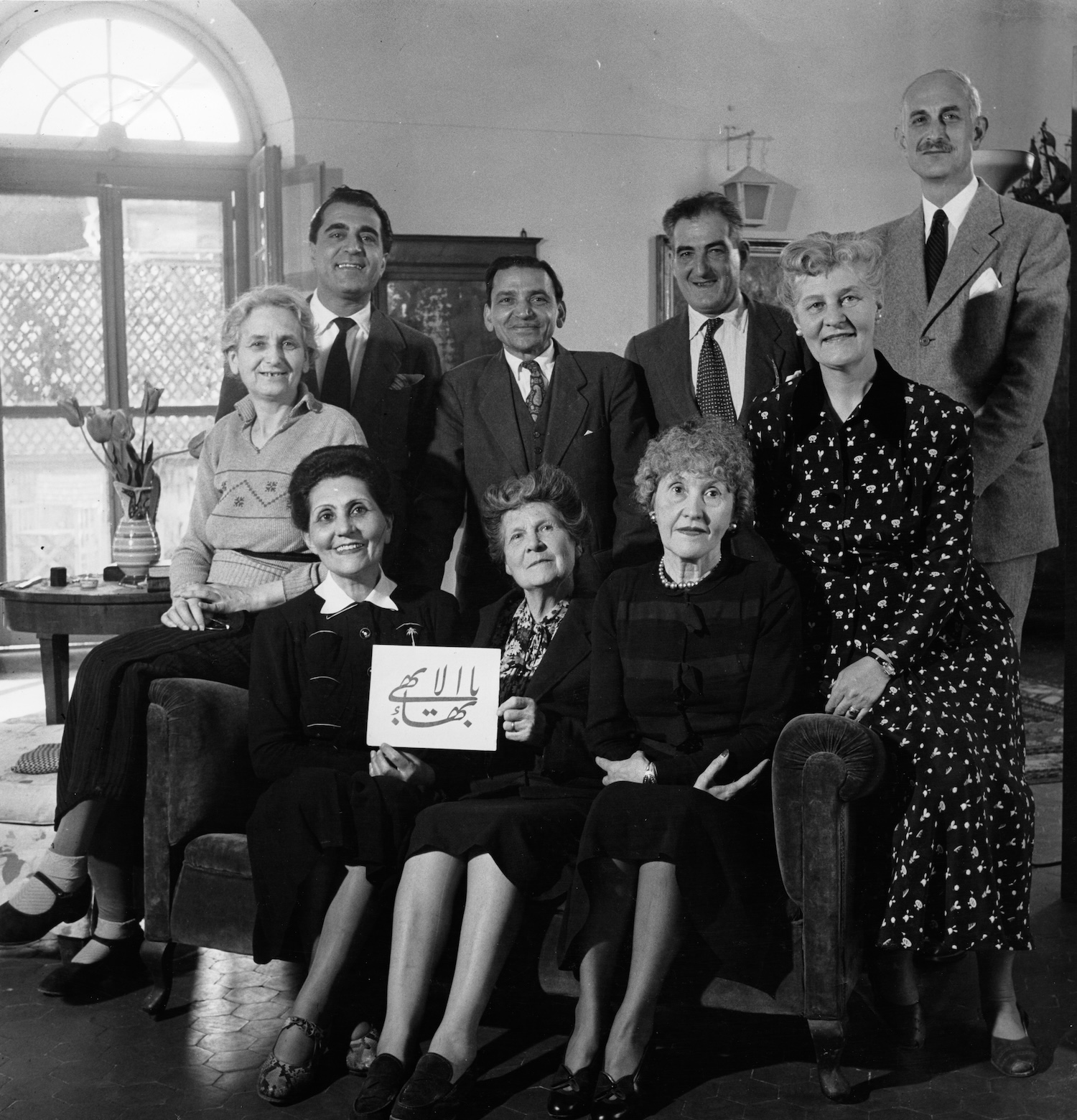
This is the first Baha’i institution in Italy, the Local Spiritual Assembly of Rome, in 1948. Hand of the Cause of God Ugo Giachery is standing on the far right and was a member of the Local Spiritual Assembly. Source: Bahá'í World News Service.
As the Guardian’s legal trial against the Covenant-breakers brought against him after his destruction of a worthless dilapidated building approached, Shoghi Effendi called Ugo Giachery on pilgrimage to assist him during the time of the trial. Unfortunately for Ugo Giachery, this meant that he would be an eyewitness to the shameful behavior of the Covenant-breakers.
Ugo Giachery met Shoghi Effendi for the first time when he arrived for his first pilgrimage and consultation on 4 March 1952, a little over two months after having been appointed a Hand of the Cause. The custom was to let the newly-arrived pilgrim precede everyone else into the dining room of the western Pilgrim House, an oval-shaped room, and Ugo Giachery saw the Guardian for the first time.
Shoghi Effendi was sitting at the far end of the table—never the head of the table, which he reserved for guests he wished to honor—and he was wearing a dark steel-grey coat and a. a black fez. He lifted his head and met Ugo Giachery’s eyes with a luminous, penetrating gaze, rose to greet his Hand of the Cause with a broad smile, illuminating his face. At dinner, Shoghi Effendi told everyone at the table:
We are very glad to have such a Bahá'í friend, to whom the whole world is indebted.
Then, addressing Ugo Giachery, he added:
The service you have rendered is not sufficiently appreciated today, but it will be fully appreciated in the future…You see, you worked for so long all alone; and no one appreciates this more than I, myself. When you are alone, you have such a big weight to carry. Single-handed, you have rendered an historic service to the Cause…This evening when I went to the Shrine, I remembered you, and I have come to the decision that we shall have a “Giachery” door for the Shrine—one of the doors.
The Guardian gave a little background regarding how 'Abdu'l-Bahá had purchased land for the Shrine of the Báb, and how much He had suffered building it, and the difficulties Jamál Pashá had caused, then, he turned to Ugo Giachery again and said:
You are one of the three—Sutherland [William Sutherland Maxwell], myself and you. Sutherland rendered services in connection with the Shrine which are most meritorious - more meritorious than anything I have done - more meritorious than anything Ugo has done.
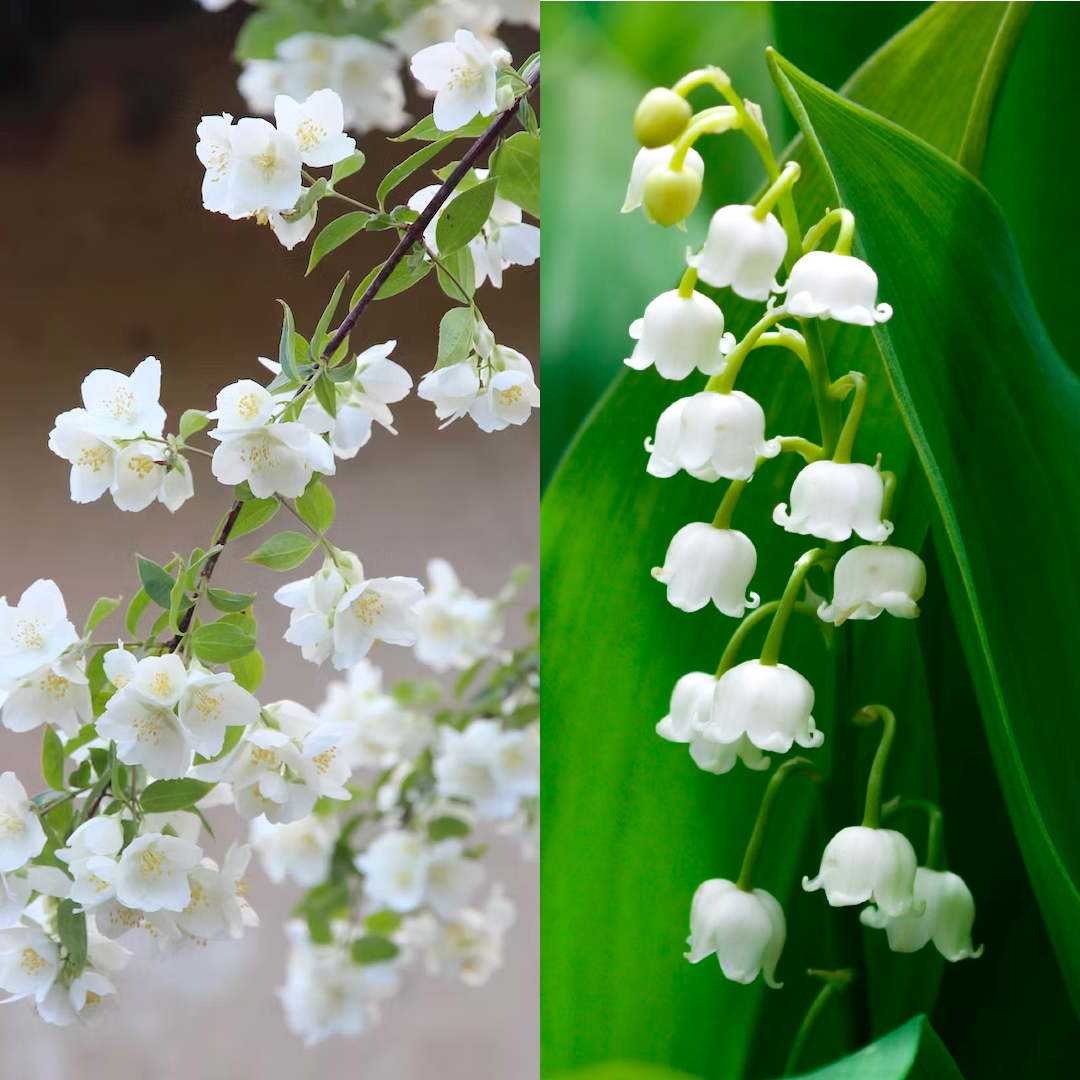
Jasmine flowers, Shoghi Effendi’s favorite scent. Photo by Dagmara Dombrovska on Unsplash. Lilies of the Valley, Shoghi Effendi’s favorite flower. Photo by Océane George on Unsplash.
One night in early spring—we do not know the year—Ugo Giachery had the privilege of staying one night in the Mansion of Bahjí at the same time as Shoghi Effendi was there. In the Mansion of Bahjí there is a small garden, bordered by a stone wall which is so beautiful it is like a small corner of paradise here on earth.
It had sorely been neglected during the 40 years the Covenant-breakers had sullied Bahjí, but Shoghi Effendi had revived the garden and planted trees, shrubs, and flowers all around, and when you entered it, you could smell loveliness coming from all directions: the exquisite scent of orange blossoms, the earthy smell of the geraniums, sweet roses, and several varieties of jasmine.
When Ugo Giachery entered the garden, he was almost overtaken by the fragrances, which he described as a “heavenly nectar.” Before leaving Bahjí that day, Ugo Giachery gathered some jasmine blossoms and put them in a small vase which he placed in front of the Guardian’s seat at the dinner table.
The Guardian didn’t speak. He was not only pleased but deeply moved, and searched Ugo Giachery’s eyes with his luminous gaze, then smiled, raised the jasmine bouquet to his nose and inhaled the heavenly scent with visible delight.
Ugo Giachery later learned that jasmine was the Guardian’s favorite scent. Interestingly, lilies of the valley, those beautiful, tiny, bright-white bell-shaped fragrant wildflowers, were Shoghi Effendi’s favorite flower.
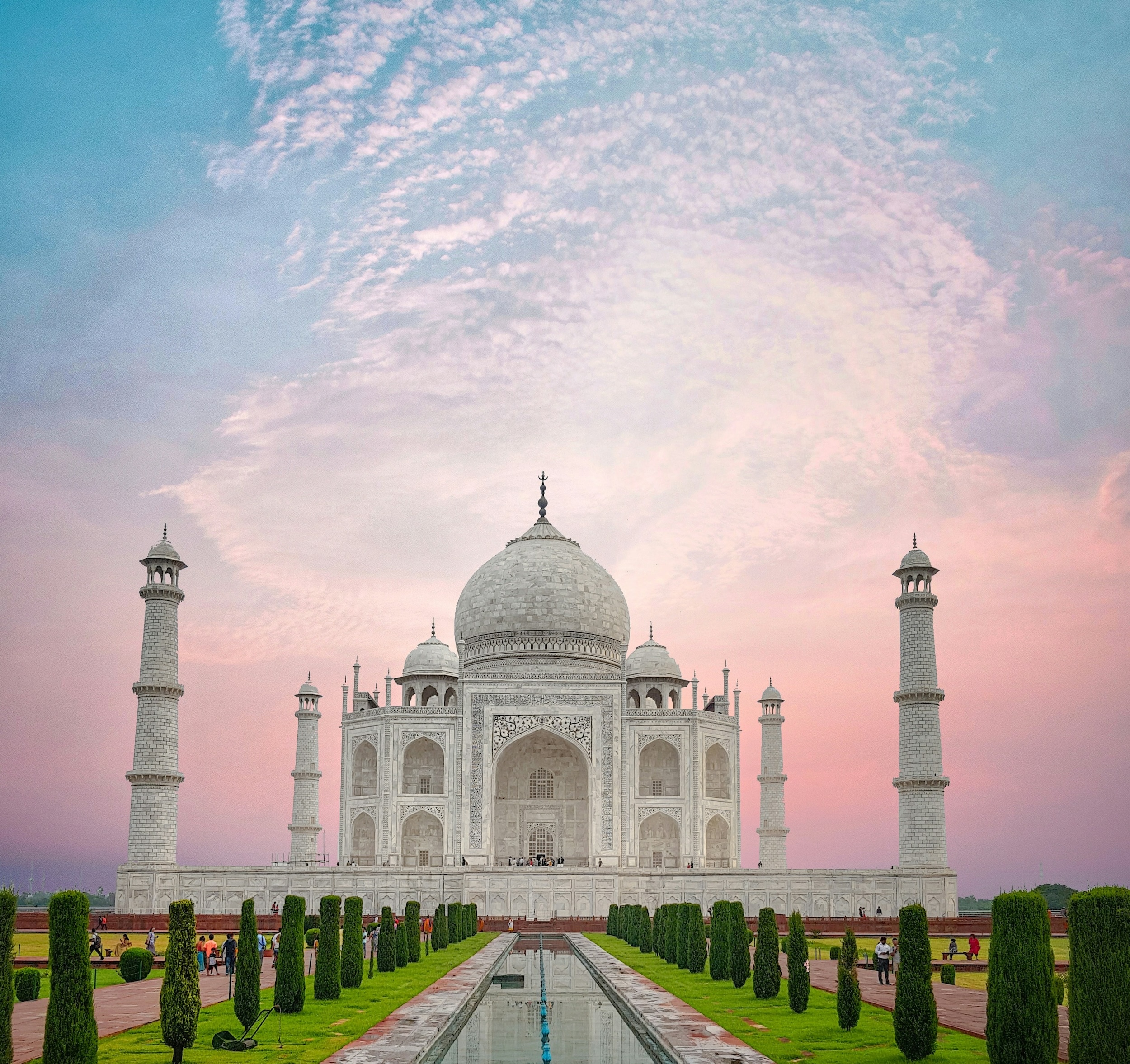
No drawings were found of Shoghi Effendi’s planned superstructure for the Shrine of Bahá'u'lláh, but his descriptions of a monumental, exquisite monument brought to mind another monumental timeless structure: The Taj Mahal of Agra, India. Photo by Shamees Cm on Unsplash.
When Ugo Giachery was visiting the room used by 'Abdu'l-Bahá at the Pilgrim house in Bahjí, he was shown a large number of architectural drawings and other papers, contained in a wooden coffer which had been untouched for 50 years.
Many of the papers and drawings were written and illustrated in Italian, and they concerned the project of a monumental final Shrine for Bahá'u'lláh, the work of an Italian engineer and architect, Henry Edward Plantagenet— a descendant of the English Royal Family which ruled from 1154 to 1485. Henry Edward Plantagenet was born and lived in Florence, Italy, and he had been commissioned by the Ottoman Government to build the Syrian railroad, and so had lived in Syria for a number of years.
The plans indicated that a member of Bahá'u'lláh’s family had sked him to draw the plans for the superstructure of the Shrine of Bahá'u'lláh, and he had obviously been inspired by Bábí concepts because the monument was a large, five-pointed star, the symbol of the Báb. This was not 'Abdu'l-Bahá’s plan, the Master had a different concept in mind for the final Shrine of Bahá'u'lláh.
At dinner that night, Ugo Giachery spoke of the Italian designs with Shoghi Effendi, and praised the facades of the current Shrine, very happy to hear from the Guardian that he, too, had no intention of altering the natural, simple beauty of the current Shrine, but explaining to Ugo Giachery what 'Abdu'l-Bahá’s vision was:
The building as fortified by Abdu'l-Bahá will not be touched; it will remain as the core of the new structure to surround the whole area, an inestimable gem representing the focal point of adoration for all the present and future followers of Bahá'u'lláh.
Shoghi Effendi called the superstructure of the Shrine of Bahá'u'lláh a mere ornamentation, saying it was “only an embellishment,” as the great Shrine, “of untold magnificence, would be erected in future decades.”
Shoghi Effendi was considering different ways of making 'Abdu'l-Bahá’s vision a reality, including surrounding the original Shrine with a colonnade of 95 monolithic Doric columns of Carrara marble surmounted by exquisite Doric capitals. He envisioned the columns arrayed in pairs, one on each side of a walkable pathway on a platform of Carrara marble, accessible by five steps, and he described his vision of the colonnade as “arms stretching ready to embrace.”
For several nights, Shoghi Effendi spoke about the superstructure to the Shrine of Bahá'u'lláh. He asked Ugo Giachery about various types of statuary marble—of course the Guardian’s preference was the best of the best, the king of all marbles, the glowing white Carrara marble used since Roman times. Shoghi Effendi also asked Ugo Giachery about the logistics for producing immense monolithic columns out of marble, and questioned Ugo Giachery—who had phenomenal knowledge—about the various types of historic triumphal commemorative or honorific monuments.
The Guardian explained that the 95 columns should be 6 meters tall, each supporting a carved capital, the total weight of which would be close to a ton, and with the height of the column base, each column would soar 7 meters into the air, not including the five steps, which would add to the height. In the Guardian’s mind, it was a formidable complex of brilliant majesty, that would glorify and enshrine the current precious Shrine of Bahá'u'lláh.
It was important for the Guardian that Ugo Giachery to secure an architectural plan based on his detailed descriptions as soon as possible.
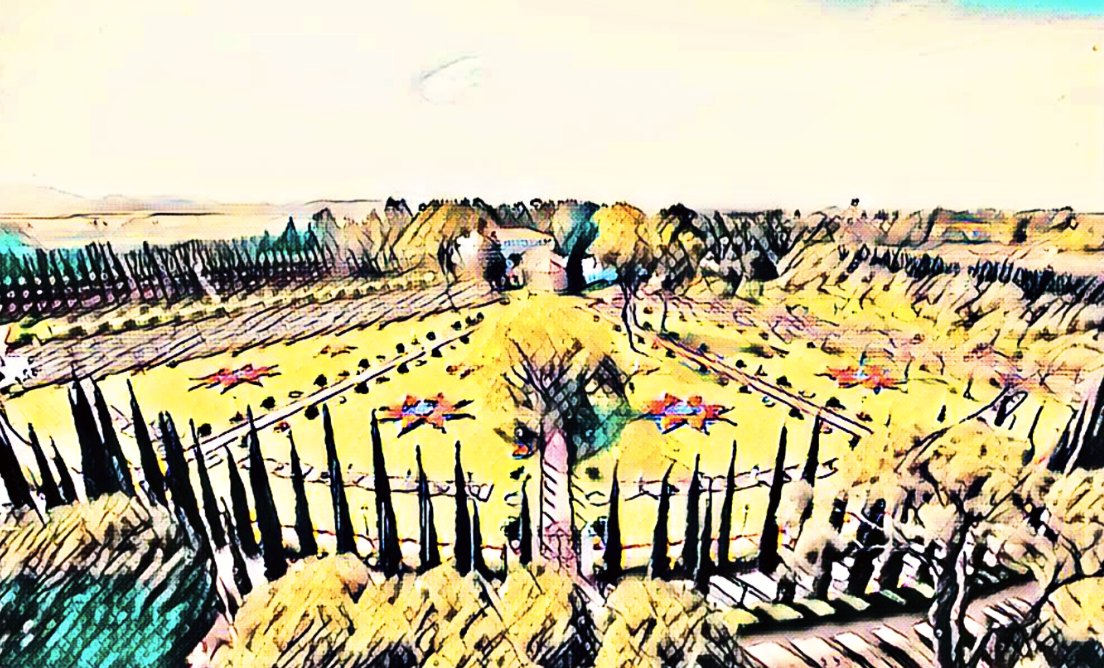
Shoghi Effendi describes his vision for the gardens at Bahjí to Ugo Giachery on 4 March 1952. A photograph of the completed gardens transformed into a drawing using the website Picsart. Image inspiration: Bahá'í Media Bank, © Bahá'í International Community 2023.
When Ugo Giachery was on pilgrimage between March and July 1952, the Guardian had spoken to him at length regarding his plans to embellish the Shrine of Bahá'u'lláh and beautify the land around it, the Ḥaram-i-Aqdas. Shoghi Effendi commissioned Ugo Giachery to secure drawings and estimates of these plans as soon as he was back in Italy. On their first dinner, the first evening of Ugo Giachery’s pilgrimage, Shoghi Effendi turned to him and said:
When the dome [of the Báb's Shrine] is finished, your work is not finished. We cannot hope to build the Shrine of Bahá'u'lláh now - that is impossible - but we can do something intermediate. The Master added a wall around to reinforce the original room. We cannot leave it for an indefinite time in this manner.
Then, turning to Larry Hautz—an American pilgrim who would stay to assist Leroy Ioas for 90 days with purchasing land for the Guardian— he added:
If you succeed in getting this land around the Shrine - it is very extensive - it will be a great blow to the Covenant-breakers. You will not only have dealt them a terrible blow, but you will have paved the way for the construction of what is going to be the intermediate stage between the present structure of the Shrine of Bahá'u'lláh and the final building, which will be on a scale far greater than the Shrine of the Báb.
Towards the end of the evening, the Guardian returned to the subject of land, and spoke of extending Bahjí:
We expect to get fifty acres at Bahjí [permitting] avenues one hundred metres long, all smooth paths converging; we shall keep on building it, we shall build around it: a semicircular, double colonnade with columns all of marble. Preferably ninety-five in number, white, with ornaments, flower-beds, lawns and hedges.
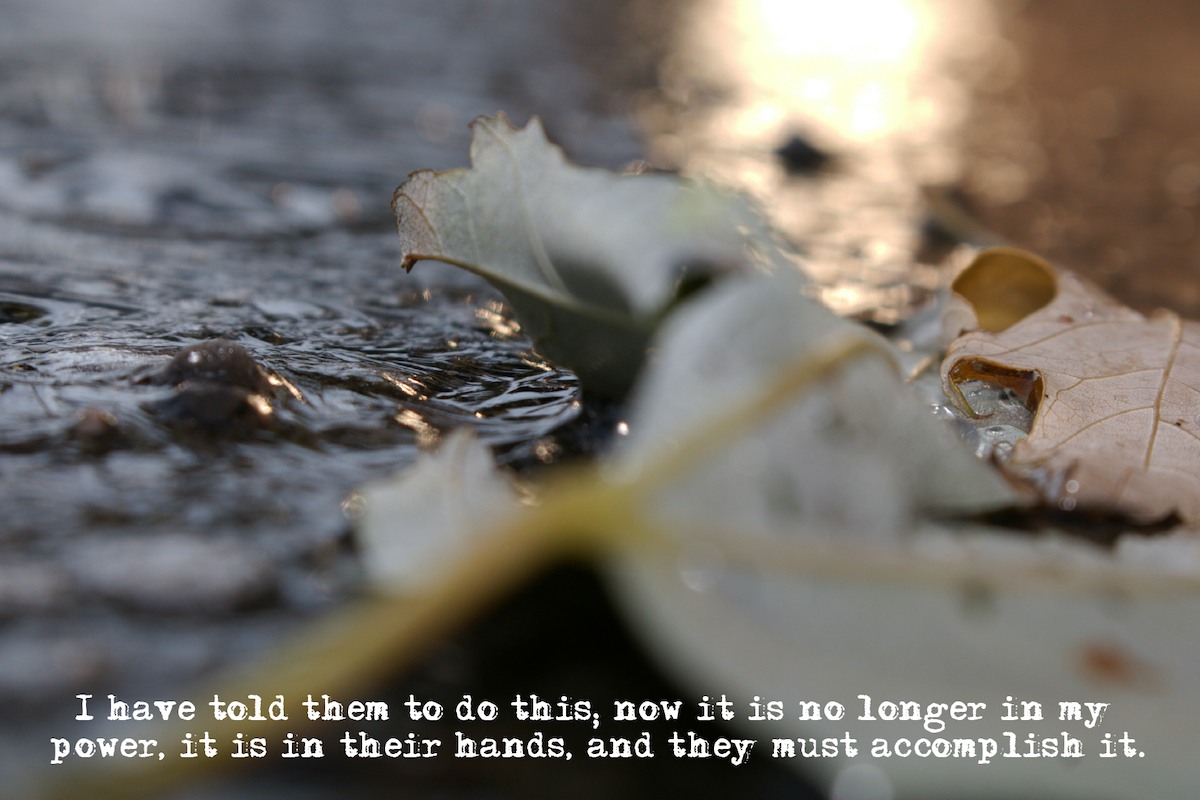
“Apathy.” Background image by Danielle-Claude Bélanger on Unsplash.
Shoghi Effendi was at times saddened by the actions of individual believers, and suffered deeply from what he perceived to be the inertia or the apathy that came over Bahá'ís at times. The Guardian could only do so much, and pilgrims often remembered the Guardian saying what he told Ugo Giachery one night:
I have told them to do this; now it is no longer in my power, it is in their hands, and they must accomplish it.
One night at dinner, Shoghi Effendi, speaking about world events at a very tumultuous time in history, the post-War period, the newly-created State of Israel—and he said:
If I should be influenced by the chaotic condition which exists in the world, I would remain passive and accomplish nothing.

“A thousand scorpions.” Scorpion vintage black and white drawing from Freepik.
The Guardian spoke to Ugo Giachery alone for many hours one evening during his pilgrimage between 4 March and July 1952. The Covenant-breakers—the old guard from the time of 'Abdu'l-Bahá, and the new Covenant-breakers from the ministry of the Guardian—were active, and Shoghi Effendi related to Ugo Giachery the suffering and anguish of 'Abdu'l-Bahá caused by the provocations, the evil machinations, the defiant and open hostility of the Covenant-breakers.
At the time, the two generations of Covenant-breakers were emboldened by the newly-created State of Israel and were trying to devise ways in which to take from the Guardian all the Bahá'í properties in the Holy Land through contesting the Will and Testament of 'Abdu'l-Bahá.
What they intended to accomplish was to drag the Guardian to court and publicly humiliate him. The entire affair lasted three months and ended with the Guardian’s victory, of course, but his suffering was unimaginable and very difficult for Ugo Giachery to describe. The sacredness of the Institution of the Guardianship had been attacked for the purpose of creating confusion among the ranks of the believers, and the greatest suffering of the Guardian came from the insult to the Institution of the Guardianship, and it made him so physically ill, he told Ugo Giachery it was as if “a thousand scorpions had bitten him.”
During the most crucial days of this sorrowful experience, the Guardian’s indignation was at its height, and he reviewed for Ugo Giachery the tragic history of the Faith from its inception in the Heroic Age, how Bahá'u'lláh had been betrayed by Mírzá Yaḥyá—the Arch-Breaker of the Covenant of the Báb—how Mírzá Muḥammad-'Alí—the Arch-breaker of the Covenant of Bahá'u'lláh—had inflicted unmentionable sufferings on 'Abdu'l-Bahá, and the Covenant-breaking in his own ministry, by 'Abdu'l-Bahá’s immediate family, all their acts of treachery and disobedience.
The Guardian was filled with anxiety and visibly grieved and told Ugo Giachery repeatedly that evening:
You must know these things, I want you to know these things.
Gradually, Ugo Giachery realized something important: the Guardian was in mortal danger and no Bahá'í outside of the room he was in—the closest Bahá'ís to Shoghi Effendi in his service—knew about it:
I became conscious that the Divine Covenant was assailed with vehemence by ruthless, satanic people, and that while the mass of the believers throughout the world were unaware of this grave danger, he, Shoghi Effendi, single and alone, was its defender, protected only by the armour and shield of his faith in God and His Covenant. The image passed rapidly through my mind of this new David battling single-handed against a ferocious, deadly monster, with all the terrors of the wilderness around him. He mentioned to me by name, one by one, the unfaithful members of his immediate family, their disobedience and obstinacy.
The Guardian also told Ugo Giachery about Covenant-breakers begging for his forgiveness with pathetic excuses, and said:
I am only the Guardian of the Cause of God and I must show justice. God only can show them mercy, if not in this world, in the next.
The Guardian paused, looked at Ugo Giachery silently for a while, and added:
But if they repent the Guardian would know their sincerity and pardon them.
In the course of this very lengthy conversation, Ugo Giachery had seen shadows of sorrow and dismay pass over the Guardian’s luminous face, like dark, heavy storm clouds pass through the sky. The entire time the Guardian was speaking, Ugo Giachery could feel the inner agony of the Guardian’s soul and the sufferings of his body, and that realization caused a huge surge of boundless love for the Guardian to swell up inside Ugo Giachery.
What would I have given to restore his happiness and tranquility! How much I loved this Defender of the Covenant, this Sign of God on earth, the inspirer of every noble thought among the children of men! I had to control myself not to take him in my arms, to shield him from any further suffering, to assure him that for every Covenant-breaker there were thousands and thousands of believers who, like me, were ready to shed their blood if that were demanded!

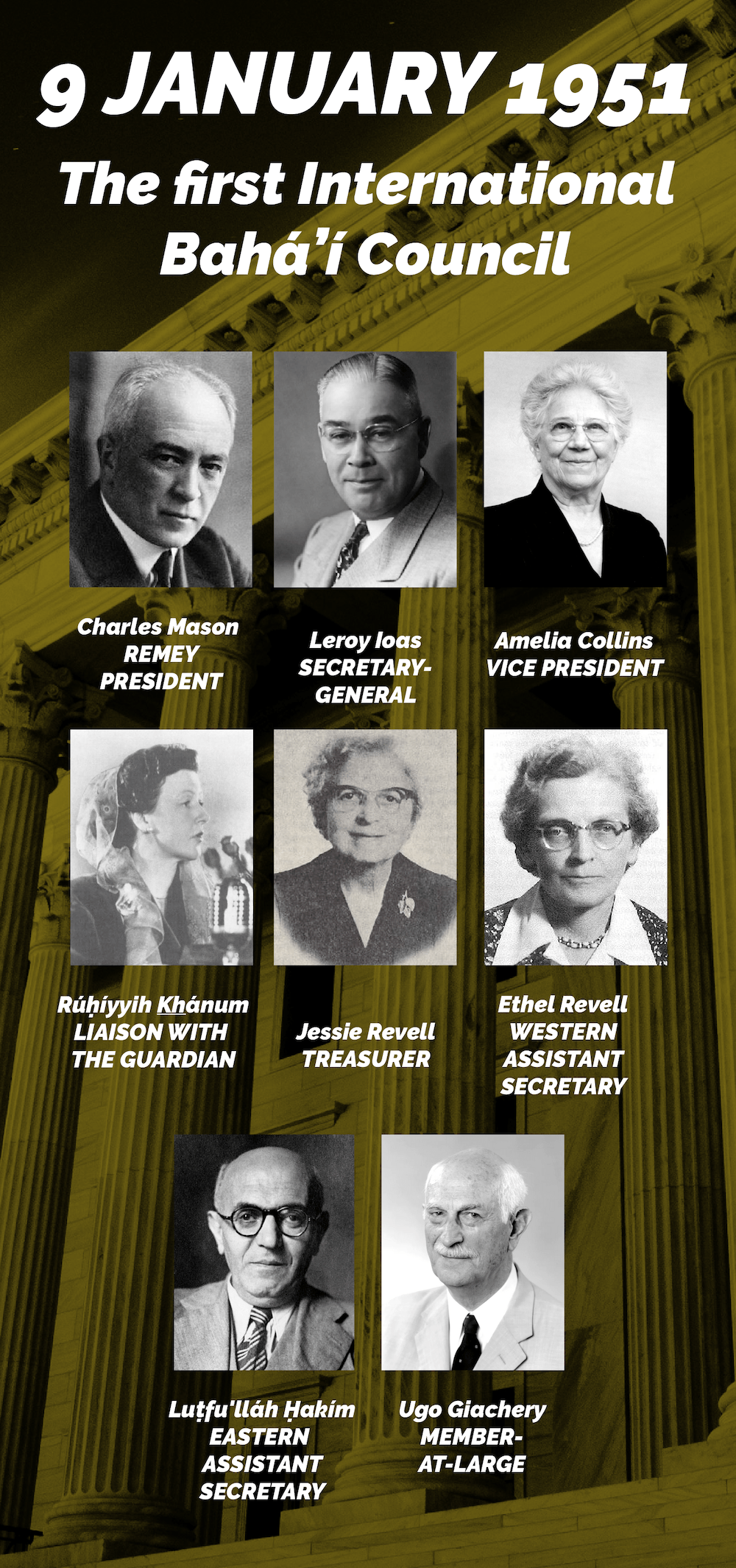
On 8 March 1952, a year after its inception, the Guardian enlarged the membership of the International Bahá'í Council, adding three new members, all Hands of the Cause: Ugo Giachery, Leroy Ioas, and Luṭfu’lláh Ḥakím. The new International Bahá'í Council was composed of: Hand of the Cause Mason Remey—President; Hand of the Cause Leroy Ioas—Secretary-General; Hand of the Cause Amelia Collins—Vice-President; Amatul'Bahá Rúḥíyyih Khánum—Liaison between the Guardian and the Council; Jessie Revell, Treasurer; Ethel Revell—Western Assistant Secretary; Luṭfu’lláh Ḥakím—Eastern Assistant Secretary and Hand of the Cause Ugo Giachery—Member-at-large. The background of the graphic is a stunning photograph by Chaud Mauger of the columns of the Universal House of Justice, which the International Bahá’í Council was meant to foreshadow. Source: Chad Mauger’s Flickr page, © Chad Mauger, used with permission.
Fourteen months after he announced the formation of the first International Bahá'í Council, the Guardian announced its enlargement on 8 March 1952 in a long cable.
The new membership of the International Bahá'í Council included:
- Amatu’l-Bahá Rúḥíyyih Khánum—Liaison between the Guardian and the Council;
- Hand of the Cause Mason Remey—President;
- Hand of the Cause Amelia Collins—Vice-President;
- Hand of the Cause Ugo Giachery—Member-at-large;
- Hand of the Cause Leroy Ioas—Secretary-General;
- Jessie Revell, Treasurer;
- Ethel Revell—western Assistant Secretary;
- Luṭfu’lláh Ḥakím—eastern Assistant Secretary.
The International Bahá'í Council was finally functioning according to the Guardian’s vision, three decades earlier.
The members of the International Bahá'í Council received their instructions from the Guardian individually, in the informal atmosphere of dinners at the Pilgrim House.
All the members of the Council were busy with tasks the Guardian allotted to them, and the functioning of the International Bahá'í Council as a whole successfully conveyed the image that the Guardian had so long yearned for: that of an international body managing the affairs of the Bahá'í Faith in Israel in the minds of the authorities.
The public and the Bahá'í world, through this International Bahá'í Council appointed and guided in its every steps by Shoghi Effendi, began to see the image of an international governing body for the Bahá'í Faith, that, in the fullness of time, would evolve into the Universal House of Justice.
On 4 May 1955 the Guardian announced that he had raised the number of members of the International Bahá'í Council to nine through the appointment of Sylvia Ioas, wife of Hand of the Cause Leroy Ioas.
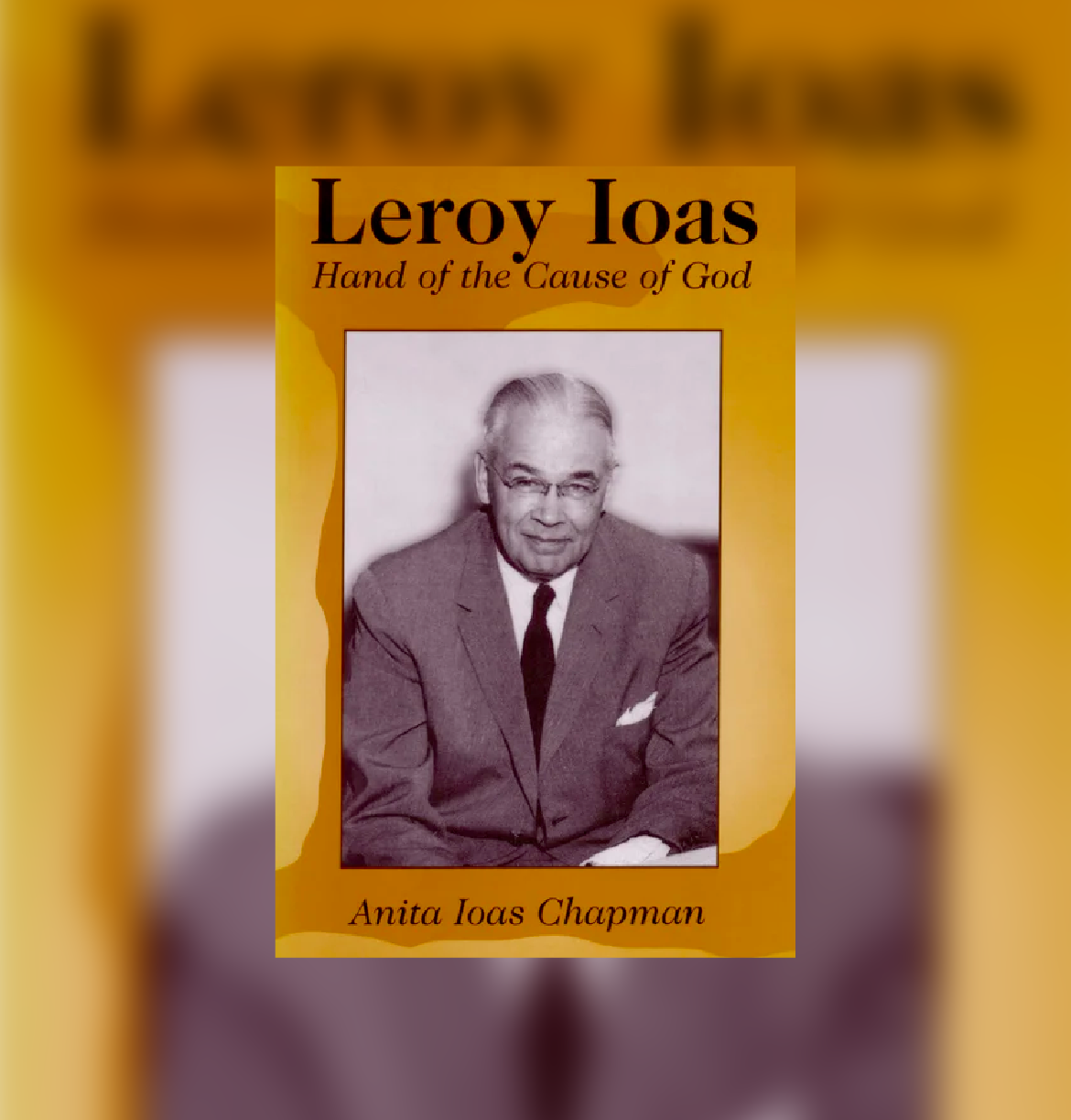
Leroy Ioas: Hand of the Cause of God is the perfect complement to Ugo Giachery’s Shoghi Effendi: Recollections, because in essence, they address the overlapping 5 years during which Ugo Giachery and Leroy Ioas was his Hercules both served the Guardian, assisting him in the developments of the International Bahá'í Endowments in the Holy Land.
Ugo Giachery began serving the Guardian five years Leroy Ioas but both Hands of the Cause were Shoghi Effendi’s rock, two men on which Shoghi Effendi could not only count on at any moment and for any service, but also trust blindly that the work they did would be beyond perfect. Their biographies are complementary because Ugo Giachery served in Italy and Leroy Ioas was at the Guardian’s side in Haifa.
Anita Ioas Chapman’s biography of her father is a scintillating work filled with so many intimate snapshots of the Guardian, so many insights into his work—Leroy Ioas was not only Secretary-General of the Bahá'í International Community, but he was also Shoghi Effendi’s secretary and both of his roles offer rare glimpses into a relatively unknown aspect of Shoghi Effendi’s life.
Leroy Ioas: Hand of the Cause of God is one of the best-written, most eloquent Bahá'í biographies you will find. Reading it is not only a tremendous pleasure, but an honor.
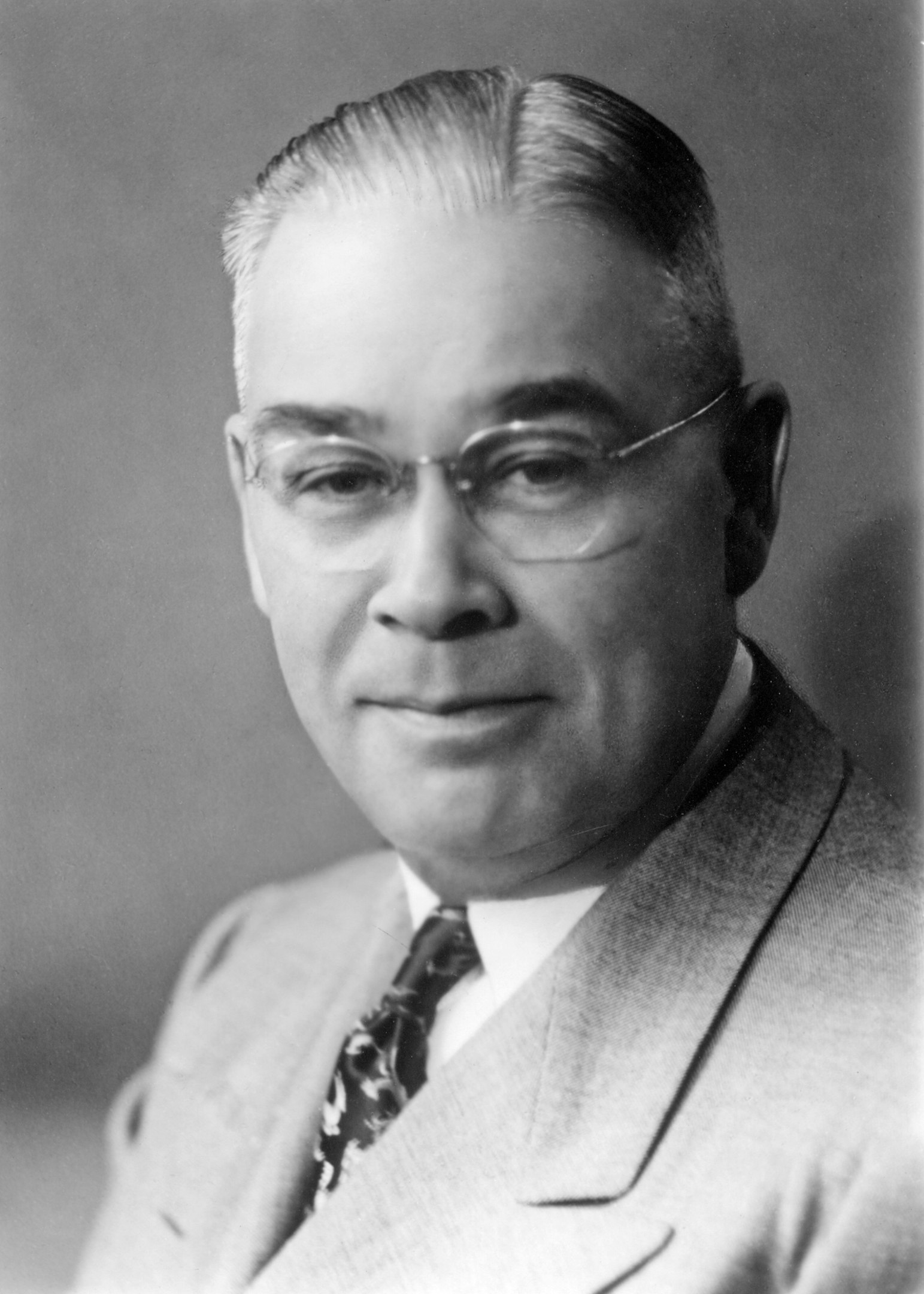
Leroy C. Ioas (1896-1965). Source: Bahá'í Media Bank, © Bahá'í International Community 2023.
Leroy Ioas was one of the most eminent American Bahá'ís in the Formative Age of the Bahá'í Faith, the son of German immigrants to the United States. When he was 16 years old, 'Abdu'l-Bahá visited the United States and Canada, and Leroy Ioas met Him in Chicago, and he was present when 'Abdu'l-Bahá laid the cornerstone for the House of Worship in Wilmette.
Being in the presence of 'Abdu'l-Bahá was a transformative experience for Leroy Ioas, one that shaped his life, and he would later say that what photographs of 'Abdu'l-Bahá did not show was “the vibrant spirit that was coursing through Him at all times.” As a teenager, Leroy Ioas was enveloped in the powerful presence of 'Abdu'l-Bahá, and that presence stayed with him throughout his life, which he dedicated to service to the Bahá'í Faith.
Leroy Ioas married Sylvia Kuhlman in 1919, was elected to the National Spiritual Assembly of the United States and Canada in 1932, and had a brilliant 40-year career with the southern Pacific Lines, rising from the lowest ranks of the company to the Passenger Traffic Manager for the eastern United States.
The Guardian appointed Leroy Ioas as a Hand of the Cause in the first contingent on 24 December 1951, and on 15 February 1952, the Guardian’s secretary invited Leroy Ioas to move to Haifa and act as the Secretary-General of the International Bahá'í Council, adding:
If you will accept to do this it would be rendering [the Guardian] and the Faith an invaluable service.
Leroy Ioas had never left the United States, and he was about to begin the greatest and most exciting adventure of his life: six years as the right-hand man of the Guardian, who referred to Leroy Ioas affectionately as “my Hercules.”
Leroy Ioas arrived in Haifa at 2:00 PM on 10 March 1952, just in time to meet Dr. Giachery, who had just arrived from Italy a couple of weeks earlier and met the Guardian for the first time. Together, they were about to embark on the last, most exciting phase of the construction work: The building of the drum and the dome of the superstructure of the Shrine of the Báb.
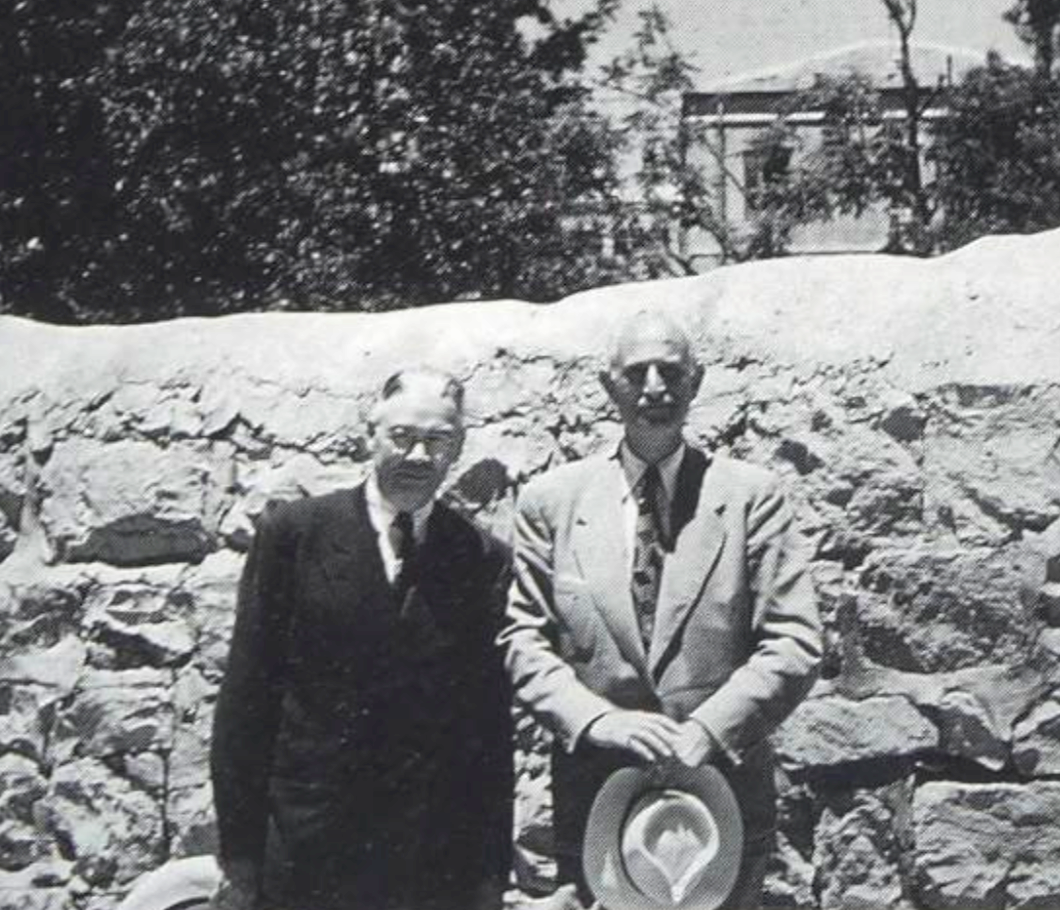
Leroy Ioas and Ugo Giachery in Jerusalem. Two Hands of the Cause closely associated with the Guardian between 1947 and 1957, and who both left profoundly moving pen portraits of Shoghi Effendi. Source: Leroy Ioas: Hand of the Cause of God by Anita Ioas Chapman, between pages 274 and 275.
Leroy Ioas was an American, and he had never seen the Guardian before he arrived in Haifa on 10 March 1952. Being American, he expected such a towering figure as the Ugo Giachery to be very tall and imposing with big shoulders, but he was shocked to discover that Shoghi Effendi was in fact small in stature, refined, and delicate.
All of his features were exquisitely refined: his nose, his eyes, his delicate small hands. And Leroy Ioas realized that the majesty and greatness of the Guardian, his imposing stature for Bahá'ís across oceans was not his physical size, towering over every person in the room, but the power of the Spirit that flowed through him. The Guardian was a channel used by God, he did not need to be 2 meters high. He needed to be the Guardian.
When the Guardian spoke about the power of the Cause, it seemed to Leroy Ioas as if the building shook from the power of his words, and in the five years that he served him, Leroy Ioas never ceased to marvel at the way God used the Guardian to do his work on this earth.
In fact, Shoghi Effendi was smaller than 'Abdu'l-Bahá, closer in his physical stature to Bahá'u'lláh. All three of them, Bahá'u'lláh, 'Abdu'l-Bahá, and Shoghi Effendi, were small in size. Shoghi Effendi some of the same facial features as 'Abdu'l-Bahá, he had the hands of Bahá'u'lláh, and he had the eyes of the Báb.
Although the Guardian was always very serious, he had a twinkle in his eye and a delightful sense of humor.
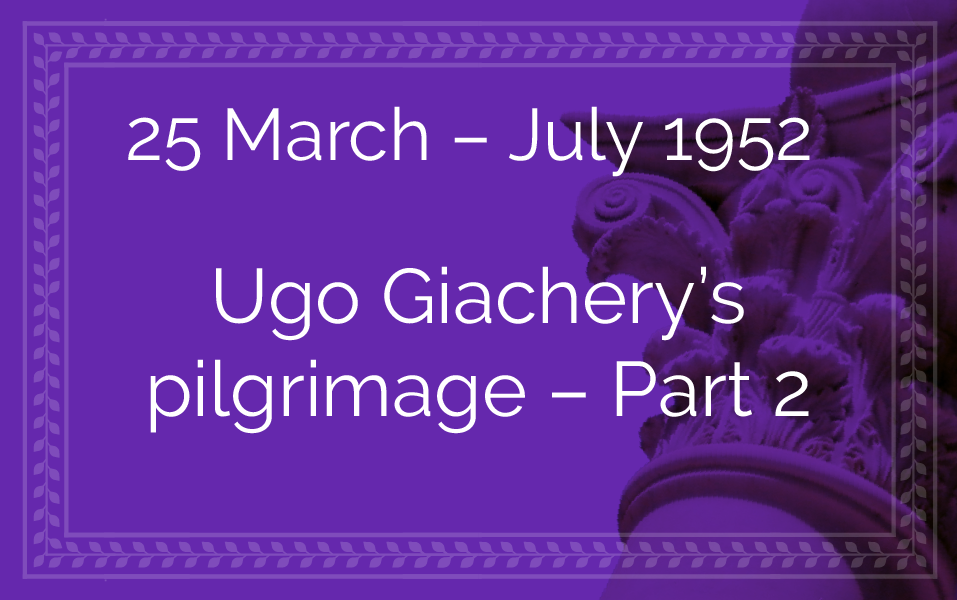
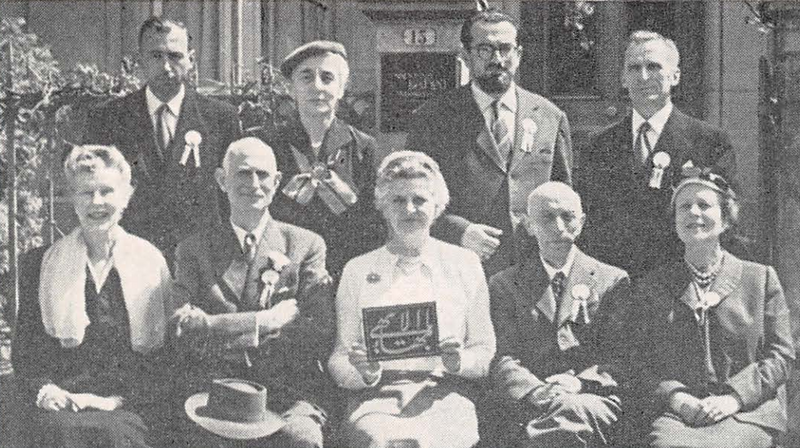
The Regional Spiritual Assembly for Switzerland and Italy for the year 1955-1956. Originally published in Baha'i News Issue 294, page 11. Source: Bahaimedia.
The Guardian appointed Ugo Giachery member-at-large of the International Bahá'í Council, and told him he would name the last remaining door of the Shrine of the Báb after him. Then, the Guardian told Ugo:
Your full station is not yet revealed, but I shall see that it is.
Ugo Giachery, in his memoirs, described what must have been the most profound experience of his life:
[The Guardian’s] eyes poured love upon me, and his tender attentions have rent my heart.
There were two more reasons why Shoghi Effendi had called Ugo Giachery to Haifa. The first was to consult with him about work in Bahjí, more specifically, the preliminary steps for the construction of the final Shrine of Bahá'u'lláh—the current one being the initial stage, as the original Shrine of the Báb built by 'Abdu'l-Bahá had been before the completion of the superstructure.
The second topic the Guardian wished to consult with Ugo about was the establishment of a Regional Spiritual Assembly for Switzerland and Italy which the Guardian described to Ugo in the following way:
Another great pillar to support the dome of the Bahá'í Administration. I want you to be independent and original, and I know that the Italians and the Swiss are capable of striving for achievements.
Ugo Giachery saw Shoghi Effendi nearly every evening for dinner at the western Pilgrim House, and every time Shoghi Effendi arrived, he brought with him a feeling of ecstatic excitement which affected the hearts of every pilgrim. Ugo Giachery was very deeply affected:
Whenever he came to the table he brought with him a feeling of ecstatic excitement which replenished my soul. Invariably I was filled with a wondrous sensation of continuity and safety…
Every night at dinner, Ugo Giachery felt the towering spiritual perception and vision of Shoghi Effendi, his spiritual strength, his refreshing and stimulating frankness. Shoghi Effendi’s natural curiosity was invigorating, he asked questions of everyone around the table, listening carefully to the answers. When he was asked questions, Shoghi Effendi would answer, sometimes elaborating beyond the scope of the limited question, displaying his immense knowledge with incredible meekness and humility.
This pilgrimage—but more so meeting Shoghi Effendi—changed Ugo Giachery’s life.
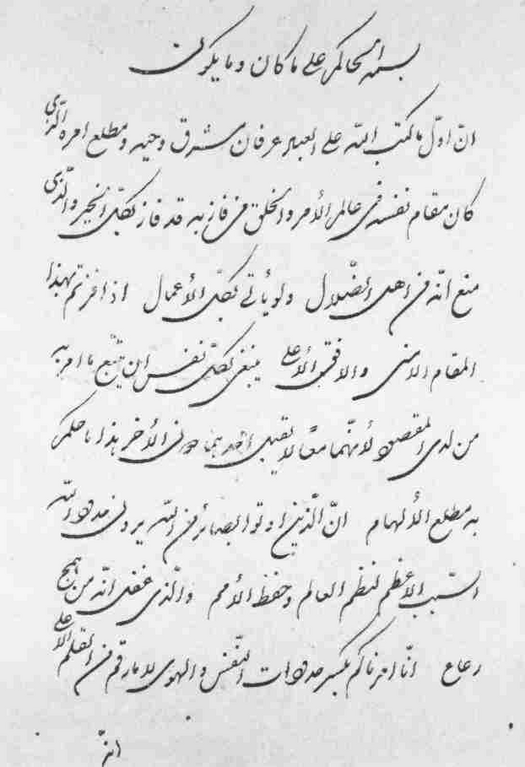
No images could be found of the Kitáb-i-Íqán in 'Abdu'l-Bahá’s handwriting. The image above is the first page of the Kitáb-i-Aqdas in 'Abdu'l-Bahá’s handwriting, which was originally published as the frontispiece of Adib Taherzadeh’s Revelation of Bahá'u'lláh Volume 3. Source: Bahaimedia.
One evening, as I entered the dining-room, the Guardian was already seated at his place at the table, his face shining with an inner jubilation which he could neither control nor conceal.
At his side, upon the table, stood a small bundle, an object wrapped in a colored silk handkerchief, typical of the East and of Iran in particular. As soon as we were all seated and attentive, even before dinner was served, he said that a pilgrim had that day arrived from Ṭihrán, bringing with him one of the most precious documents to be placed in the archives.
He untied the handkerchief and with great reverence lifted out a manuscript in book form, and, placing it in a position that everyone could see, added that it contained two original Tablets in the handwriting of 'Abdu'l-Bahá. One was the Kitáb-i-Íqán (The Book of Certitude) and the other was a Tablet.
Shoghi Effendi explained to the pilgrims that these manuscripts had been transcribed by Abdu'l-Bahá in His beautiful calligraphy, when He was about 18 years old. Beyond this fact—astounding on its own—both manuscripts contained notes written by Bahá'u'lláh in His Own hand on the margins of many of the pages, as he had reviewed them.
These precious documents were deeply significant for Shoghi Effendi, because until that night, he had never seen the original text of the Kitáb-i-Íqán and he was astonished to discover that the verse from the Kitáb-i-Íqán he had chosen to place on the epigraph page of The Dawn-Breakers was not in the original text of the Kitáb-i-Íqán as originally revealed by Bahá'u'lláh, but was, in fact, an after-reflection of Bahá'u'lláh’s in one of His handwritten notes in the margins of the manuscript transcribed by 'Abdu'l-Bahá. This was the verse in question:
I stand, life in hand, ready; that perchance, through God’s loving-kindness and grace, this revealed and manifest Letter may lay down his life as a sacrifice in the path of the Primal Point, the Most Exalted Word.
That evening, according to Ugo Giachery, the Guardian was not only astonished but overjoyed with the divine confirmation that through the operation of mysterious, mystical processes he had been inspired to pick out that particular verse from the Kitáb-i-Íqán as the eternal testimonial of Bahá'u'lláh’s deep yearning to sacrifice His life for the Báb’s.
Everyone seated around the table that night was awed and deeply moved to literally witness the evidence of the Guardian’s infallibility and be present to observe and feel the spiritual link between the Guardian and the invisible worlds of God, and his connection to the Báb, Bahá'u'lláh, and 'Abdu'l-Bahá in a single incident.
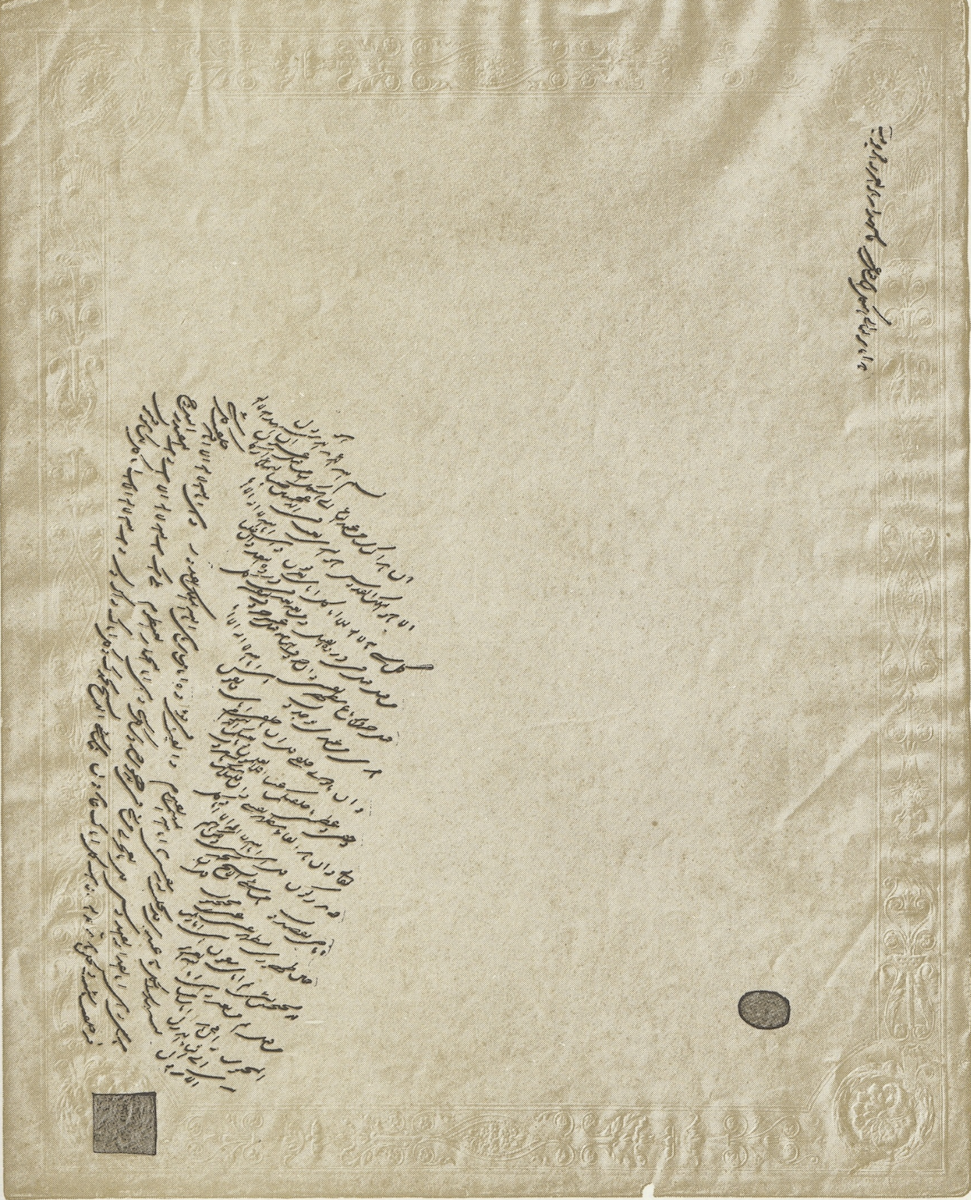
Facsimile of the Báb’s Tablet to Quddús, the Eighteenth Letter of the Living, and according to the Báb “The first in rank.” From The Dawn-Breakers. Source: The Covenant Library: The Dawn-Breakers.
On other occasions at dinner during Ugo Giachery’s pilgrimage, Shoghi Effendi told the pilgrims stories of how some of the most precious relics in the Archives came to be in his possession, such as the sword of Mullá Ḥusayn, the rings of the Báb, some of the Báb’s garments, and many other relics which he had placed in the International Bahá'í Archives in the three rooms of the Shrine of the Báb.
The Guardian was always eager to educate any Bahá'í that entered his gravitational pull, and spared no effort to reveal and explain episodes from the Heroic Age of the Faith or facts that formed part of the Bahá'í community’s collective heritage and culture, particularly when it came to anything relating to Bahá'í history and the unfoldment of the Faith.
One example was the evening when Shoghi Effendi described for the astonished pilgrims how the priceless Tablets revealed by the. Báb to the Letters of the Living were found by asking the question himself then answering it:
Where did the original Tablets come from, and how is it we have them all in the archives? When the Master passed away, we found the whole set of these Tablets, in the original, twenty in all. They must have been in the papers of the secretary of Bahá'u'lláh, Mírzá Áqá Ján, and must have been given to Bahá'u'lláh years ago.
The Bahá'ís had no knowledge of them during the days of the Master. One Tablet is addressed to the Báb, Himself; the last one, written on blue paper, is addressed to Bahá'u'lláh, "Him Whom God has manifested and will manifest," these last two bear three seals each. In addition we found in the Master's papers Tablets of Bahá'u'lláh addressed to the Master.
It was obvious, with so many priceless relics, that the time had come for the Guardian to build the International Bahá'í Archives. This story is told in full starting in October 1952.
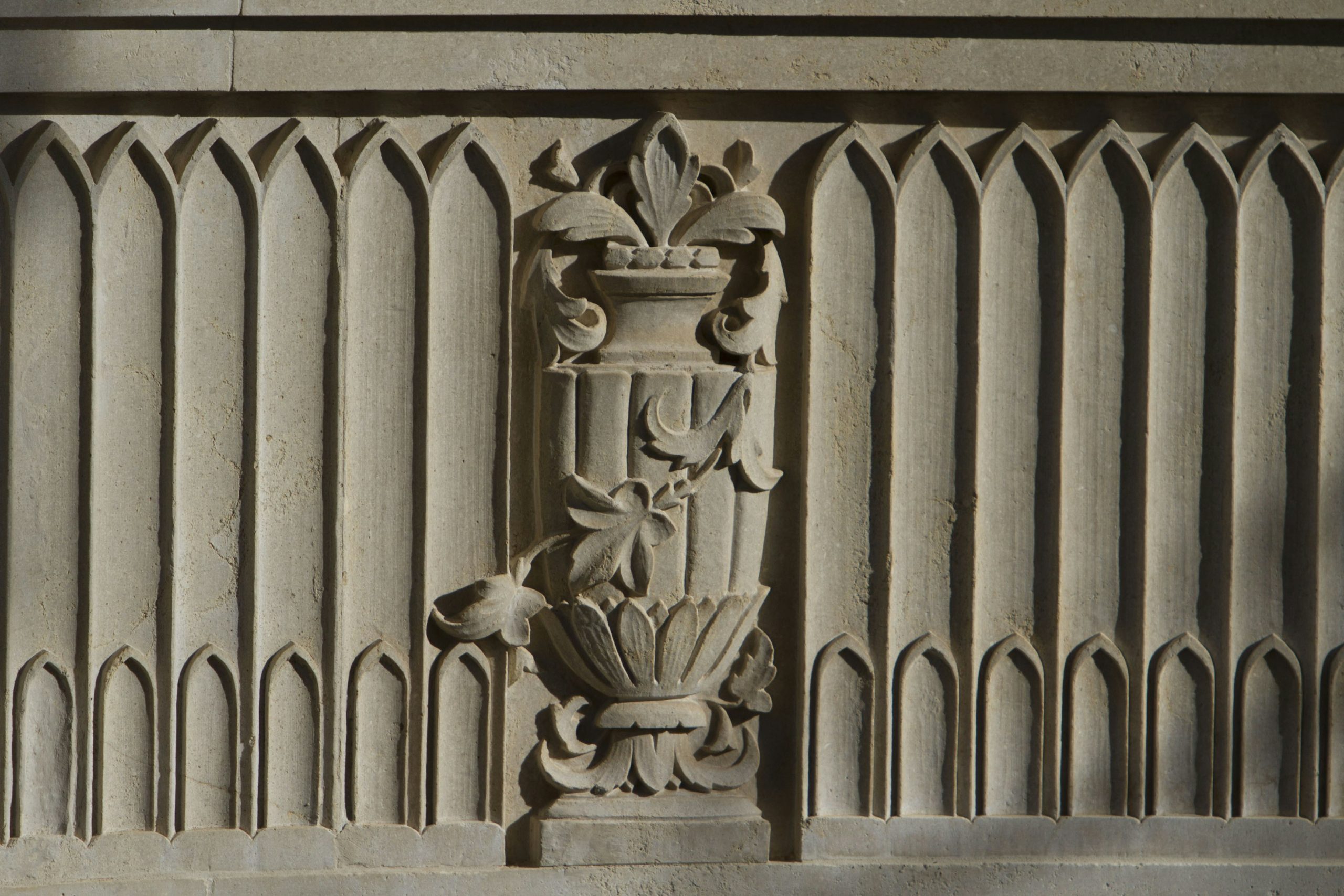
An example of stone carved detail which Ugo Giachery was supervising in Italy for the Guardian. All the details relating to the design and construction of the superstructure to the Shrine of the Báb will be covered in detail in the next part of the chronology. Source: Bahá'í Media Bank, © Bahá'í International Community 2023.
William Sutherland Maxwell, Shoghi Effendi’s father-in-law, had passed away on 25 March 1952, and it was after this tragic event in his personal life, that Ugo Giachery had the opportunity to work with the Guardian at the Shrine of the Báb.
Shoghi Effendi had the habit—confirmed by Saichiro Fujita who even said it was like clockwork at 4 PM—of interrupting his administrative work in Haifa in the early afternoon and being driven to the Eastern Pilgrim House right next to the Shrine of the Báb on Mount Carmel.
Because of William Sutherland Maxwell’s passing and the building contractor being ill, the construction work on the superstructure of the Shrine of the Báb was progressing very slowly and Ugo Giachery seized the welcome opportunity to assist the head-mason in many details of the construction work, which were intimately familiar to him, as he was the one who had supervised the carving of the marble in Italy.
Ugo Giachery spent hours at the Shrine, and noticed that the Guardian would pace the entire length of the northern gardens, engrossed in his thoughts, then enter the Shrine for prayers, staying quite a long time, then slowly retrace his steps back to his car and driver to return home to his work. It came to Ugo Giachery’s mind that even to the Guardian, the heavenly atmosphere of peace and calm of the Shrine’s gardens offered momentary comfort from physical distress and exhaustion, and provided him with a source of inspiration.
Then, at dinner, Shoghi Effendi would share his day, to Ugo Giachery’s delight:
At night, when at dinner, his dear face, like an open book, would reveal the process undergone during the day, and his warm and enthusiastic conversation would confirm, without any doubt, the new heights scaled in the world of realities.

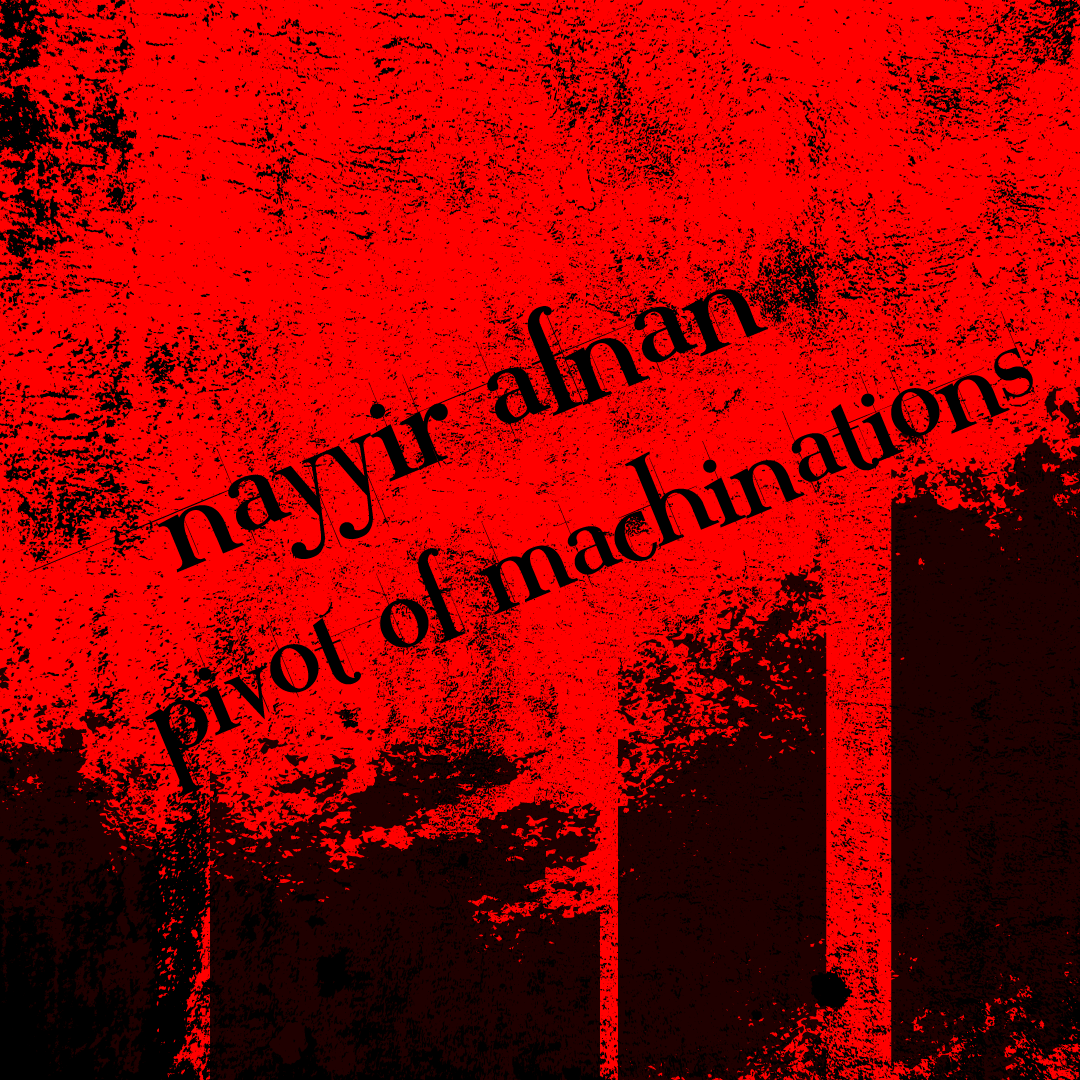
Shoghi Effendi’s eldest sister Rúhangíz—who had studied in Scotland when Shoghi Effendi was in Oxford—married the eldest son of Ḥájí Siyyid ‘Alí and Furúghíyyih Khánum, Nayyír and they had two daughters.
Nayyír, the son of Abdu'l-Bahá's great enemy, and the man who had married Shoghi Effendi's eldest sister, died in 1952. Shoghi Effendi's cable announcing his death on 5 April 1952 summed up the heart-breaking events of the previous years.
The cable was addressed to the National Spiritual Assembly of the United States for the Bahá'ís of the world.
This cable is significant because the Guardian outlines the depth and breadth of Nayyír’s Covenant-breaking, calling him the “pivot of machinations” and the “connecting link between old and new Covenant-breakers.” The Guardian also states that the spiritual havoc he wrecked on the Faith for over 20 years will take time to comprehend and to assess the damage. But Shoghi Effendi also outlines the misdeeds of Bahá'u'lláh’s third wife, and the grievous sins of the husband of Bahá'u'lláh’s youngest daughter.
(Note, the underlined names are explained below the cable.)
Inform National Assemblies that God's avenging wrath having afflicted in rapid succession during recent years two sons brother and sister-in-law of Archbreaker of Bahá'u'lláh's Covenant, has now struck down second son of Siyyid Ali, Nayer [Nayyír] Afnán, pivot of machinations, connecting link between old and new Covenant-breakers. Time alone will reveal extent of havoc wreaked by this virus of violation injected, fostered over two decades in Abdu'l-Bahá's family. History will brand him [Nayyír] one whose grandmother, wife of Bahá'u'lláh, joined breakers of His Covenant on morrow of His passing, whose parents lent her undivided support, whose father openly accused Abdu'l-Bahá as one deserving capital punishment, who broke his promise to the Bab's wife to escort her to Holy Land, precipitating thereby her death, who was repeatedly denounced by Centre of the Covenant as His chief enemy, whose eldest brother through deliberate misrepresentation of facts inflicted humiliation upon defenders of the House of Bahá'u'lláh in Baghdad, whose sister-in-law is championing the cause of declared enemies of Faith, whose brothers supported him attributing to Abdu'l-Bahá responsibility for fatal disease which afflicted their mother, who himself [Nayyír] in retaliation first succeeded in winning over through marriage my eldest sister, subsequently paved way for marriage of his brothers to two other grandchildren of the Master, who was planning a fourth marriage between his daughter and grandson of Abdu'l-Bahá, thereby involving in shameful marriages three branches of His family, who over twenty years schemed to undermine the position of the Centre of the Faith through association with representatives of traditional enemies of Faith in Persia, Muslim Arab communities, notables and civil authorities in Holy Land, who lately was scheduled to appear as star witness on behalf of daughter of Badí’u’lláh in recent lawsuit challenging the authority conferred upon Guardian of Faith in Abdu'l-Bahá's Testament.
In this cable, Shoghi Effendi speaks of several major Covenant-breakers without stating their names. It is a very important message the Guardian sent the Bahá'í world and in order to understand it fully, these individuals need to be named.
- The “two sons…of Archbreaker of Bahá'u'lláh's Covenant” mentioned by Shoghi Effendi are the following children of Mírzá Muḥammad-'Alí—also known as the Arch-breaker of the Covenant of Bahá'u'lláh, Shu‘á‘u’lláh and Músá;
- The “brother…of Archbreaker of Bahá'u'lláh's Covenant” is Mírzá Muḥammad-'Alí’s brother, Badí’u’lláh.
- “Siyyid Ali…parents…father…mother”: These terms refer to Nayyír’s parents, Ḥájí Siyyid ‘Alí and Bahá'u'lláh’s youngest daughter, Furúghíyyih Khánum;
- “one whose grandmother, wife of Bahá'u'lláh”: Here, Shoghi Effendi is speaking about Bahá'u'lláh’s third wife, Gawhar Khánum, the mother of Furúghíyyih Khánum and grandmother of Nayyír;
- “brothers”: Faydí and Ḥasan Afnán, Nayyír’s brothers: Ḥasan Afnán married Mihrangíz Rabbání, Shoghi Effendi’s’ younger sister and granddaughter of 'Abdu'l-Bahá, and Faydí Afnán married Thurayyá, another one of 'Abdu'l-Bahá’s granddaughters;
- “my eldest sister”: Rúhangíz, Shoghi Effendi’s eldest sister who married Nayyír;
- “two other grandchildren of the Master”: the two other grandchildren of 'Abdu'l-Bahá whom Nayyír conspired to marry to his Covenant-breaking brothers Ḥasan and Faydí: Shoghi Effendi’s younger sister Rúhangíz, and Thurayyá—'Abdu'l-Bahá’s granddaughter from His daughter Túbá Khánum;
- “his daughter and grandson of Abdu'l-Bahá”: Nayyír and his wife Rúhangíz conspired to marry his daughter Bahíyyih—a great-granddaughter of 'Abdu'l-Bahá—to Ḥasan Shahíd—the grandson of 'Abdu'l-Bahá from his daughter, Túbá Khánum.
- “daughter of Badí’u’lláh in recent lawsuit challenging the authority conferred upon Guardian of Faith in Abdu'l-Bahá's Testament”: Badí’u’lláh daughter Sadhijih was a notorious woman with a criminal record, a political agitator who was in prison because of her illegal activities; In 1952, collapse. Sadhijih and another Covenant-breaker still living a run-down shack against the Mansion of Bahjí sued Shoghi Effendi for having demolished another derelict building, claiming that, given they had a one-sixth interest—they should have been consulted prior to the demolition; Shoghi Effendi won the case.
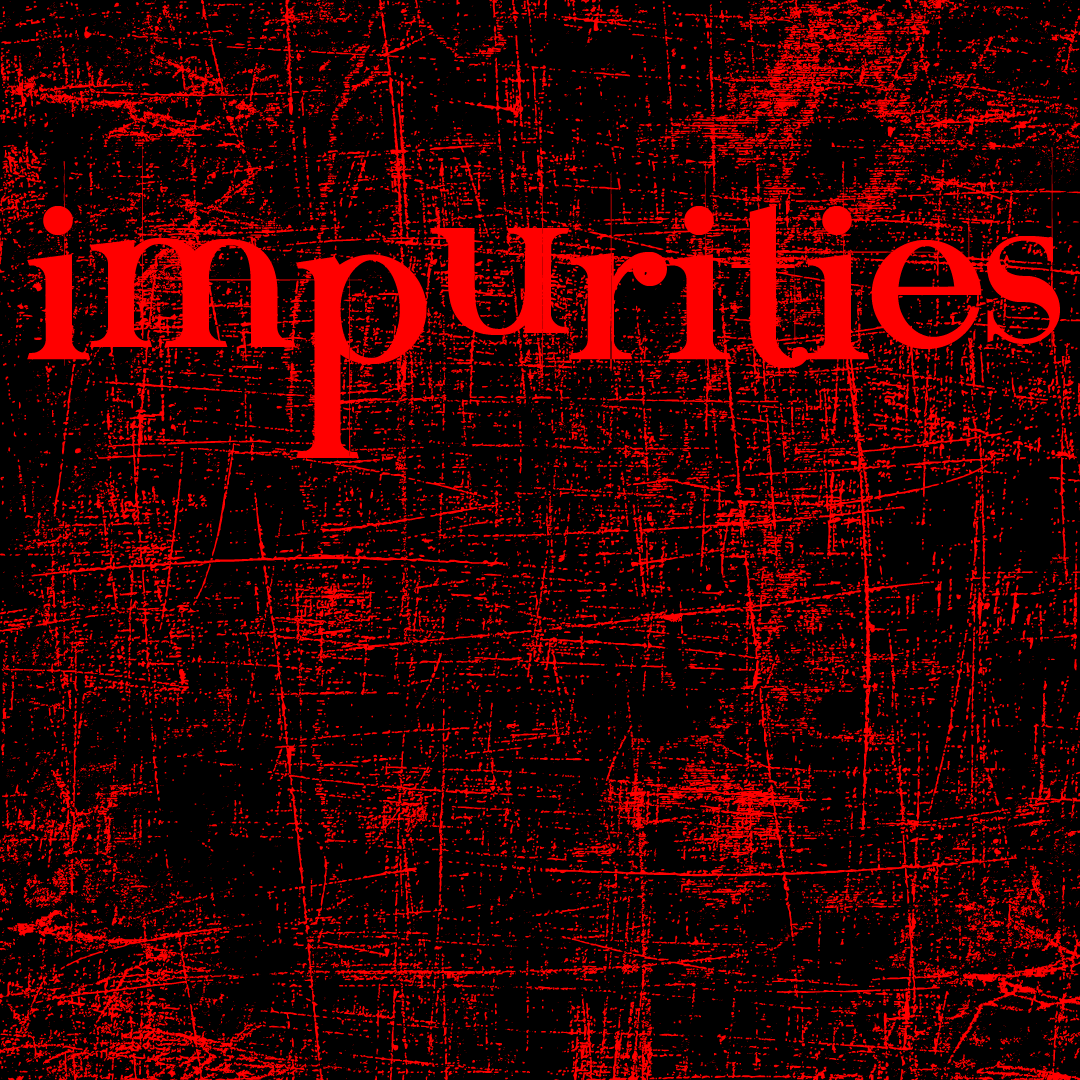
Each one of these letters and cables announcing one more Covenant-breaker—and there are dozens more—were one more heartbreak for Shoghi Effendi, one more agonizing experience for the Guardian.
Covenant-breaking manifested itself through a variety of deeds: lies, plotting, theft, campaigns of defamation, opposition, betrayal, open defiance, lawsuits, Covenant-breaking marriages, misrepresentation of facts, slander, creating divisions and disunity.
In the end, except cause suffering to the Guardian, the Covenant-breakers worldwide did not accomplish anything except further strengthening the fabric of the Bahá'í community and its attachment to Shoghi Effendi and the Covenant of Bahá'u'lláh.
Adib Taherzadeh—author of the Covenant of Bahá'u'lláh—calls Covenant-breaking a “a cleansing process by which the impurities are thrown out of the body of the Cause.”
Shoghi Effendi explained the effect of Covenant-breaking on the Covenant as a strengthening dynamic:
We should also view as a blessing in disguise every storm of mischief with which they who apostatize their faith or claim to be its faithful exponents assail it from time to time. Instead of undermining the Faith, such assaults, both from within and from without, reinforce its foundations, and excite the intensity of its flame. Designed to becloud its radiance, they proclaim to all the world the exalted character of its precepts, the completeness of its unity, the uniqueness of its position, and the pervasiveness of its influence.
Rúḥíyyih Khánum spent a lifetime with Shoghi Effendi and watched him suffer from the misdeeds of his unfaithful family members. She observed that once Mírzá Yaḥyá broke the Covenant just two years after Bahá'u'lláh’s declaration, in 1865 with his attempt to poison Bahá'u'lláh, Covenant-breaking stayed. Mírzá Yaḥyá associated with Siyyid Muḥammad, then Mírzá Muḥammad-'Alí entered the folly followed by Mírzá Majdi’d-Dín, Mírzá Badí’u’lláh, then Nayyír, and all the relatives of 'Abdu'l-Bahá.
The family of 'Abdu'l-Bahá grew up in the tainted shadow of Covenant-breaking. They were reared in an atmosphere where there were spiritual storms, attacks on 'Abdu'l-Bahá, separations, reconciliations, requests for forgiveness, letters of repentance, renewed opposition, final break, public pronouncement of Covenant-breaking.
A Covenant-breaker is like a tumor that is slowly destroying a healthy body—the Bahá'í community. Removing the tumor—excommunicating the Covenant-breaker—is the only way to stop the spread of the disease, but because it is such a final step, because it is so unforgivable, the Center of the Faith tries everything else before shunning the Covenant-breaker.
Bahá'u'lláh and 'Abdu'l-Bahá both suffered through Covenant-breaking attacks, and now it was the turn of Shoghi Effendi to weather this spiritual storm.
Covenant-breaking is part of the unbearable weight carried by the Center of the Faith. Rúḥíyyih Khánum eventually understood that the reason why Covenant-breaking affected Shoghi Effendi so violently, is because, as the Guardian, he had a heightened sensitivity to people’s spiritual states, and Covenant-breaking made him ill:
Gradually I came to understand that such beings [the Centers of the Covenant—the Guardian], so different from us, have some sort of mysterious built-in scales in their very souls; automatically they register the spiritual state of others, just as one side of a scale goes down instantly if you put something in it because of the imbalance this creates. We individual Bahá'ís are like the fish in the sea of the Cause, but these beings are like the sea itself, any alien element in the sea of the Cause, so to speak, with which, because of their nature, they are wholly identified, produces an automatic reaction on their part; the sea casts out its dead.
Model for the Mashriqu’l-Adhkár or House of Worship on Mount Carmel, designed by Charles Mason Remey, Hand of the Cause and architect. Source: The Bahá'í World Volume XII, page 548.
By the end of May 1952—at a time when he did not own the Temple Land—the Guardian had approved a design for the first Mashriqu’l-Adhkár—Bahá'í House of Worship—in the Holy Land, and the drawing had been sent to Florence, Italy. A model-maker in Rome produced a wooden architectural model of the design, which was taken to Chicago by Amatu’l-Bahá Ruḥíyyíh Khánum and displayed at the All-American Teaching Conference between 3 – 6 May 1953.
The model was later placed at Bahjí.

The main thing the Covenant-breakers were attached to was humiliating the Head of the Faith, and to that end, they ensured that Shoghi Effendi would be personally summoned as a witness, an act so insulting that it caused the Guardian immense distress. In Ugo Giachery’s words, Shoghi Effendi’s pain was crushing:
His great suffering was for the sacrilege being committed against this Institution of the Faith. It was so abhorrent to him that he felt physically ill, as if 'a thousand scorpions had bitten him.
The Guardian decided to directly appeal the Government to lift the case out of the Civil Court. To this end, the Guardian called in the cavalry. He summoned Ugo Giachery from Rome, Leroy Ioas arrived in Haifa on 10 March 1952. Around the same time the very first American pilgrim arrived in the Holy Land since the Guardian had suspended pilgrimages: Larry Hautz, an insurance salesman. The Guardian asked Larry to stay for three months to assist Leroy Ioas and Dr. Ugo Giachery with acquiring properties around the Holy Places.
Leroy Ioas, Larry Hautz, and Ugo Giachery arrived at a time when the Guardian was deeply worried and preoccupied with the lawsuit the two Covenant-breakers still living in a shack at Bahjí had brought against him and the Faith.
Upon his arrival, the Guardian delegated Leroy Ioas to meet the Covenant-breakers and their clever, hostile lawyer and found himself faced not with people trying tom solve a problem, but with attacks on ‘Abdu’l-Bahá dating back 60 years. Originally, the lawsuit had been filed because the Covenant-breakers had protested Shoghi Effendi’s December 1951 demolition of a run-down house, but as negotiations began, Leroy Ioas realized they had ulterior motives.
It was unclear what it was they wanted, but it was either co-custodianship—with the Guardian—of the Shrine of Bahá'u'lláh, or securing their old rooms inside the Mansion of Bahjí, which they had vacated so that the Guardian could repair the dilapidated Holy Place. They wanted back in now that it was restored, which was utterly unthinkable. The Israeli Government, as per Shoghi Effendi’s official application, had changed the status of the Mansion of Bahjí from a place of residence to a place of pilgrimage and the Guardian was its only lawful custodian.
At first, Leroy Ioas found it incredibly difficult even to look at the Covenant-breakers, but the Guardian gave him strict instructions never to lower his eyes “when dealing with him, telling Leroy, to look at them “straight in the eye.” Repugnant as he found it, he learned to deal with them because he was called on to do so, even at times alone when the Guardian was absent.
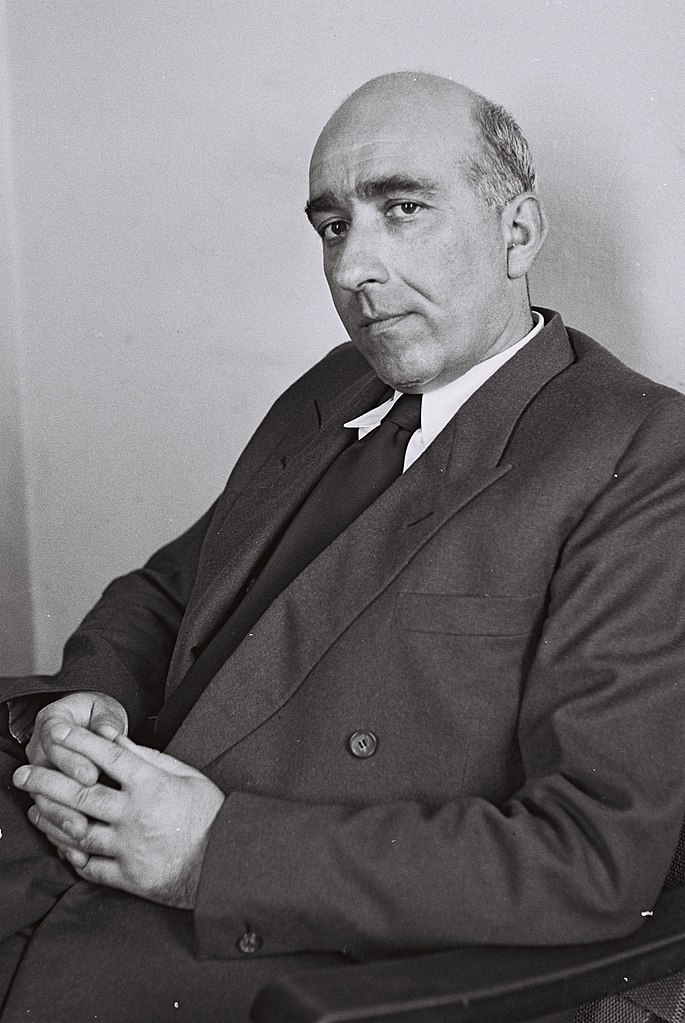
Attorney General of Israel Haim Cohn. Source: Wikimedia Commons.
Three Hands of the Cause called on the Attorney General Haim Cohn, the Vice-Minister of Religions, and officials of the Foreign Office and the Prime Minister David Ben-Gurion’s office.
Attorney-General Haim Cohn informed the president of the Haifa Court that in accordance with a 1924 law, the case in question was a religious matter and not to be tried by a Civil Court.
The Guardian’s brilliant instinct had paid off, but the Covenant-breakers’ devious lawyer appealed to the Supreme Court of Israel on a technicality. This was a serious mistake, because they were now not just attacking the Bahá'ís but the State of Israel.
The Hands of the Cause continued applying pressure, and the Guardian appealed directly to both the Prime Minister, David Ben-Gurion and the Minister of Foreign Affairs Moshe Sharett
The Guardian’s appeals had an immediate effect.
David Ben-Gurion’s legal adviser summoned the Vice-Minister of Religions, the Covenant-breaker’s lawyer, the lawyer for the Hands of the Cause and their clients. The Bahá'ís refused to be in the same room as Covenant-breakers, so they waited in another room of the building. The Covenant-breakers’ lawyer reiterated his clients’ claims, which were passed along to the Hands of the Cause, who rejected each one of their claims.
In the end, the Prime Minister's adviser told the Covenant-breakers that they were free to continue their appeal, but they were now fighting with the State of Israel.
This was when the Covenant-breakers dropped the case.
The Israeli Government issued the authorization to demolish the ruins.
Weeks after these events, on 11 June 1952, the Guardian cabled the Bahá'í world informing them of the successful conclusion to the painful case brought against the Faith by the "blind, uncontrollable animosity" of the Covenant-breakers.
In his message of 11 June 1952 sharing this legal victory won over the Covenant-breakers, Shoghi Effendi recounted the series of devastating failures and defeats encountered by the Covenant-breakers over the past 60 years and described their recent actions as “short-sighted action prompted by blind, uncontrollable animosity.”
As was his lifelong habit, as soon as he had received authorization, the Guardian immediately sprang into action.
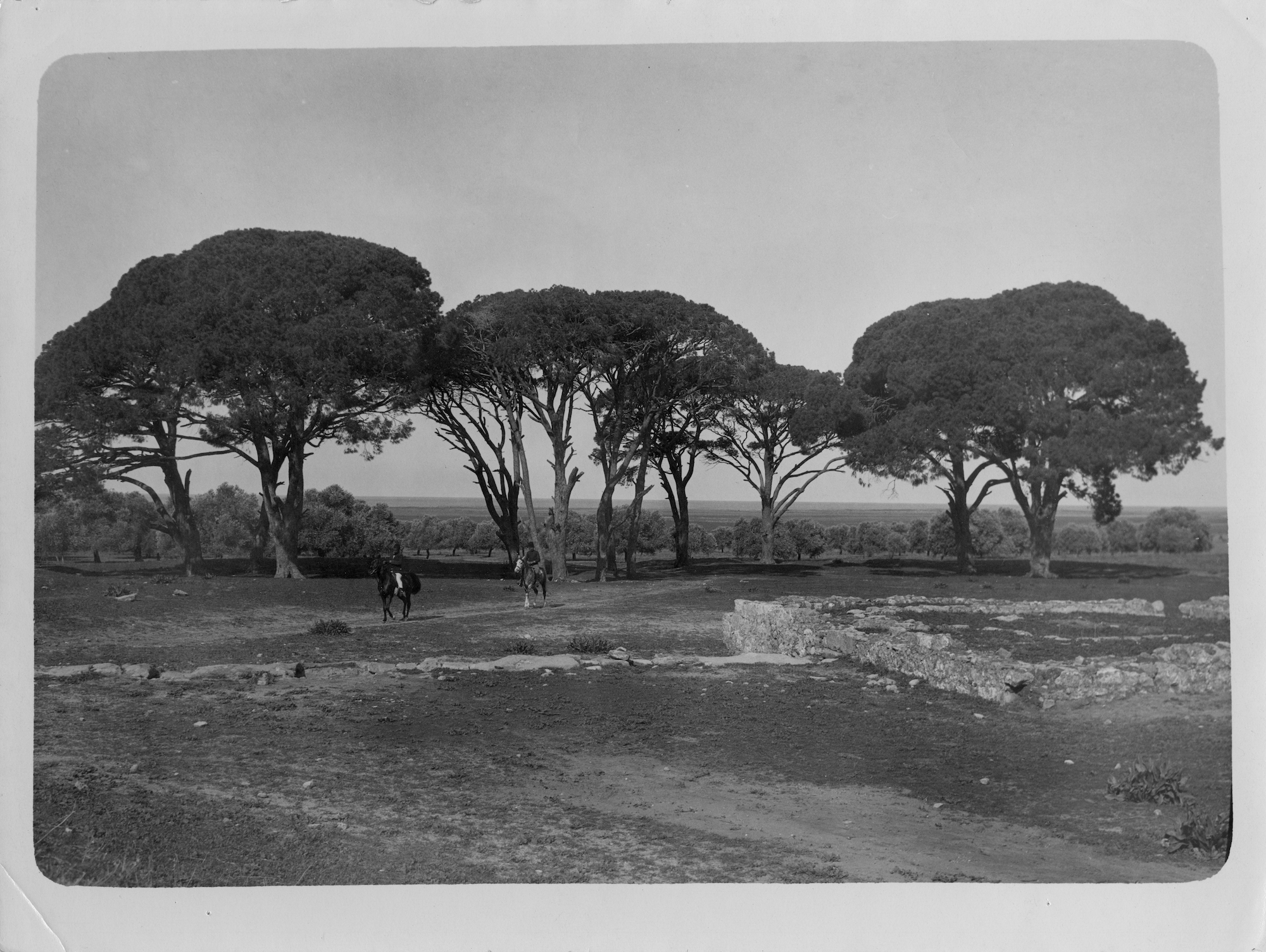
A stunning and very rare photograph of Bahjí in the time of 'Abdu'l-Bahá. © United States National Bahá'í Archives, used with permission.
The night before the demolition—48 hours after permission had been granted—the Guardian asked for all available Bahá'í men to meet at Bahjí in the morning for heavy manual labor.
Shoghi Effendi leveled the house, began landscaping the approaches to the Shrine of Bahá'u'lláh with eight truckloads of plants and garden ornaments which allowed him to begin embellishing the surroundings of the Shrine, erected a gate, and, as he explained in his message of 11 June 1952 he provided:
Public access to the heart of the Qiblih of the Bahá'í World is now made possible through traversing the sacred precincts leading successively to the Holy Court, the outer and inner sanctuaries, the Blessed Threshold and the Holy of Holies.
Leroy stayed in the Mansion to oversee the work and second the Guardian.
Shoghi Effendi’s chauffeur who carried a ball of string and wooden stakes, and, at the Guardian’s instructions, laid out several paths radiating out from the Shrine of Bahá’u’lláh and one path leading directly to its door. The gardeners planted hedges of thyme along paths.
The Guardian demolished the small buildings between the Mansion of Bahjí and the Shrine of Bahjí.
From the roof, he had a good view of all the work going on.
At times, Shoghi Effendi watched from the roof of a building, which gave him a perfect vantage point on the work.
An enormous amount of leveling—moving around large quantities of earth to raise or level the ground evenly—took place, particularly when the Guardian asked the workers to raise a long embankment which would later evolve in the embankment near the Shrine of Bahá'u'lláh which we are now familiar with.
Once the radiating paths in the shape of a quarter-circle had been drawn out and dug, Shoghi Effendi began laying out his garden with lawns, flower-beds, his beloved paths of crushed red tiles—the ones he had fallen in love with thirty years before in Torquay—then he lined the paths with lamp-posts.
The Guardian worked through afternoon drizzles, through a cold, through a fever, never stopping. He had old trees removed, and new trees planted along the paths to create an outer semicircular wide, tree-bordered avenue.
Iron gates, steps, stone ornaments, flowering plants, top soil and grass seeds were brought from Haifa, Mount Carmel, the Riḍván Garden, and the Master’s House to embellish Bahjí.
By the end of the fourth day, the sacred precincts of the Qiblih—the Most Holy Shrine—of the Bahá’í world had taken on the appearance of a gorgeous, flowering garden, which looked like it had always been there.
There were lanes, hedges, crushed red tile paths, tree-lined avenues, lawns, flower beds, plants, trees, lamp posts, pedestals, stone ornaments, and a beautiful gate—originally intended for the bottom terrace of Mount Carmel—placed on one of the western paths leading out from the Shrine.
That garden stood on what had been sand four days before.
As Ugo Giachery said, the Guardian’s process for embellishing Bahjí was to beautify everything, all at once:
It was like a powerful and ever-present force of enchantment creating beauty in a hundred places at the same time.
Ugo Giachery beautifully describes the way that the Guardian accomplished this astonishing, herculean feat:
Shoghi Effendi was moving about directing, counselling, cautioning, encouraging, explaining, demonstrating how to do apparently impossible things, and rejoicing in the transformation of the land under our very eyes.
The Guardian had miraculously manifested a fully-mature, expansive garden around the Shrine of Bahá'u'lláh in four days.
Right on time for the commemoration of Baha'u'llah's Ascension on 29 May 1952.
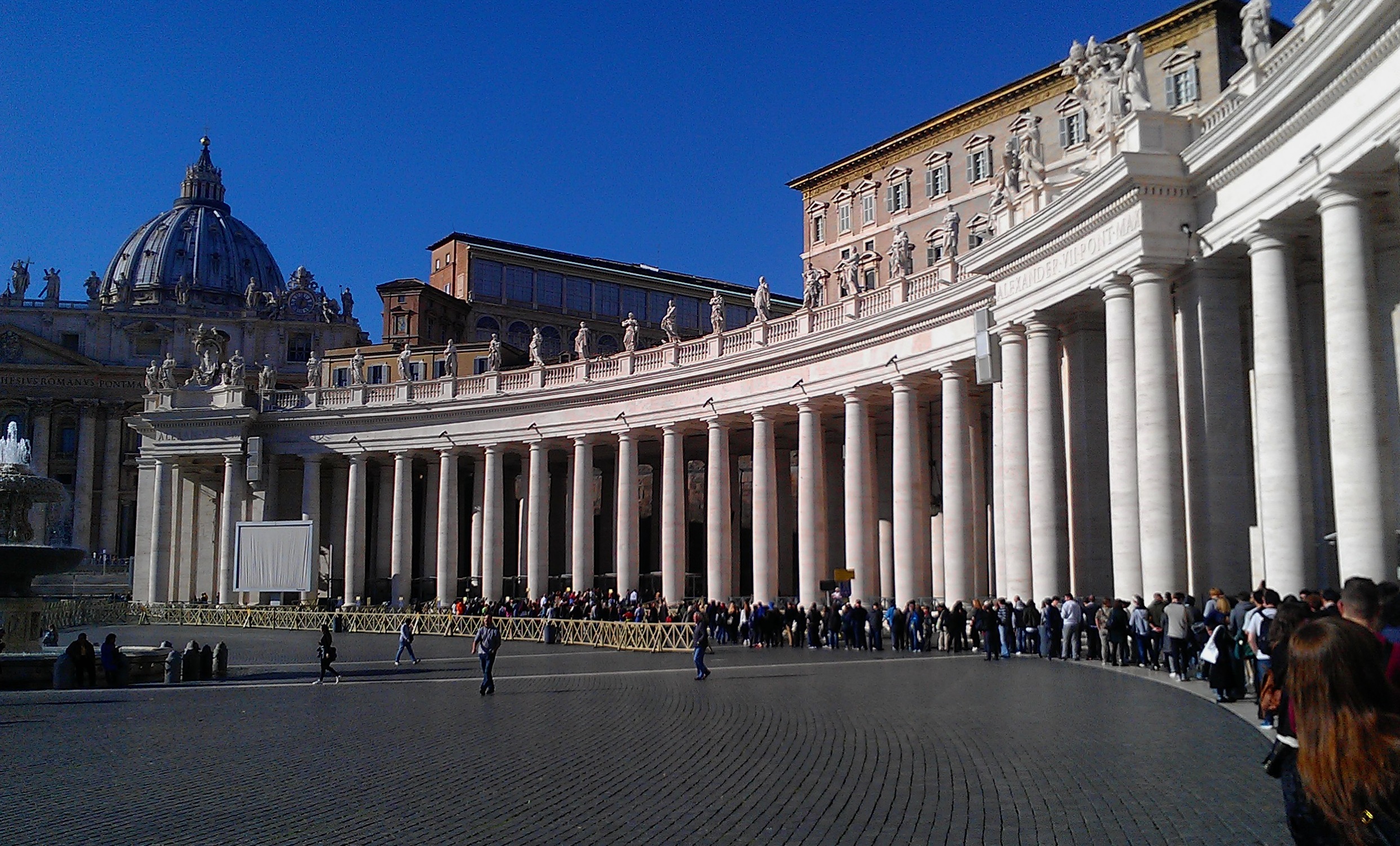
The most famous colonnade in the world is the one in the square of St. Peter’s Basilica in Rome. Gian Lorenzo Bernini designed the square almost 100 years after the Basilica was built, and included massive Doric colonnades—the same types of columns the Guardian was interested in for the superstructure of the Shrine of Bahá'u'lláh—four columns deep, which embrace visitors in "the maternal arms of Mother Church". Source: Wikimedia Commons.
After having discussed the colonnade of the Shrine of Bahá'u'lláh at great length and in detail with Shoghi Effendi during his March – July 1952 pilgrimage, Ugo Giachery prepared a detailed request which laid out the Guardian’s preliminary concept and sent it to Italy for scale drawings and estimates.
After receiving the drawings for the columns with related bases and the capitals, and a reasonable estimate for the work, the Guardian sent a message to the Bahá'í world:
The assistance required for the acquisition of extensive properties, comprising both lands and houses, in the immediate neighborhood of the Most Holy Tomb in Bahjí, and for the embellishment of the approaches of that hallowed Shrine - the Qiblih of the Bahá'í world - as a necessary prelude to the ultimate erection of a befitting Mausoleum to enshrine the remains of God's Supreme Manifestation on earth, must be generously and systematically extended." I well remember how pleased he was when a generous and prompt contribution - perhaps the first to that project - was sent by a loving and dedicated Persian believer. Shoghi Effendi, however, later abandoned the project of constructing this colonnade and concentrated on the embellishment of the surroundings of the Sepulchre of Bahá'u'lláh, including new wrought-iron gates for the entrance to the Shrine on the south side and for the Haram-i-Aqdas.
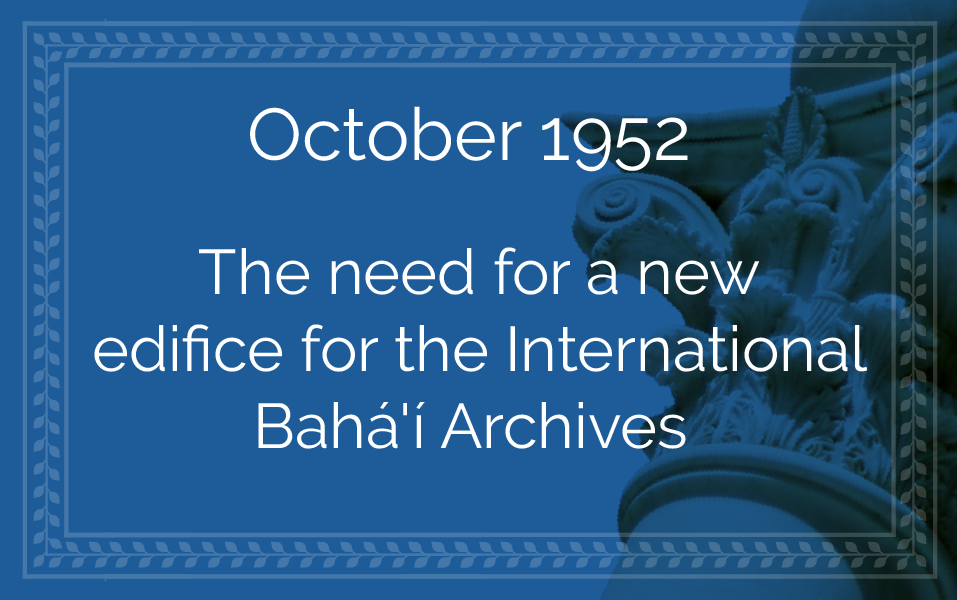
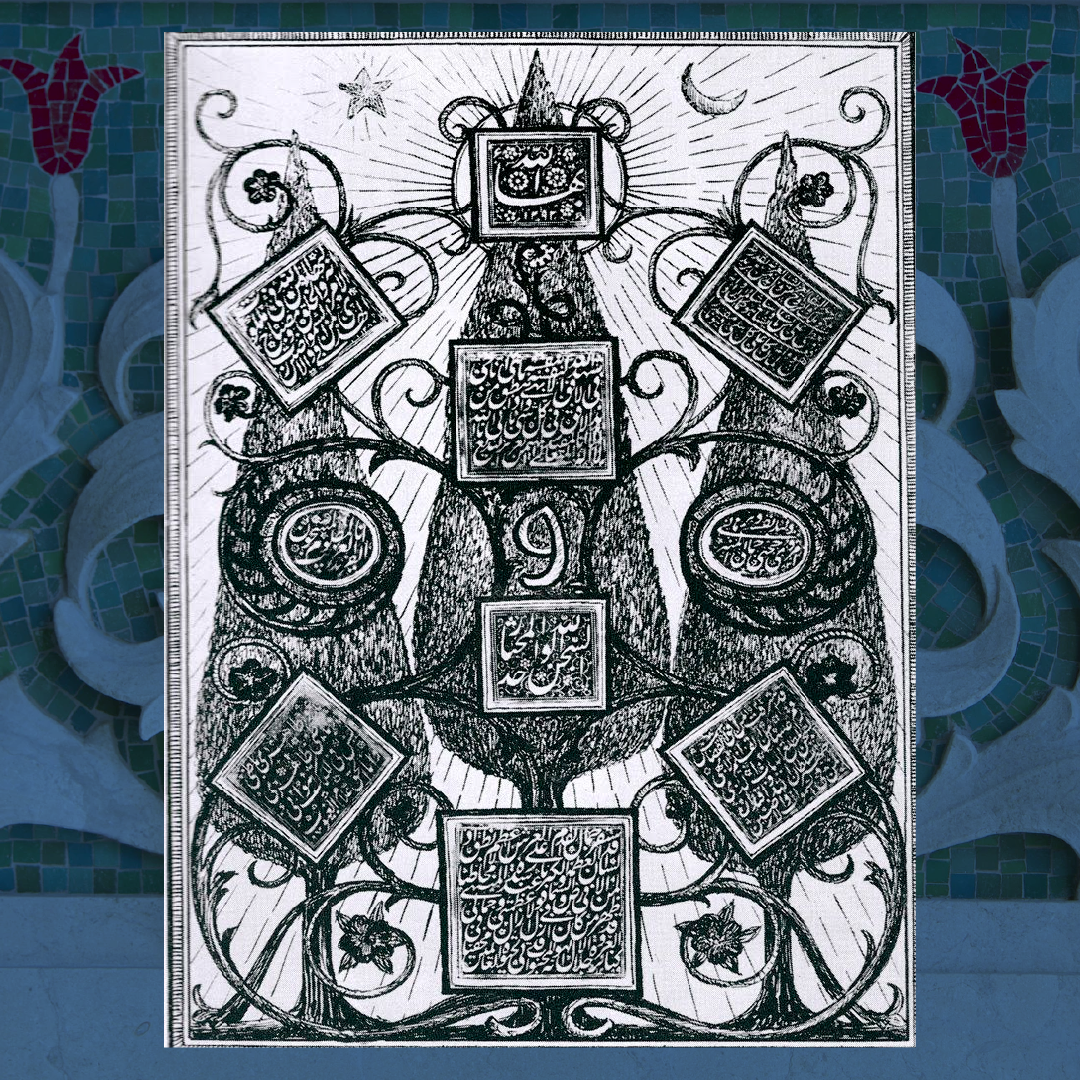
The seals of Bahá'u'lláh arranged in an ornamental Persian design. Source: Bahá'í Sacred Relics. Background: Mosaic and stone design from the Shrine of the Báb, the place of the First International Bahá'í Archives. Source: Bahá'í Media Bank, © Bahá'í International Community 2023.
The Guardian attached the greatest importance to sacred relics of the Heroic Age of the Bábí and Bahá'í Dispensations, and had painstakingly collected with passion, great care, and the utmost meticulousness, over a period of 30 years. These priceless objects were of inestimable, immeasurable worth, and utterly unique to the Bahá'í Faith. No other religion could claim what the Bahá'ís had inherited:
These were not objects. Far from it. They had been associated with Manifestations of God, they had been around their sacred selves for years, sometimes, and at the moment of their death. They constituted as authoritative a record of history as anything else Bahá'ís had inherited from the Heroic Age.
This was why the Guardian chose the International Bahá'í Archives as the first building he would construct on the Arc. The priceless value of the relics the Archives would house forevermore was almost like a gesture of blessing from the Guardian to the Arc, which would, in decades to come, be the seat of the International Institutions of the World Order of Bahá'u'lláh.

The kashkul (alms bowl) of Bahá’u’lláh which He carried with Him for two years during His self-imposed retirement in Iraqi Kurdistan; A taj of Bahá’u’lláh displayed in His room at Bahjí; A prayer by Bahá'u'lláh in His own handwriting; One sheet of “Revelation Writing” by Mírzá Áqá Ján, Bahá'u'lláh’s secretary (reduced from the original size of 35x22 cm). Bahá'u'lláh would dictate so rapidly that in order to keep up, His secretary developed a special shorthand script; Robes of Bahá'u'lláh; Personal items having belonged to Bahá'u'lláh— including locks of hair and tajes; An illumined seal of Bahá'u'lláh; Baha'u'llah's Shawl and Comb; Tablet revealed by Bahá'u'lláh at the time when the Purest Branch was being prepared for the grave in His presence. . All images from Bahá’í Sacred Relics. Background: Mosaic and stone design from the Shrine of the Báb, the place of the First International Bahá'í Archives. Source: Bahá'í Media Bank, © Bahá'í International Community 2023.
A portrait Bahá’u’lláh, the dried blood of the Supreme Manifestation of God, preserved by the Greatest Holy Leaf after a bloodletting, locks of the hair of Bahá'u'lláh, loving collected one hair at a time and carefully arranged by the Greatest Holy Leaf, Bahá'u'lláh’s nightcaps and tall tajes—embroidered headdresses—and His snowy white turban, robes and cloaks worn by Bahá’u’lláh, as well some of His other clothes—shoes, shirts, stockings, and signet rings, the pens, pen cases, the daintily carved silver kashkúl—Ṣúfí dervish alms-bowl of Bahá'u'lláh’s Sulaymáníyyih days, the copper bowls, wooden clogs and towels for Bahá'u'lláh’s baths, Bahá'u'lláh and Ásíyih Khánum’s large framed 1835 marriage certificate, Tablets of Bahá'u'lláh to His beloved wife, to 'Abdu'l-Bahá, and to the Greatest Holy Leaf as well as the precious original manuscript of some of the Hidden Words, all in Bahá'u'lláh’s Own Hand.

An original Tablet of the Báb in His own handwriting in the shape of a five-pointed star, also known as a Haykal; The Marriage Certificate of the Báb, 1258 A.H. (1842 A.D.); The Báb's brazier and samovar; A signet ring of the Bab bearing the inscription: “Praise be unto Him; there is no God but Him. This is a Path revealed by His behest, and shall pass thereon.” Taj belonging to th Báb; Calligraphic exercise of the Báb written before He was ten years old, Green silk robe worn by the Báb; Pocket Qur’án having belonged to the Báb; A small wool reed pen holder which belonged to the Báb; A crystal Persian tea glass and china saucer with rose luster flowers belonging to the Báb; A crystal Persian tea glass and china saucer with rose luster flowers belonging to the Báb. All images from Bahá’í Sacred Relics. Background: Mosaic and stone design from the Shrine of the Báb, the place of the First International Bahá'í Archives. Source: Bahá'í Media Bank, © Bahá'í International Community 2023.
Here are the relics which the Guardian collected pertaining to the Holy Life of the the Báb:
A portrait of the Báb and Bahá’u’lláh, the sacred dust of the Báb procured from the casket in which His remains were preserved for sixty years after His martyrdom, a paisley headdress worn by the Báb, robes and cloaks worn by the Báb, His prayer beads, and signet rings, the original Persian Bayán dictated by the Báb in Máh-Kú to His amanuensis and Letter of the Living Siyyid Ḥusayn, and, finally the original Tablets revealed by the Báb for the 18 Letters of the Living and to Bahá'u'lláh—“Him Whom God shall make manifest.”

Facsimile of Tablet from 'Abdu'l-Baha, in His handwriting, to the friends in America, concerning Dr. Zia Baghdadi, his wife and her sister, 1920; An illumined Tablet of 'Abdu'l-Baha in His handwriting; 'Abdu'l-Bahá’s shoes; A illumined Tablet in the handwriting of 'Abdu'l-Bahá All images from Bahá’í Sacred Relics. Background: Mosaic and stone design from the Shrine of the Báb, the place of the First International Bahá'í Archives. Source: Bahá'í Media Bank, © Bahá'í International Community 2023.
The Guardian also collected precious relics from the life of his Beloved Grandfather:
'Abdu'l-Bahá’s letters to His mother and sister, His binoculars, His travelling bags, and His Arabic-Persian-English dictionary with notes in His own hand on where the accent was to be placed on the English words.

Two facsimiles of the Greatest Holy Leaf’s handwriting; Some relics having belonged to the Greatest Holy Leaf; Plaster from Máh-Kú where the Báb was imprisoned, a cannon ball from the fortress of Shaykh Ṭabarsí, and the sword of Mullá Ḥusayn. All images from Bahá’í Sacred Relics. Background: Mosaic and stone design from the Shrine of the Báb, the place of the First International Bahá'í Archives. Source: Bahá'í Media Bank, © Bahá'í International Community 2023.
Among the few relics the Guardian collected from the life of suffering of his Great-Aunt, Bahíyyih Khánum, were the Greatest Holy Leaf’s head scarfs, clothes, boxes, slippers, combs, dresses, and perhaps, most moving, a brocaded box she succeeded in preserving during her long years of exile and imprisonment, and which had come with her from Persia, the native land she had been exiled from at the age of 6 in 1953, and which she kept with her for 80 years.
Another cabinet contains the relics of Mírzá Mihdí, the youngest son of Bahá'u'lláh and Ásíyih Khánum’s also known as the Purest Branch, martyred on 23 June 1870 when he fell through the skylight in the Most Great Prison. These relics include:
His bloodstained garments, cut away from his martyred and a little pile of pebbles is preserved in this cabinet, which belonged to his early childhood.
The Guardian also collected relics belonging to the Letters of the Living, the heroes and martyrs of the first 77 years of the Faith, its Heroic Age, encompassing the triple ministries of the three Central Figures of the Faith—the Báb, Bahá'u'lláh, and 'Abdu'l-Bahá:
The sword of Mullá Ḥusayn, the Bábu’l-Báb, and hero of Shaykh Ṭabarsí, the simple little turquoise ring of the holy Quddús, a miniature portrait of Bahá'u'lláh’s father, Mírzá Buzurg, a cannon ball, from the ruins of Shaykh Ṭabarsí.

A view of the Arc from the standpoint of the International Bahá'í Archives. Source: Bahá'í Media Bank, © Bahá'í International Community 2023.
By 1952, the Guardian’s collection of relics had overflowed the temporary Archives in which they were presented to the visiting pilgrims. These Archives were spread out in six rooms, three rooms in two separate locations: the three rooms Shoghi Effendi had added at the back of Shrines of the Báb and 'Abdu'l-Bahá, and three rooms in the little house where Shoghi Effendi had placed the remains of Ásíyih Khánum and Mírzá Mihdí for three weeks in 1939 before their re-interment, overlooking the resting place of the Greatest Holy Leaf.
These two locations—referred to as the Major Archives and Minor Archives or the Old Archives and New Archives—had become woefully inadequate for the volume of relics the Guardian had collected, but more importantly, they were completely unsuited to the proper care, preservation and display of the sacred objects.
The Archives needed their own building, and the rooms of the Shrine of the Báb needed to be reverted to their original intended use as additional prayer rooms for increasing numbers of pilgrims
On 8 October 1952, the Guardian had made a historic decision: he decided to build the first of the major edifices destined to constitute the seat of the Administrative Order of the Faith of Bahá'u'lláh on Mount Carmel, and he announced his decision to the Bahá'í World in 12 short words, among a list of many other objectives he had set for himself at the Bahá'í World Centre—the construction of the International Bahá'í Archives was tucked between the Guardian’s announcement for Extension of international Bahá'í endowments in the Holy Land, in 'Akká and on Mount Carmel, and the construction of a befitting resting-place for Khadíjih Bagum, the wife of the Báb in Shíráz.
This was the first inkling the Bahá'í received that the Guardian was planning this major enterprise:
Construction of international Bahá'í Archives in the neighborhood of the Báb's Sepulcher.
YouTube video: A video newsreel of the funeral of Israel’s First President Chaim Weizmann on 10 November 1952.

A photograph of the funeral ceremony of President Chaim Weizmann on 10 November 1952, which the Guardian attended as World Head of the Bahá'í Faith. Source: Wikimedia Commons.
Weizmann was born on 27 November 1874 in Motal, Belarus, then part of the Russian Empire, he was the third of 15 children. In 1892, Weizmann left for Germany to study chemistry at the Polytechnic Institute of Darmstadt and earned his living as a Hebrew teacher.
As a biochemist, Weizmann is considered to be the “father”' of industrial fermentation. instrumental in obtaining the Balfour Declaration—a public statement issued by the British Government in 1917 during World War I announcing its support for the establishment of a home for the Jewish people.
Weizmann became a leader of the British Jewish Community and became the first President of Israel on 16 February 1949, at the age of 75.
Four years later, on 9 November 1952, Weizmann died in office after a long and painful illness, which for some months had left him entirely incapacitated.
The next day on 10 November 1952, Chaim Weizmann was given a State Funeral in his estate at Reḥovot, 102 kilometers south of Haifa, as per his wishes. More than 250,000 people—a crowd of a quarter million people—filed by the decorated stage on which his coffin was placed.
The Guardian was given a seat of honor along with other dignitaries when he attended Chaim Weizmann’s funeral and a radio news bulletin reported the event, introducing “His Eminence Shoghi Effendi Rabbání, world Head of the Bahá'í Faith” as one of the dignitaries present.
The Guardian had, at long last, obtained what he had seeking for 30 years, three long decades: official and public recognition by the State and media of Israel that not only was the Bahá'í Faith an independent religion in Israel, but that he, Shoghi Effendi Rabbání, was recognized as its World Head.

As there is no specific information on which type of gold coin Shoghi Effendi gave Mrs. True, the image above is a symbolic illustration. Photograph showing a 1907 $10 1907 Double Eagle, Liberty Head gold coin. Source: Wikimedia Commons.
Hand of the Cause Corinne True, arrived one day after Shoghi Effendi had returned from Europe with Rúḥíyyih Khánum on 10 November 1952 at the age of 91. It would be her last pilgrimage. Shoghi Effendi welcomed Corinne True with the words:
You’ve come back to your real home.
Little did Corinne know that the most unforgettable moment of her life was about to happen. Shoghi Effendi was exultant at dinner that night, and with the twinkling eyes he always had when he was about to tease someone, he asked Corinne True:
I understand, Mrs. True, you had something to do with the Temple in the United States. Didn’t you have something to do with the money?
Corinne True had been confused at first because she knew the Guardian knew about her role with the Mother Temple of North America, Bahá'ís affectionately called her “Mother of the Temple,” but she answered:
Yes, I received the money and was the financial secretary.
Shoghi Effendi pulled out a wallet and gave it to Corinne True, saying:
This is a billfold which 'Abdu'l-Bahá carried when He was in America, and I know you will treasure it knowing that it comes from Him.
Corinne True was overwhelmed. She had been very close to 'Abdu'l-Bahá and spent a lot of time with Him during his Journey to America in 1912. She pressed the wallet to her forehead and tears gathered in her eyes. Obviously moved, as was everyone seated at the table, the Guardian gently said to her:
Why don’t you open it and see what’s in it?
Corinne True began fumbling with the wallet, so Shoghi Effendi told her:
Let me open it for you.
She looked inside and told Shoghi Effendi:
It’s a gold piece.
Now just take it out and look at it.
Corinne True took out the gold coin and looked at it, when the Guardian said:
Now, what’s the date of it, Mrs. True?
Corinne True looked at the date on the coin and said:
1907.
The Guardian said:
That’s the date of your first visit to the Holy Land to visit 'Abdu'l-Bahá. And this was a gold coin, which 'Abdu'l-Bahá had.
Leroy Ioas witnessed this extraordinary scene himself, and he marveled, for years afterwards, that with everything that was weighing on the Guardian at that time, he had found the time to give Hand of the Cause Corinne True such a gift, taken the time to look for the wallet, the find a coin dated 1907 to place inside it. Such immense love, such extraordinary tenderness.

Photograph of Corinne True. Source: Bahaimedia.
At dinner that night, the Guardian enthusiastically spoke about the upcoming Ten Year Crusade—which will be addressed in great detail in Part XVIII—and asked Corinne True if he was being too ambitious. She responded that had to hurry home because there was so much to do, but the Guardian’s eyes were still twinkling when he suggested another option to her:
Go ahead and work with your daughters—in Europe, Africa, Asia, and the islands, even Tibet, you can pioneer to any one of those places.
Shoghi Effendi suggested to Corinne that she could direct her efforts to forming effective teachers of the Cause, and described her with an unusual term no one had ever heard before. He called Corinne True a “spiritual politician,” explaining:
You have learned to be spiritual and at the same time to get things done.
One could say, with twinkling eyes, that this described the Guardian perfectly.
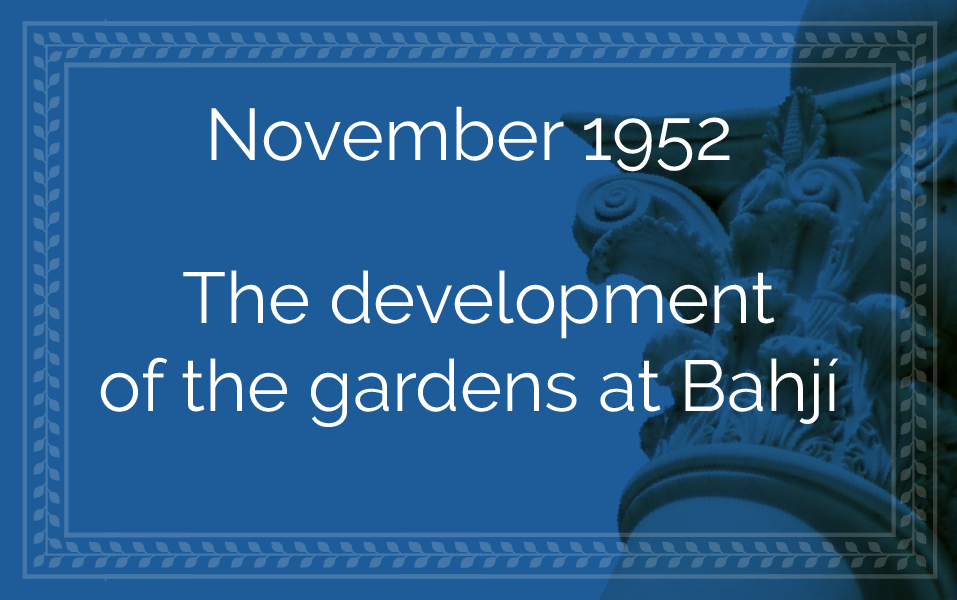
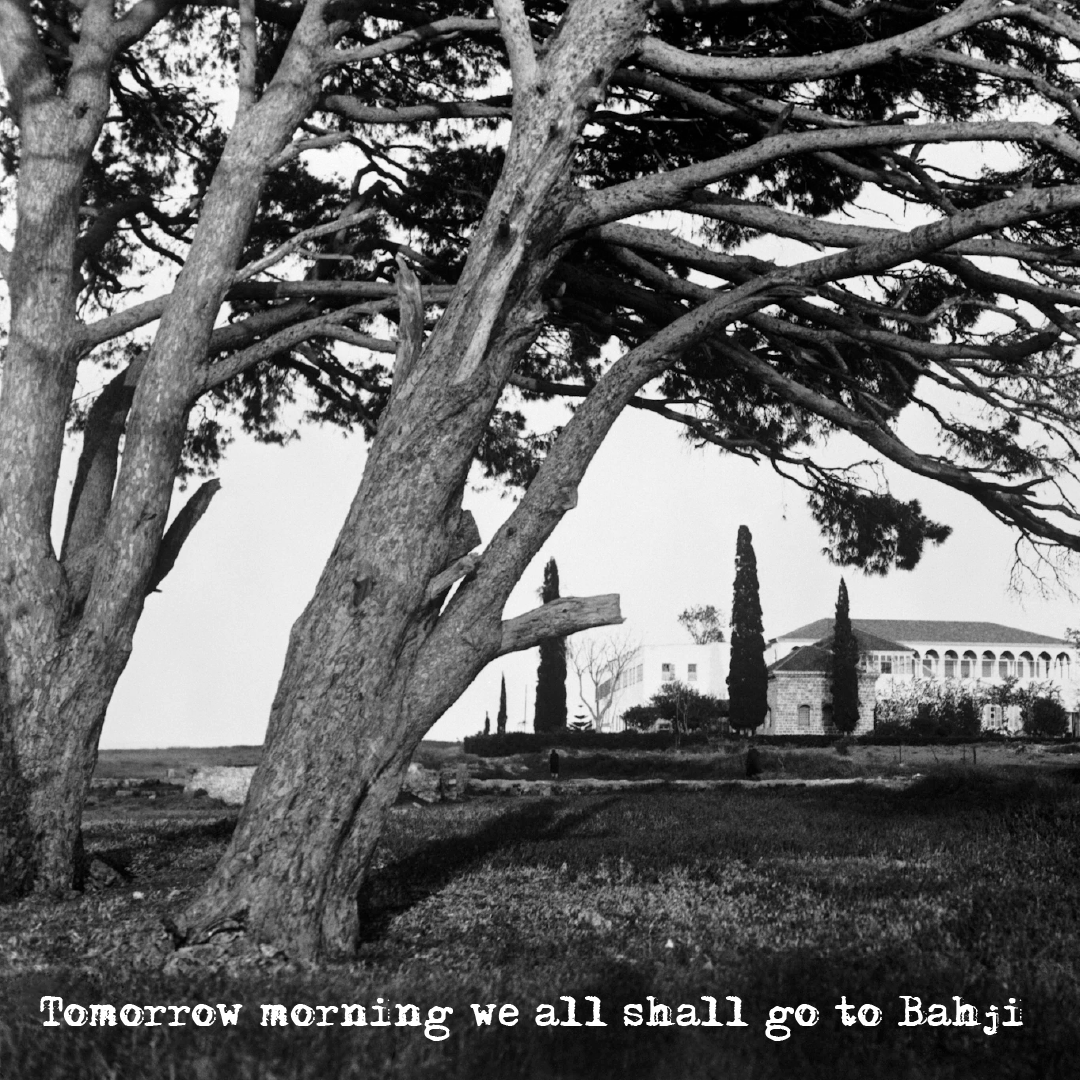
Shrine of Bahá’u’lláh, Mansion of Bahjí and surrounding area in the 1930s, before Shoghi Effendi redesigned the gardens and the Ḥaram-i-Aqdas. Source: Bahá'í Media Bank, © Bahá'í International Community 2023.
The evening before the Guardian had officially obtained the Baydún land at Bahjí, he arrived at the dinner-table with an expression of inner joy and determination on his face. He greeted everyone at the table, and before they started their meal, he looked around and said:
Tomorrow morning we all shall go to Bahjí; I am asking every available man to be there, as we have some very important work to do.
Those few words inaugurated a week of intense labor that would transform Bahjí from the sea of sand it currently was into a heavenly garden of incomparable beauty.
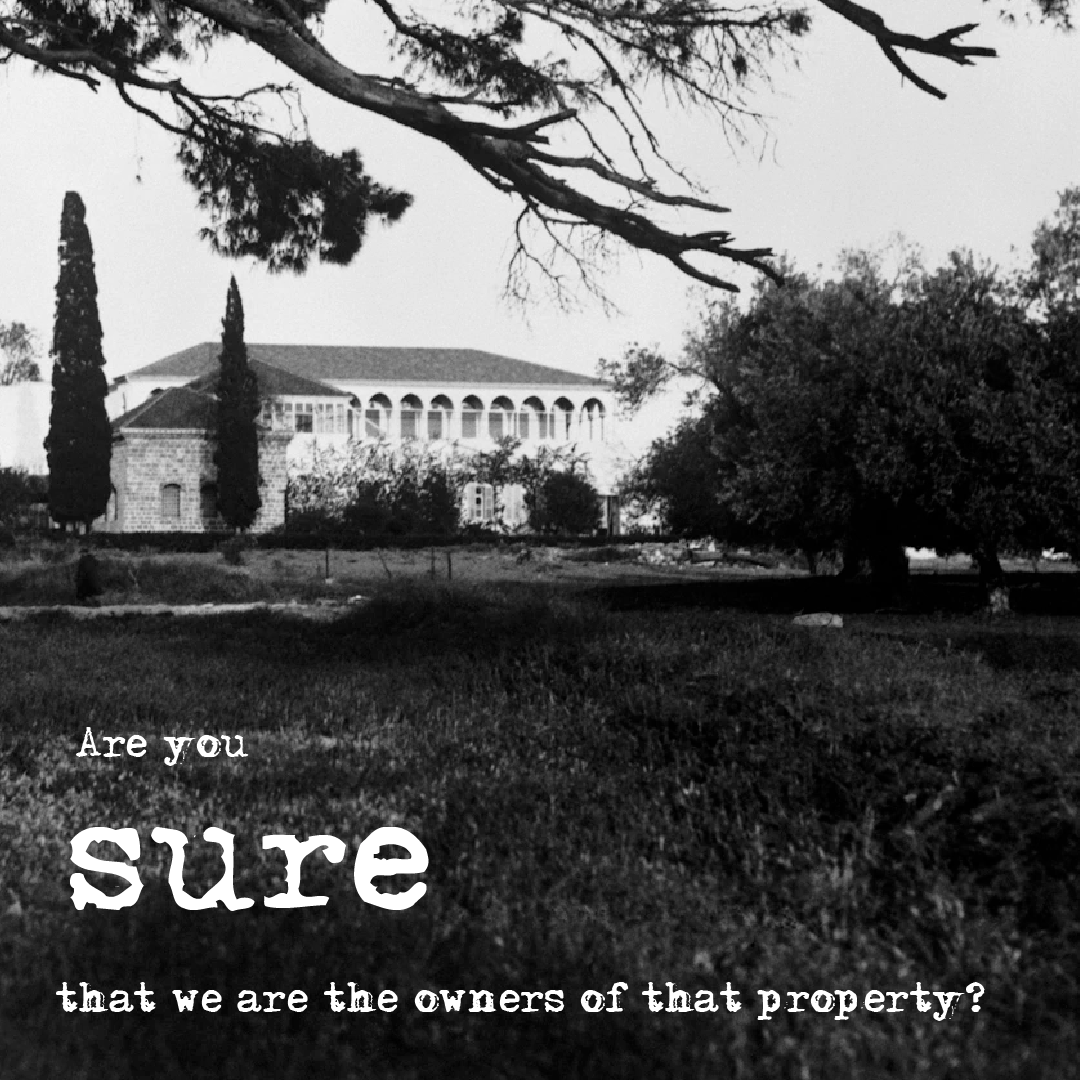
Closeup of the Shrine of Bahá’u’lláh, Mansion of Bahjí and surrounding area in the 1930s. Source: Bahá'í Media Bank, © Bahá'í International Community 2023.
Larry Hautz and Leroy Ioas’s most priceless contribution by far in this mission was successfully negotiating the exchange with the Israeli Government of the 35 acres of the Dhikru’lláh land in Galilee for the 40 acres of the Baydún estate which abutted Bahjí.
Two factors greatly facilitated this sensitive negotiation.
The first was that Dhikru’lláh’s three loyal and devoted children, Ḥasan, Faríd, and their sister—grandchildren of Mírzá Muḥammad Qulí, Bahá'u'lláh's faithful half-brother—spontaneously offered their land to the Guardian when he needed it. The Guardian compensated them for their faithfulness and generosity by enabling them to purchase fertile land in another location. Ḥasan and Faríd were expert farmers and had a very good reputation in the Jordan Valley.
The second was that Golda Meir had once been a schoolteacher in Milwaukee, Larry Hautz’s home town. Golda Meir was a towering figure in Israeli politics. On 14 May 1948, she had been one of the 24 signatories of the Israeli Declaration of Independence, and by 1952, she was a member of the Knesset—the Israeli Parliament—as Labor Minister.
Golda Meir had been very impressed that the Bahá'ís had not fled during the War of Independence, and she was instrumental in helping Larry Hautz and Leroy Ioas with the land exchange.
On 12 November 1952 at 9 in the morning, Shoghi Effendi’s secretary, Leroy Ioas, signed a contract with the Government of Israel in the office of the land development in Tel Aviv.
The binding contract officially exchanged the 35 acres of Dhikru’lláh’s land in Ein Gev for 40 acres of the abandoned Baydún land at Bahjí, and stated Shoghi Effendi could take immediate possession of the property. Leroy Ioas quickly drove to Haifa, and sent a note to Shoghi Effendi who arrived to meet him at lunch at the Pilgrim House. Shoghi Effendi asked many questions about the transfer:
Are you sure that we are the owners of that property? That it is now ours?
Leroy Ioas confirmed:
Here is the contract, Shoghi Effendi, you can go and do anything you want with that property, right now.
There was no need for Leroy Ioas to repeat himself. Shoghi Effendi took immediate action.
There were still houses occupied by Covenant-breakers on the grounds of Bahjí, and their story ends in 1957.
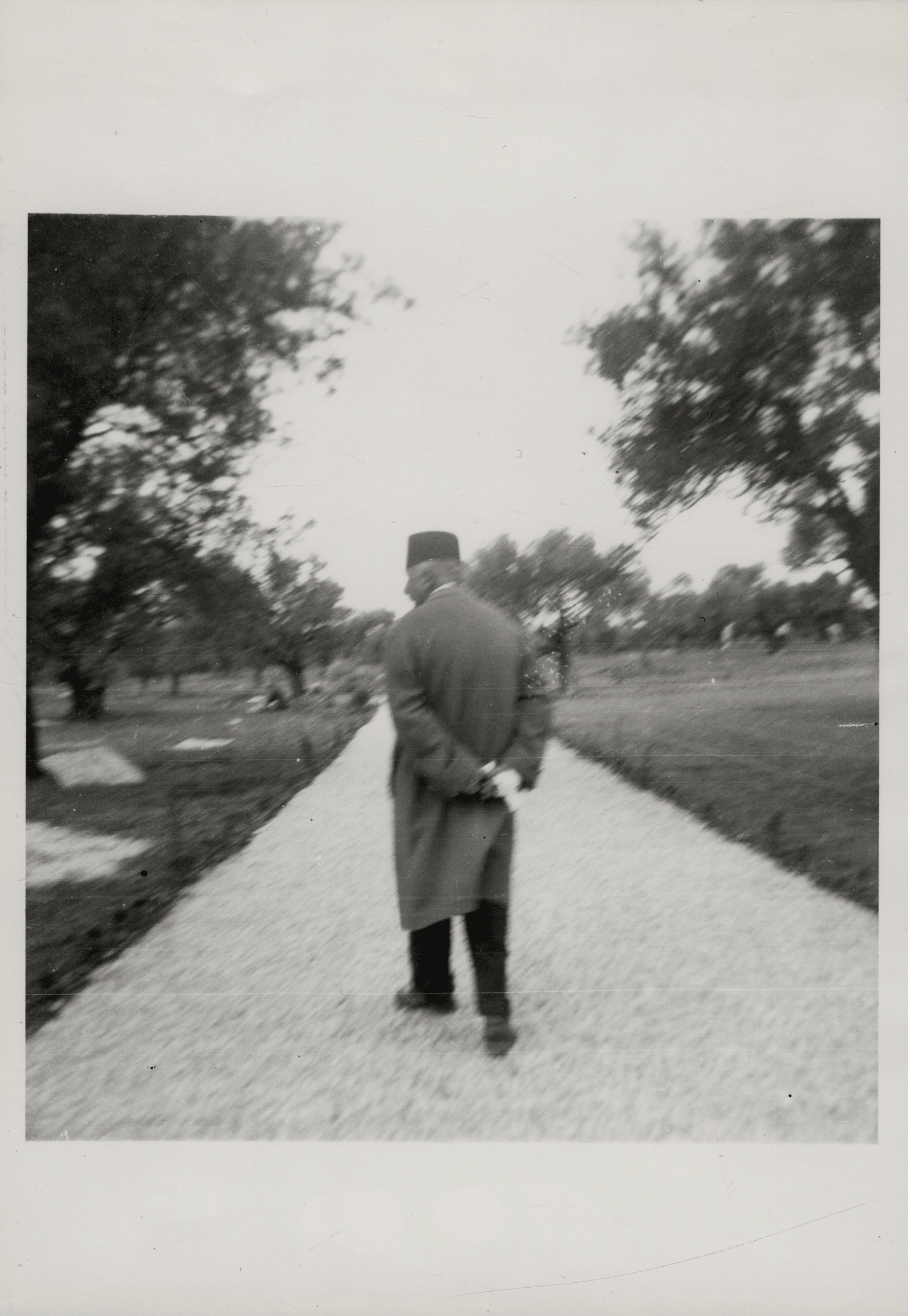
Shoghi Effendi surveying the work in the gardens at Bahjí. Source: © United States National Bahá'í Archives, used with permission.
By 2 PM on the same day the contract was ratified, Shoghi Effendi was being drive to 'Akká.
He told Leroy Ioas:
'Abdu'l-Bahá for fifty years wanted to beautify that Shrine; ever since the passing of 'Abdu'l-Bahá, I have wanted to beautify that Shrine as the Master wanted it done, and now that we have the property, I will not lose five minutes in starting work.
Shoghi Effendi had the creative instinct of a true artist, and worked fueled by inspiration which shaped his organic design work, never tethered to any preconceived idea. The best example of this capacity of Shoghi Effendi’s is in his development of grounds and gardens around the shrine of Bahá'u'lláh, two hours after he became the legal owner of Bahjí.
When the Guardian arrived at Bahjí, every able-bodied Bahá'í and local worker was present. Shoghi Effendi had rented a bulldozer to level the wild part of the property, a quarter of the huge circle around the Shrine and facing its entrance. Such a large quantity of earth was being scraped and dug up as the ground leveling was taking place, that Shoghi Effendi had the idea to push all the extra earth to the east and create a high embankment, which still exists today, and would provide anyone standing on it with the same inspiring view he had from the top of his small building.
Anxious to get perspective on the entire grounds, Shoghi Effendi climbed up on a ruined one-room building at the edge of the site, and the height made such a difference, that he had the building repaired, added a wooden staircase leading to the roof, and furnished the interior to use as an onsite office.
With this new vantage point, Shoghi Effendi was inspired with a completely new perspective on his plan.

Top photograph: Shoghi Effendi walking up pathway to Bahjí which he has just laid down with two white strings on either side of the pathway. Source: Bahaimedia. Bottom photograph: Current pathway that Shoghi Effendi was building in the photograph above. Source: Bahá'í Media Bank, © Bahá'í International Community 2023.
Assisted by his chauffeur, carrying a ball of string and wooden pickets, Shoghi Effendi began to trace nine paths, radiating like the rays of a sun 130 degrees around the Shrine of Bahá'u'lláh, to a circular path 110 meters away, where all the paths ended, together forming the effect of a quarter burst of sunrays.
The gardeners began to dig small trenches along all the paths the Guardian had outlined with string, and planted hedges of thyme.
Eight of the paths Shoghi Effendi traced were all the same width. The ninth path was the widest, leading straight to the door of the Shrine of Bahá'u'lláh. With a joyful expression on his face, Shoghi Effendi said:
Finally, we have a dignified way to reach the Shrine, the approach to which I shall further beautify.

There are no images of the leveling of the ground at Bahjí as the Guardian began planting the gardens, but this is a photograph of the ground being leveled in Kampala, at the site of the House of Worship for the African continent, during the same decade. Source: Bahaimedia.
Then, the Guardian gave the order to tear down a group of small, dilapidated buildings which were cluttering the south end of the space between the Mansion of Bahjí and the Shrine of Bahá'u'lláh. This rubble, along with stones that came from demolished were used to build a level platform in front of the Mansion on the side of its main entrance.
Everyone was in high spirits, swept up by Shoghi Effendi’s energy and they worked fast, fully conscious of the sanctity of the work they were doing to beautiful the Most Holy Precincts, the Ḥaram-i-Aqdas, which had so often been blessed by the footsteps of Bahá'u'lláh and 'Abdu'l-Bahá.
Every single man present had a job. Ugo Giachery’s was helping Shoghi Effendi trace the paths and the star-shaped flower beds, and he was so entranced with the Guardian’s speed of decision making, his confidence and resolution in giving life to the vision he held in his creative mind, in finally accomplishing his long-cherished dream that Ugo Giachery had no eyes for anyone else but the Guardian for the entire time the project lasted.
There has to exist a word stronger than magic for the forces that were at work during those unforgettable days, alchemy perhaps, enchantment, certainly, and grace. The Guardian was creating beauty in a hundred different places at once, the garden was appearing directly from his mind onto the sacred, hallowed grounds, rising from the earth through the sheer infallible will and indomitable determination of the Guardian.
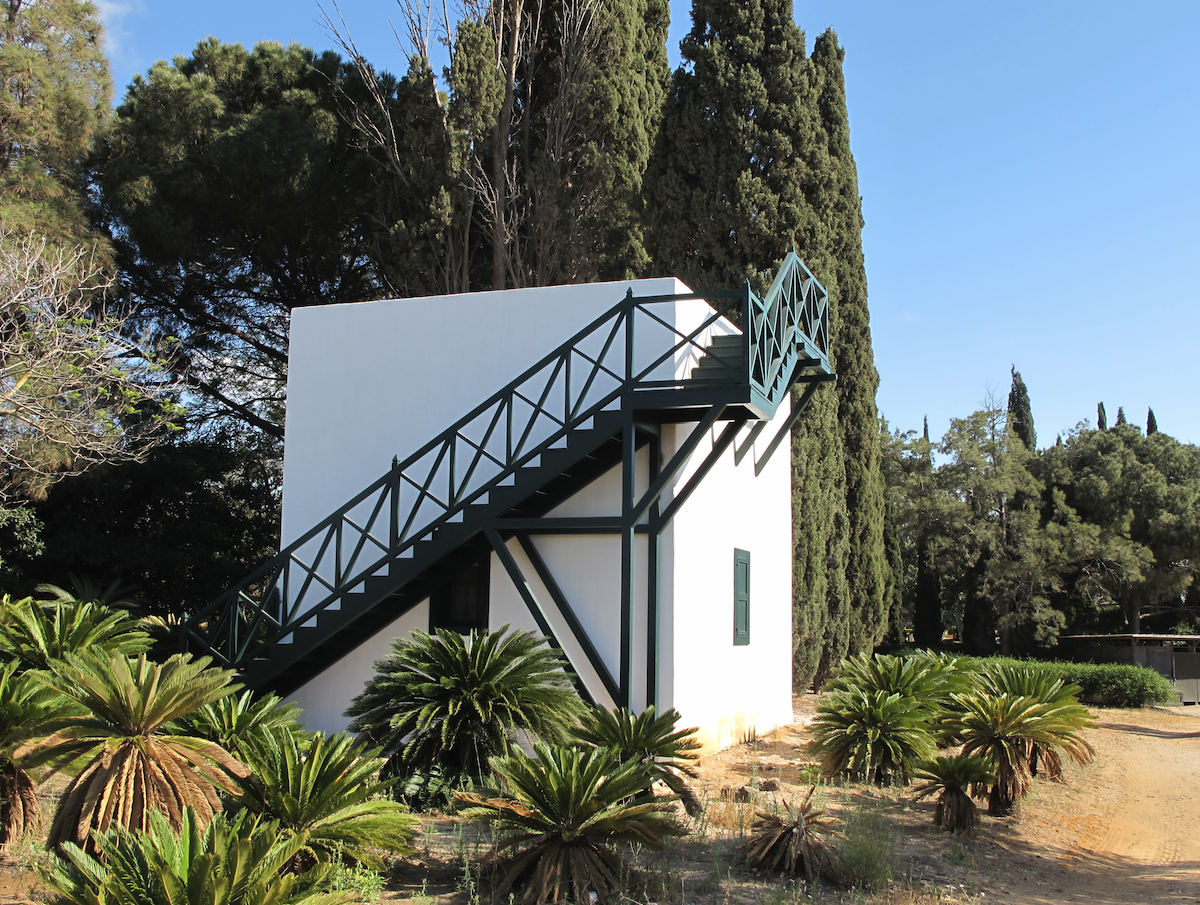
The Guardian’s workroom at Bahjí, photograph taken in 2014. Source: Reflections on the Bahá'í Writings.
As mentioned previously, Shoghi Effendi found an extremely effective way to supervise the construction work on the grounds at Bahjí by standing on the roof of a small building which had served as a utility space for the Nasif Hawwa’s olive groves.
With the intervening months, Shoghi Effendi had formalized this arrangement. He converted the storage shed into an onsite office space, he fitted the roof to make it into the ideal observation platform by having built a little wooden staircase that led to the flat roof.
Shoghi Effendi had furnished the inside of the very small office space with tables for his drawings and sketches and decorated by hanging maps on the wall.

Shoghi Effendi surveying newly-laid plans in the gardens at Bahjí. Source: Bahaimedia.
Shoghi Effendi moved quickly between the workers, directing, advising, counselling, cautioning, encouraging, explaining, demonstrating how to do apparently impossible things, and rejoicing in the transformation of Bahjí under everyone’s astonished eyes.
There was an afternoon drizzle that day, but Shoghi Effendi would not leave the grounds, not after having waited 30 years to realize his dream of finally, at long last embellishing the Ḥaram-i-Aqdas. His adamantine determination to be as productive as he could, for as long as he could, until he had completed his task, could not be stopped by such an insignificant detail as bad weather.
The Guardian ordered markers and trees removed. These had been placed by the Baydúns when they were refusing to sell and wanted to obscure the Shrine and the Mansion in their stubborn refusal to allow Shoghi Effendi to purchase their land or extend the gardens around the Shrine.
Young trees were brought in and planted along the paths, the outer circular path was lined with trees on both sides to create, in time, a wide tree-bordered path for circumambulation.
Shoghi Effendi had iron gates, steps, stone decorations, flowers, flowering plants, top soil and grass seeds brought in from Haifa, from Mt. Carmel, from the Riḍván Garden, and from the Master’s House, and had them all installed and planted.
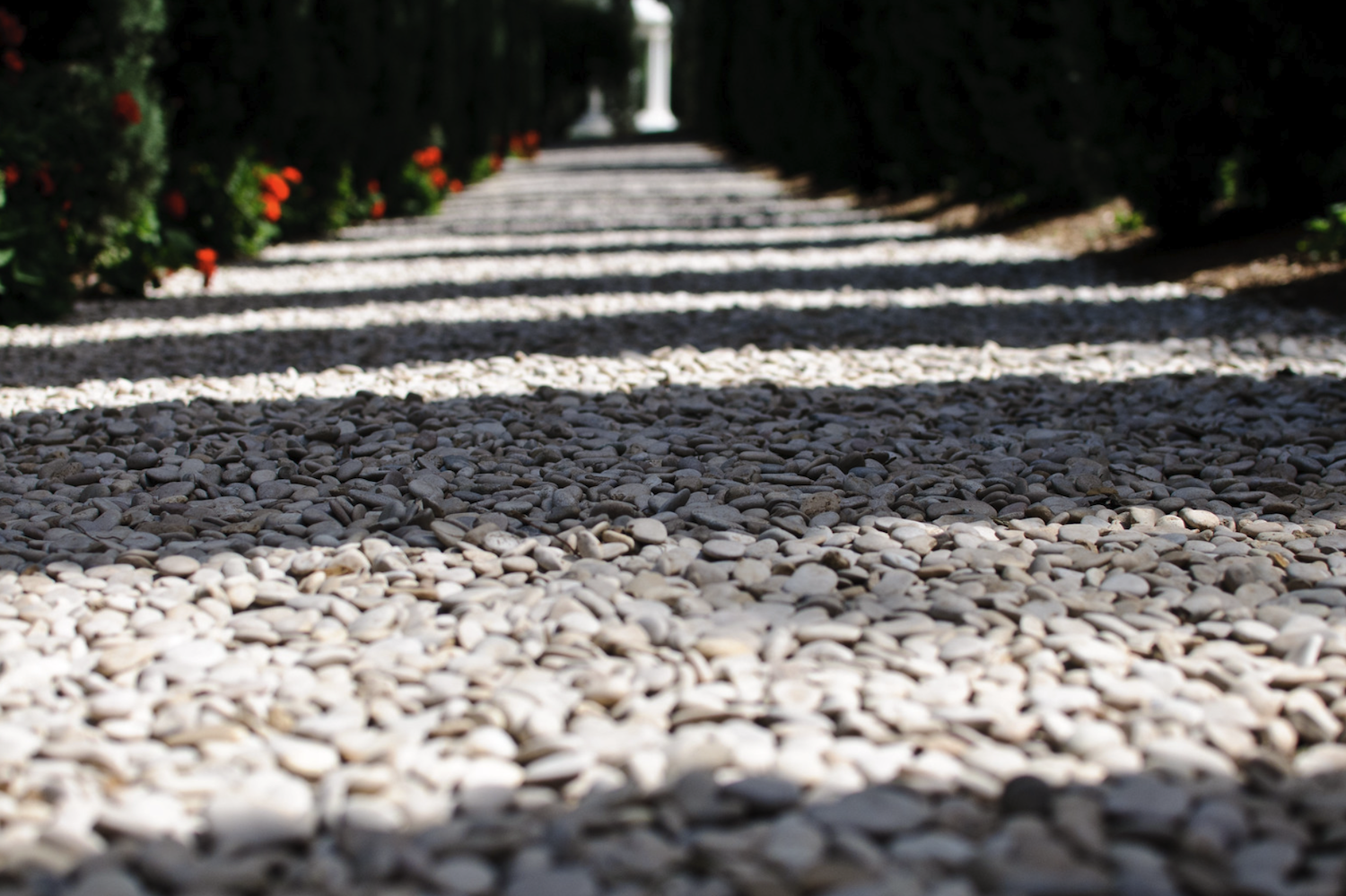
A closeup of the perfectly round, perfectly smooth pebbles, found on the shores of the Sea of Galilee and nowhere else on earth, which the Guardian loved and ordered sent to Bahjí. Source: Chad Mauger’s Flickr page, © Chad Mauger, used with permission.
It was vital to Shoghi Effendi to pave the direct path leading to the entrance of the Shrine of Bahá'u'lláh with the most befitting material. At first, Shoghi Effendi had thought of using white Carrara marble, but the cost was prohibitive and the marble’s exposure to the ruthless sun in the Holy Land would have damaged the fragile material.
Instead, Shoghi Effendi opted for a local material, not found anywhere else on earth, the small white pebbles from the Sea of Galilee, which he had already used on the path between the second and third gates leading to the Shrine of the Báb on Mt. Carmel, and at the house of 'Abdu'l-Bahá at 7 Persian Street.
In November 1952, while he was busy embellishing the Ḥaram-i-Aqdas, he instructed the Bahá'í farmers in ‘Adasiyyíh to send him a hundred sacks of small, smooth, very white pebbles which could only be found in one place, on a beach on the shore of the sea of Galilee, a few kilometers north of ‘Adasiyyíh. The Bahá'ís prepared the pebbles, packed them into sacks and shipped them to 'Akká.
These exceptionally beautiful, one-of-a-kind pebbles can still be found bordering the outer perimeter of the Shrine of Bahá'u'lláh, surfacing the last straight path in a direct approach to the door of the Shrine, after approaching and inside the very Shrine, in its inner sanctum, on the ground of its central atrium, amidst ethereal, aerial plants.
The first time Ugo Giachery laid eyes on these pebbles, he was entranced by their whiteness and the regularity of their shape and size and the thought crossed his mind that the Holy Land had, from her bosom, provided the perfect and most befitting stepping ground for the blessed feet of Jesus Christ and His fishermen apostles.

The monumental work completed by Shoghi Effendi in four days, the accomplishment of the vision he described in detail to Ugo Giachery on 4 March 1952. Source: Bahá'í Media Bank, © Bahá'í International Community 2023.
Shoghi Effendi developed a cold during the night, but was back at work in the morning, as if nothing had happened, feverish and suffering, but nonetheless ploughed through his work on the second, third and fourth day, not letting illness stop him or even slow him down.
He had too much to do.
Shoghi Effendi ordered the ground leveled, trees and borders planted, gave a hundred different orders, attended to a hundred other details, each held in the firm grasp of his mind.
The sand at Bahjí was disappearing.
The rubble of the torn-down buildings had been covered with rich soil, and Shoghi Effendi had planted hedges and flower beds, placed pedestals and ornaments throughout the gardens.
The spiritual quality of deference was innate in Shoghi Effendi, an innate quality in the Holy Family, and he understood more intensely than anyone else the quality of sacredness and sanctity. As soon as Shoghi Effendi’s work was completed, the lawns and flower beds planted, the beautiful red paths completed, and lamp posts installed, Shoghi Effendi moved his meeting 100 meters away from where it usually took place, “out of respect for the Shrine.”
By the end of the fourth day, the Guardian had created and implemented a design for the gardens, personally supervised all of the work and all the workers, leveled the ground, raising it by one meter, drawn paths, destroyed buildings and created a terrace with their rubble, uprooted trees and planted new ones, planted hedges, shrubs, flowers, and grass, built a road, installed lighting, created terraces, placed garden ornaments.
The Guardian had created a formal garden 12.5 meters wide and 80 meters long in four and a half days, almost exactly as we know it now. It was a herculean, superhuman task, so single individual could have performed this feat except the Guardian of the Cause.
The Ḥaram-i-Aqdas had not only been cleansed and purified from the stain of four decades of Covenant-breaker presence, but the Guardian had created a heavenly paradise, a beautiful, fragrant garden of delight, befitting the Holy of Holies, befitting the Qiblih, the holiest place on earth for Bahá'ís befitting the Shrine of Bahá'u'lláh.
He had transformed a sandy wasteland into the sacred precincts of the Holiest spot on earth for Bahá'ís, and a beauteous, entrancing garden had appeared as if by magic, looking as though it had always been there.
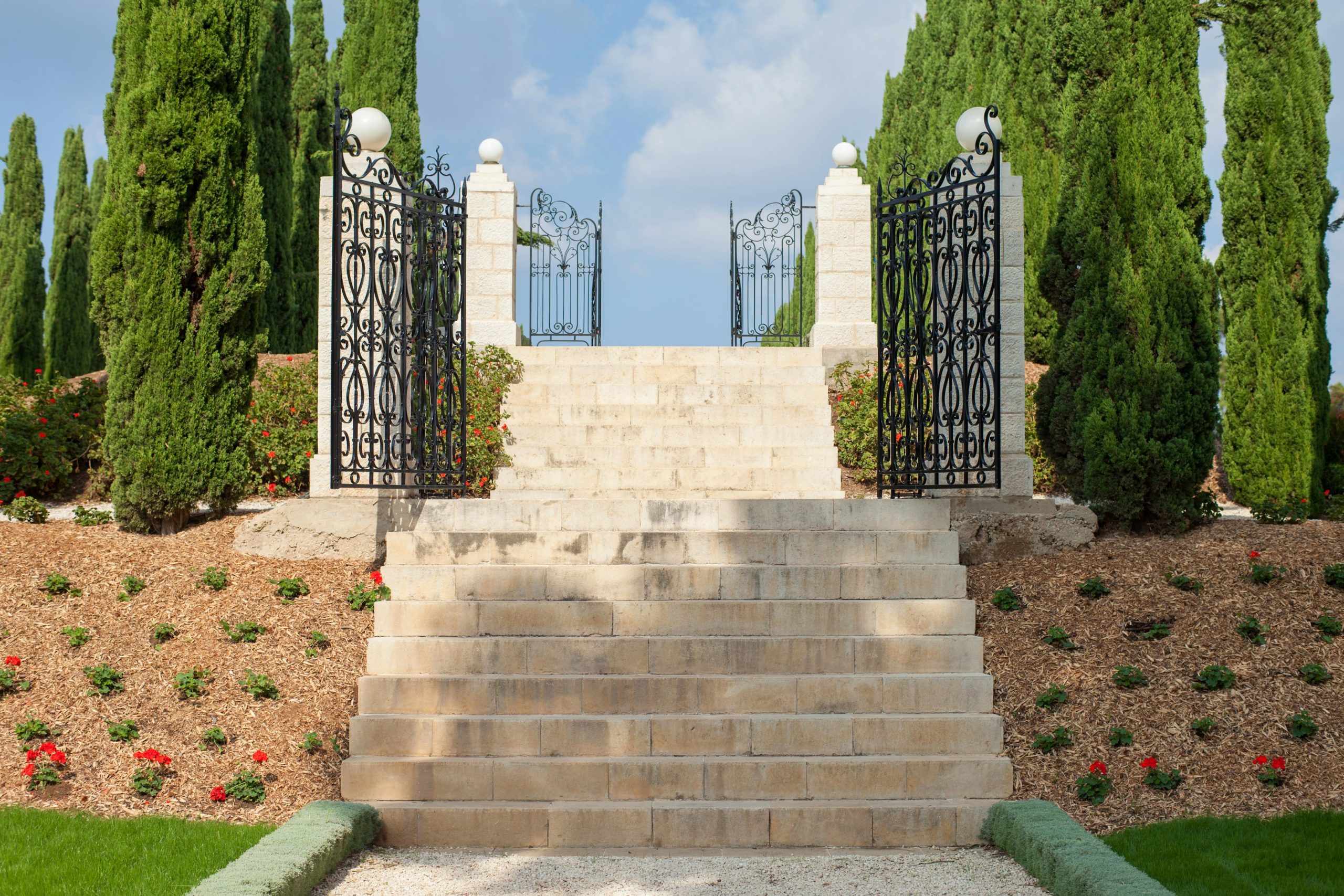
The gate mentioned in the story below was not found, but this is a photograph of two gates opening onto the garden terrace at Bahjí. Source: Bahá'í Media Bank, © Bahá'í International Community 2023.
In the days which followed the completion of the gardens at Bahjí, Shoghi Effendi arranged for the gate—which had originally been intended for the first terrace on Ben Gurion Avenue leading up to the Shrine of the Báb—to be placed at the end of one of the nine paths radiating from the Shrine of Bahá'u'lláh.
The Guardian singled out this particular path because it had often been blessed by the footsteps of Bahá'u'lláh. It ran through high trees and provided shade and a cool breeze to refresh the Blessed Beauty during the hot summer months.
This gate, with its wrought-iron side panels fenced the western side of the new garden which had been built on the rubble of the torn-down buildings, and was supported by a durable Italian granite called Breccia of Brescia, an ancient and noble material which had been used in Italy for centuries.
The old 'Akká aqueduct crossed Bahjí at the time, and would have been on the direct path of the Italian gate that Shoghi Effendi was planning on erecting. The Israeli Antiquities Department gave the Guardian a permission to cover over this section of the aqueduct.
Later, the Guardian added more steps, pedestals, delicate columns and other ornaments of fine Italian marble.

The door to the Shrine of Bahá'u'lláh. Source: Bahá'í Media Bank, © Bahá'í International Community 2023.
The original entrance door to the Shrine of Bahá'u'lláh—many decades old—was made of a hard, sturdy wood with metal hinges and a handmade lock. Not only was the door not beautiful—it was very, very plain—, it wasn’t really functional. It was a double door and the two doors were misaligned by several degrees, so the door looked crooked.
The Guardian decided it was time to replace the door to the Holy of Holies.
Shoghi Effendi sent Ugo Giachery a sketch of what he envisioned, along with a request for him to send him back a scale drawing and a cost estimate.
Ugo Giachery knew exactly where to go.
In Italy, Tuscany—one of its central provinces—was famous for the world-class skill and pure talent of its artisans. Ugo Giachery traveled to Pistoia, Tuscany and started going around to architects and artists, until he found Saiello Saielli, a reliable carpenter and cabinet-maker and a renowned expert on wood.
Mr. Saielli took it upon himself to stringently select the proper kind of well-seasoned oak, with the finest grain, free of any blemishes or imperfections. Seasoned wood is wood that has had one to two years to dry after being felled, and with a low moisture content.
Because of 'Akká’s particular climate—very dry and very hot in the summer, very wet and very humid in the winter—the new door’s frame had to be built with layers of wood so the space between the layers would help the door frame compensate for temperature and humidity variations without warping. A solid wood door frame would crack or warp.
Before and during the door’s construction, Ugo Giachery visited Mr. Saielli in Pistoia to consult on technical details: the decorative motifs, the finishing, the quality of the oak, copper nails, the bronze lock and the hinges.
The Guardian had designed the French doors of the Shrine—the name for double doors that both open—with a beautiful motif in four panels, and a base plinth—the bottom of the door.
Each of the four panels on each of the doors contained a nine-petalled rosette at the center, with turned-up edges, wooden half-globes distributed evenly along the edges of the doors, decorative nails, borders around the rosettes, four triangle wedges around each rosette.
To make sure the floral panels would be perfect, Mr. Saielli and Ugo Giachery had them created first from clay, then gypsum, so the carver would have a perfect model to copy.
Once the door was finished and varnished, and the rosettes, half-globes, decorative triangles and decorative nails were all in place, they were all gilded by hand.
The door was installed at the entrance of the Shrine of Bahá'u'lláh with ball-bearing hinges placed under and above the half-doors to avoid the inconvenience of bronze hinges.
The Guardian absolutely loved Bahá'u'lláh’s door.
Ugo Giachery describes the Guardian’s feedback:
I was not in Haifa when the door arrived, but I soon learned that the beloved Guardian was overjoyed by its simplicity, perfect execution and highly decorative beauty, and he gave instruction to have it put up at once; a cable of appreciation came in the days following, bringing much cheer to my heart.
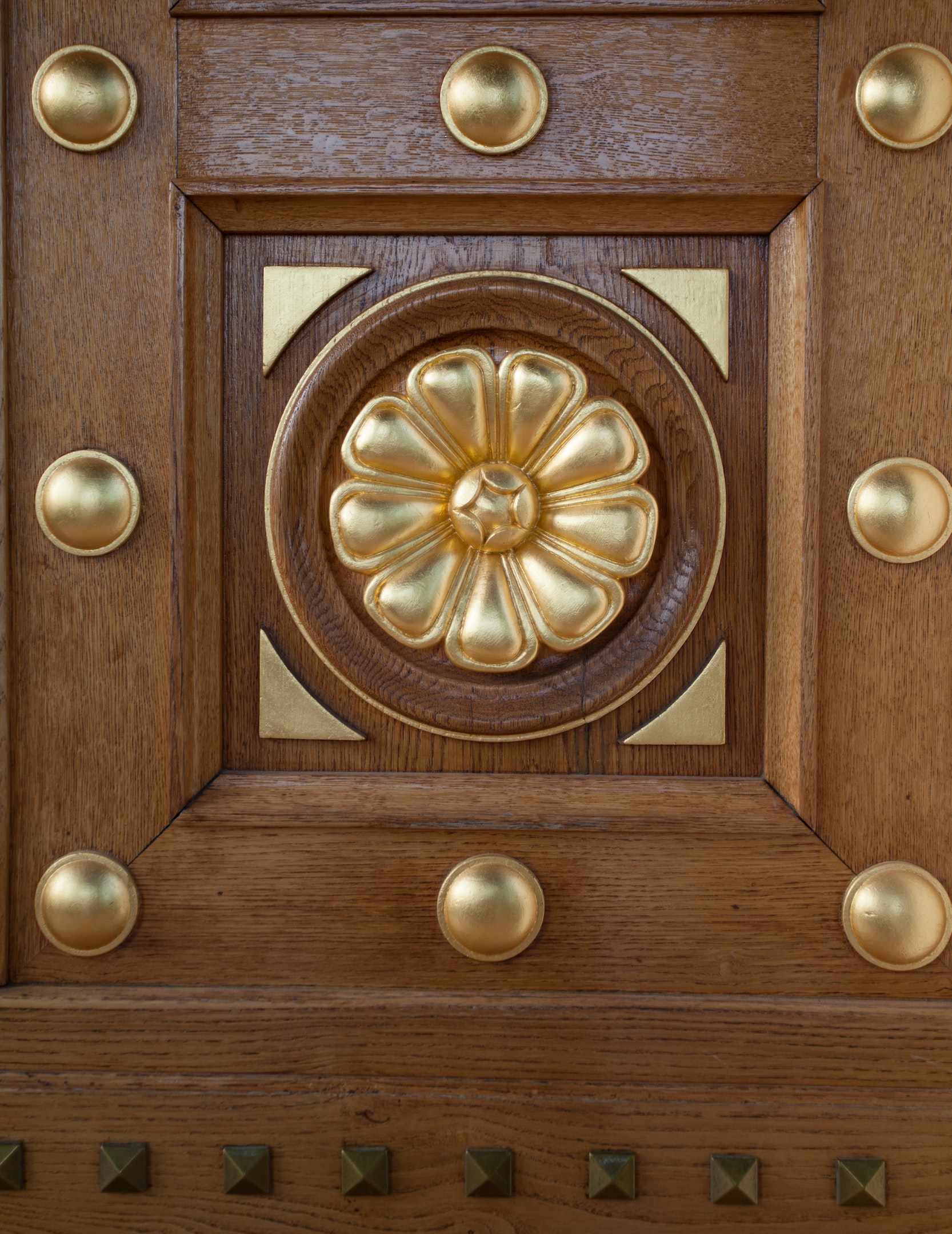
Source: Bahá'í Media Bank, © Bahá'í International Community 2023.
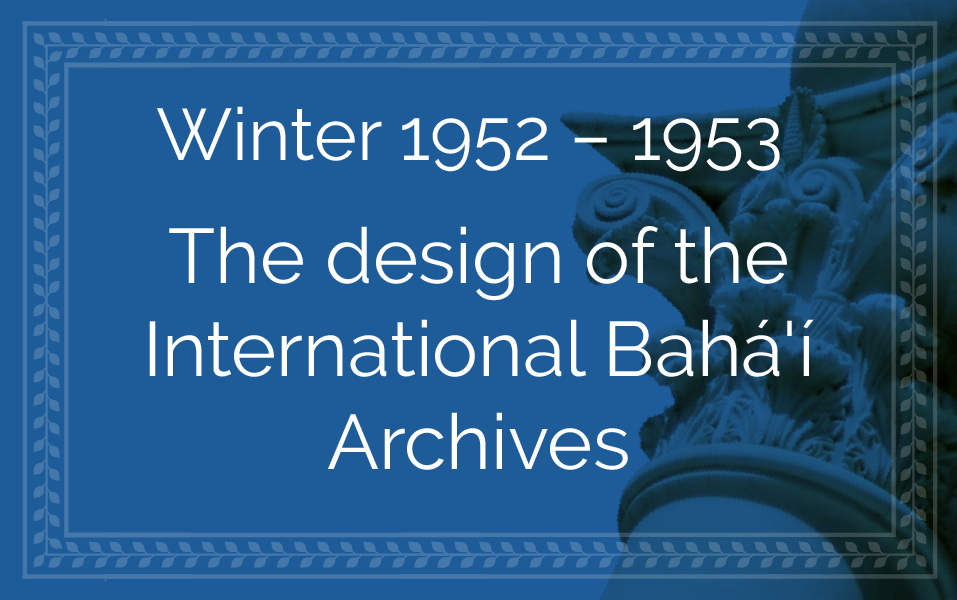
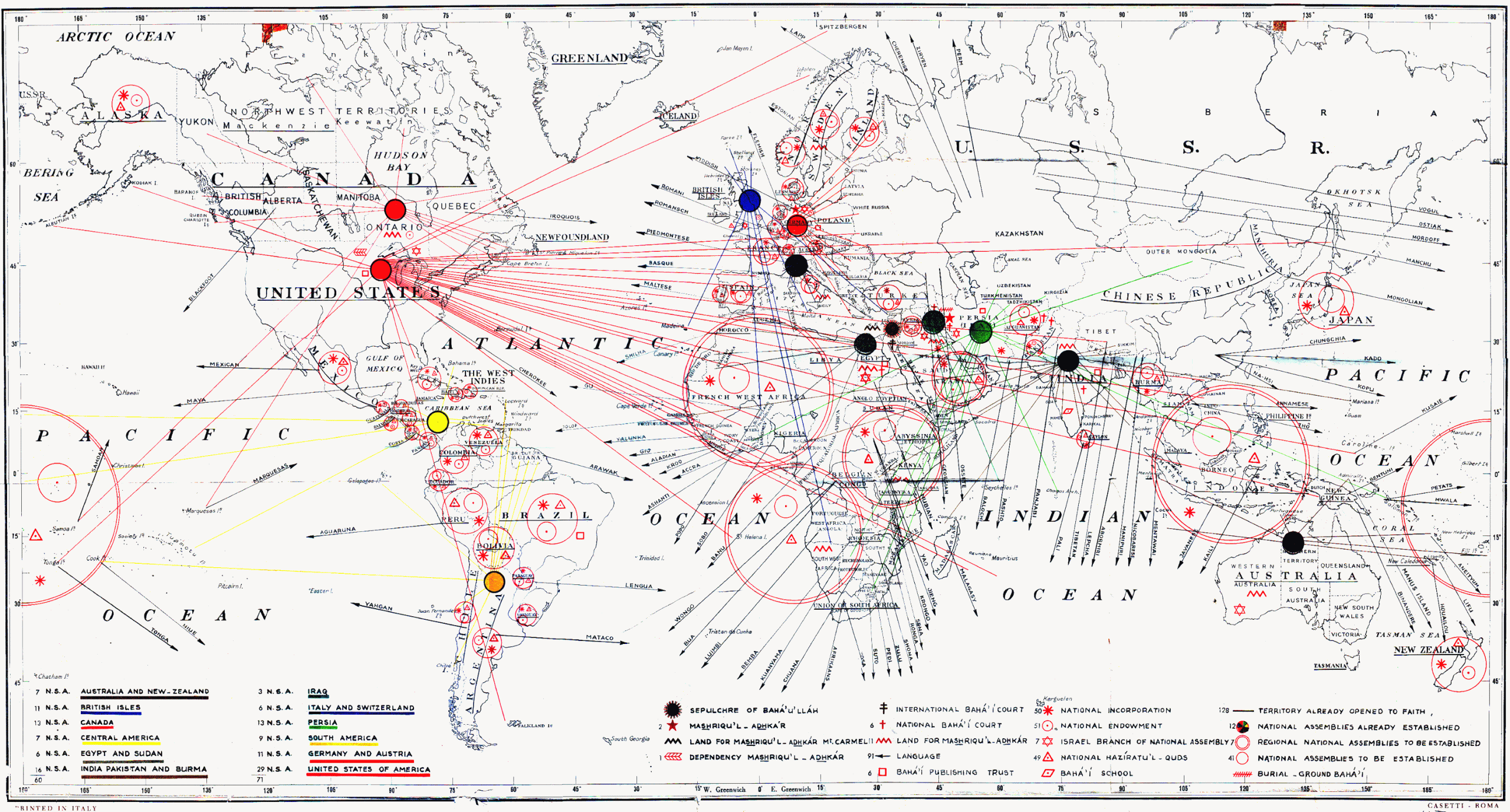
The Guardian’s first map of the Goals of the Ten Year Crusade. Source: Bahá'í Library Online.
Ugo Giachery twice had the privilege of handling the reproduction of two maps Shoghi Effendi had drawn himself for the Ten Year Crusade: one representing the Guardian’s goals in The Ten Year Crusade, and the second one displaying the Crusade’s progress in the second one. Both of these maps were drawn by Shoghi Effendi in his own hand, and they represented the entire world, including the Arctic and Antarctic regions.
Shoghi Effendi was a skilled map-maker and artist and he used symbols, lines, colors, and legends to create maps that condensed on one single flat surface about 96 centimeters by 55 centimeters, the entire content of at least 100 pages of printed data.
Shoghi Effendi sent the first map through a pilgrim traveling to Italy at the end of 1952, and instructed Ugo Giachery to reproduce it in time to be included with the Guardian’s statistical booklet The Bahá'í Faith 1844 - 1952: Information Statistical and Comparative, which would be published simultaneously in London and in Wilmette.
The Guardian also intended this map be displayed in all four Intercontinental Teaching Conferences held in Kampala, Chicago, Stockholm and New Delhi in 1953, and for the twelve National Bahá'í Conventions to be held in April 1953.
Italy was a very Catholic country in 1952, and Italian printers were reluctant to print anything which the Church of Rome might disapprove of, so Ugo Giachery had to be very careful and cautious in undertaking this work for the Guardian. Ugo Giachery was turned down several times. Through sheer divine assistance, he was able to locate a firm which agreed to do the very specialized work of map-printing, which, at the time, required special machinery that was not easily accessible.
The men working at the plant were fascinated by the map and asked veiled questions, and although did not understand the importance of the map or its contents, It is interesting to recall the curiosity of various men assigned to the work at the printing plant, they knew they were working on something special.
At the time, in late 1952, there was a law stating that anything printed in the country needed to be turned over to the police in triplicate copies, and this reassured the printers. As soon as the first copies of the map were printed, Ugo Giachery sent them to the Guardian who immediately acknowledged receipt with a cable of thanks and paise.
The Guardian asked Ugo Giachery to do a second printing of the map in the spring of 1953.
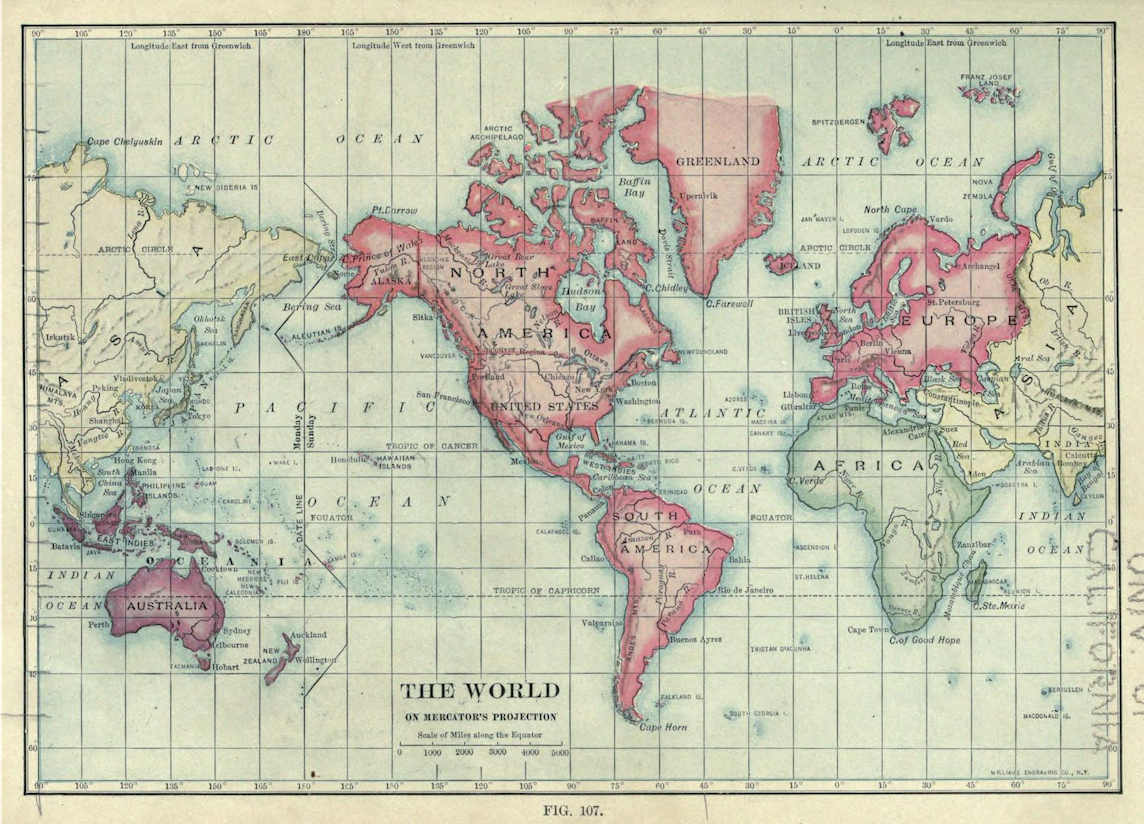
Shoghi Effendi’s love of maps was generational. 'Abdu'l-Bahá also loved maps, and this world map is Figure 107 between pages 86 and 97 of World Geography: One-volume edition by Ralph Stockman Tarr, and Frank Morton McMurry (1912), 'Abdu'l-Bahá’s geography book which He used as a reference when He was revealing the Tablets of the Divine Plan to the various regions of the United States, and listing every country in the world.
Shoghi Effendi loved maps his entire life.
When he was 17 and 'Abdu'l-Bahá was traveling in North America, Shoghi Effendi was busy in Beirut making a map of his Grandfather’s travels and writing in a letter:
I have pretty near finished the map of the United States of America. It is a very picturesque and beautiful map. Please send me the list of the cities of the United States visited by our Lord in order one after the other. I will be then able to locate them in the map.
Two years after this, 'Abdu'l-Bahá had consulted the Tarr and McMurr World Geography atlas to refer to every region in the world in His Tablets of the Divine Plan. 'Abdu'l-Bahá and Shoghi Effendi shared so many passions, and it is touching thinking of 'Abdu'l-Bahá perusing this world atlas in the springs of 1916 and 1917, revealing the Tablets of the Divine Plan, and to think of Shoghi Effendi, who would spend the rest of his life as the Guardian, prosecuting using the Charter of the Tablets of the Divine Plan to create his own maps.
Ella Bailey, 89 years old and in very poor health, yearned to pioneer and the Guardian encouraged her. She left California in the opening months of the Ten Year Crusade and arrived in Tripoli, Libya on 20 July 1953. Ella Bailey died one month later, on 26 August 1953. When Shoghi Effendi learned about Ella Bailey’s death, he elevated her to the rank of martyr, and placed a gold star on Tripoli, the place of her death, on one of his maps.
Just like with the gold star of Ella Bailey, Shoghi Effendi’s maps were sensitive, spiritual works. He used color codes to mark important or significant events, like a recent acquisition, to differentiate it from older properties, and he was painstakingly exact in drawing maps, slaving over the minutest of details with astonishing concentration.
Shoghi Effendi’s maps told the greatest story: the story of the progressive unfoldment of Bahá'u'lláh’s Faith over the entire planet. It was thrilling for the Guardian to make update after update to his maps of the Ten Year Crusade, he would work indoors, intently working on his maps through illnesses, through vacations, through sunny days, through a burnt-out brain, through tired muscles, through strained eyes, through his adoring wife Rúḥíyyih Khánum’s insistence that he rest.
No power on earth was strong enough to stop the Guardian from working on his beloved maps.
When he died, Shoghi Effendi was working on his last map, his last gorgeous work of cartography, which he had called “The half-way point of the Ten Year Crusade.” He had asked Rúḥíyyih Khánum to bring a table into his room large enough so he could spread out his map and he worked at it for hours, with the last ounces of remaining strength he had, checking data with Rúḥíyyih Khánum before marking it down, showing the worldwide progress of the Ten Year Crusade, until, finally, his body gave out and he passed away.
The eagle above the pillar marking the Guardian’s resting place is poised on a map.
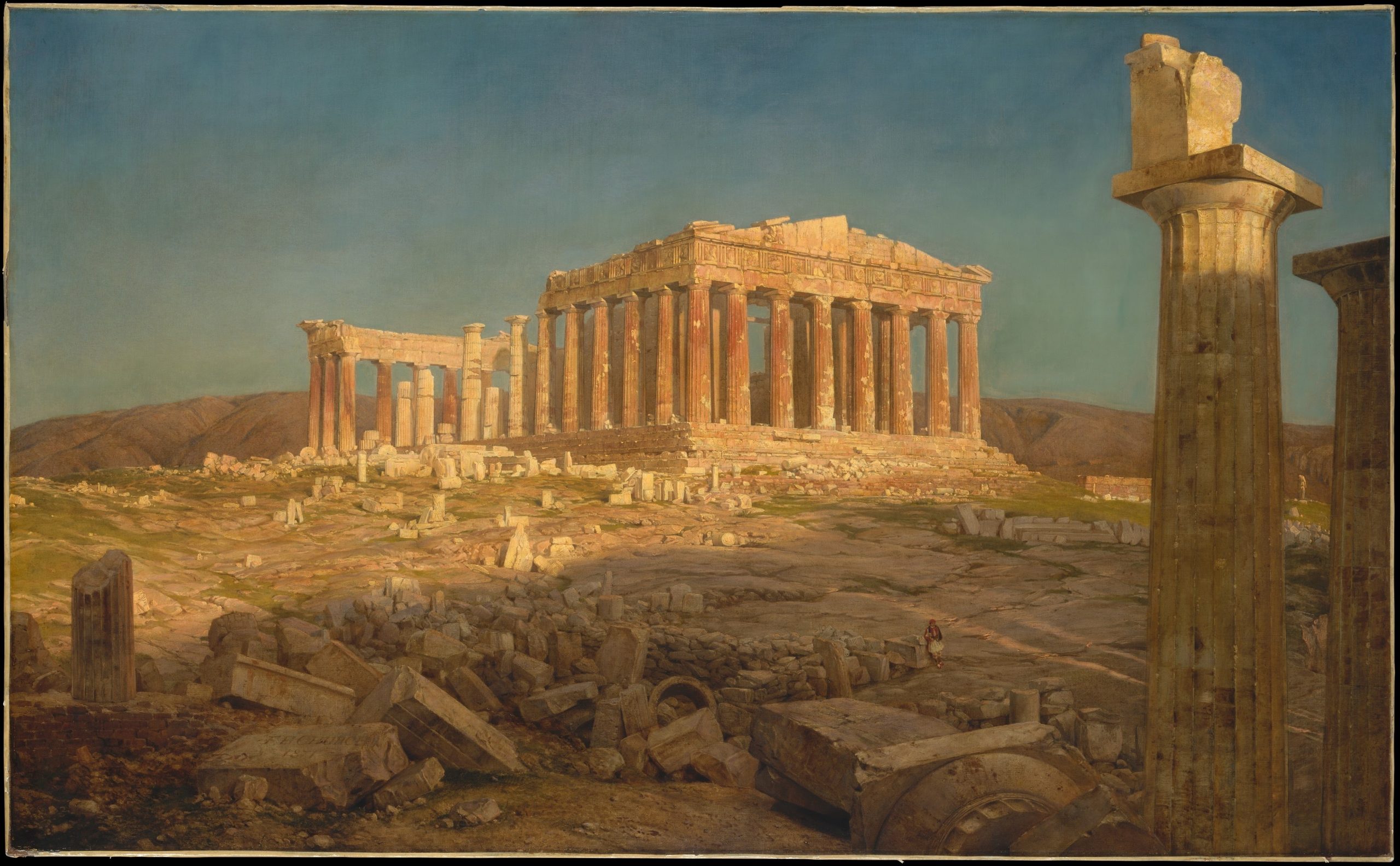
The inspiration for the International Bahá'í Archives: The Parthenon by Frederic Edwin Church (1871). Source: The Metropolitan Museum of Art.
In choosing the design for the International Bahá'í Archives, Shoghi Effendi was guided by three things: it had to be beautiful, it had to be dignified, and it had to be timelessly elegant.
The Guardian had always admired the Parthenon, and its graceful proportions, which fed his inspiration in conceiving the International Bahá'í Archives. When Leroy Ioas asked the Guardian why he had chosen the Parthenon, the Guardian replied:
The Greek style is beautiful. It has withstood the test of time and has remained beautiful for over two thousand years.
When the Guardian designed the superstructure of the Shrine of the Báb and the International Bahá'í Archives, there was no such thing as purely “Bahá'í” architecture, and so the Guardian believed classical styles which had stood the test of centuries of millennia were preferable to experimental architectural styles which might be outdated in a matter of decades.
Because the Guardian—despite his innate creative and artistic talent—had never formally studied art, he freely mixed styles and eras in his architectural designs and interior decoration, which, in the end, did create a unique “Bahá'í” style of architecture: The Guardian’s signature style. Rúḥíyyih Khánum beautifully described Shoghi Effendi’s artistic sense:
The major criterion of beauty is proportion. The sense of this was one of Shoghi Effendi’s strongest characteristics…his unfailing instinct of the proper relationship of one thing to another, the balance that delights the mind and eye, is constantly revealed.
The perfection of the International Archives building would set the stylistic standard for all the future edifices erected on the Arc.
In the winter of 1952, the Guardian had made his final decision on the dimensions of the International Bahá'í Archives, and he asked Hand of the Cause Mason Remey, an architect trained in Paris, to produce preliminary drawings.
Several months later, when Leroy Ioas was in Paris, he decided to measure the church of La Madeleine, the 8th arrondissement of the French Capital. La Madeleine is an architectural masterpiece in the neoclassical style, a Catholic parish church of perfect proportions built in 1828, also inspired by the Parthenon, which was also the Guardian’s inspiration for the International Bahá'í Archives.
The only measuring tool at Leroy Ioas’ disposal were his two feet, so he paced around La Madeleine and obtained his measurements. The reason Leroy Ioas took this very interesting initiative was because he knew his Guardian, and he knew that the constructions of the Archives would, sooner or later, eventually fall under his purview and he wanted to be prepared. Working with Shoghi Effendi had trained him, like a chess grandmaster, to think several moves ahead.

An undated photograph of Hand of the Cause Amatul'Bahá Ruḥíyyíh Khánum speaking on the radio. Source: The Bahá'í World.
On 29 December 1952, Hand of the Cause Amatu’l-Bahá Ruḥíyyíh Khánum was interviewed in the English section of an Israeli radio broadcast, giving an interview on the Shrine of the Báb.
The presenter opened the broadcast by introducing the Bahá'í Faith and saying that Israel was not only the home of Judaism, Christianity, and Islám, but of a fourth religion, the Bahá’í Faith. He then asked Rúḥíyyih Khánum to comment, and she obliged by explaining Bahá'u'lláh’s successive exiles and His arrival in 'Akká on 31 August 1868.
Rúḥíyyih Khánum explained that the overarching objective of the Bahá'í Faith was the attainment of universal world peace, and listed Bahá'í principles, explaining how Bahá'ís conducted their administration through elected Local and National Spiritual Assemblies, and that Shoghi Effendi Rabbání was the World Head of the Bahá'í Faith, and, in time, would be the Head of the Universal House of Justice.
Rúḥíyyih Khánum also explained that the Bahá'ís had Holy Places in Israel and that was the reason so many Bahá'ís traveled here on pilgrimage, as well as to meet Shoghi Effendi face to face.
In the next part of the broadcast, Rúḥíyyih Khánum and Leroy Ioas were interviewed in front of the gardens of the Shrine of the Báb. The host asked Leroy Ioas a number of questions about the gardens and the Shrine of the Báb, and in conclusion, Rúḥíyyih Khánum spoke briefly about the Báb’s life, His Martyrdom, and how His remains were hidden from place to place for 71 years until’ ab finally interred them in the Shrine on Mount Carmel which He had built for that purpose.
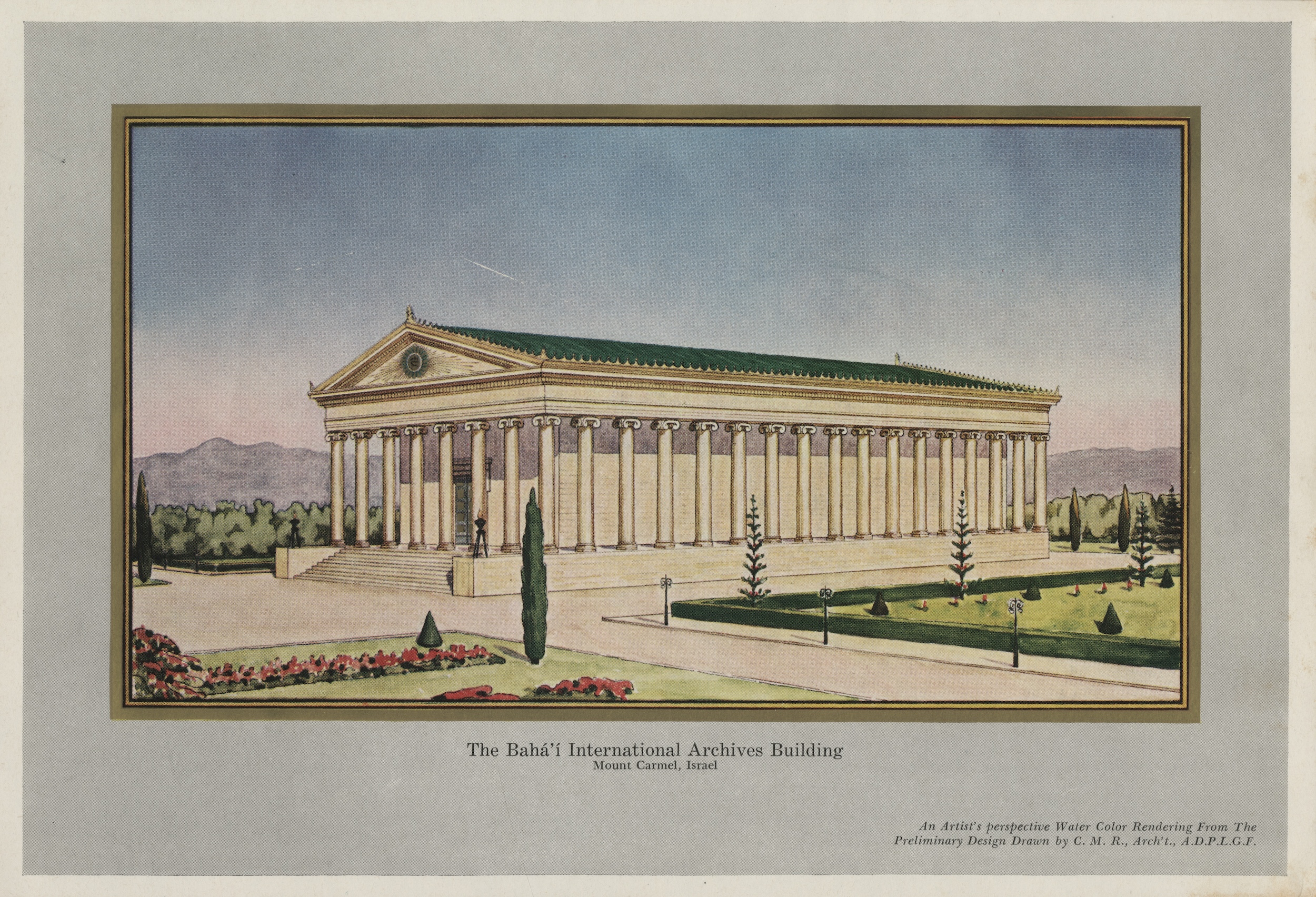
A stunning and delicate watercolor architectural drawing of the International Bahá'í Archives from designs of Shoghi Effendi. © United States National Bahá'í Archives, used with permission.
The first step was for Mason Remey to draft the plans for the International Bahá'í Archives. After this, he would bring the new drawing of the Archives to the dinner table each night, and hang it up for inspection. The Guardian was the real architect behind the superstructure of the Shrine of the Báb and the International Bahá'í Archives. William Sutherland Maxwell and Mason Remey did the drawing, but they were guided for every shape of tile, every style of column, the angle of a roof, the width of a parapet, the number of steps, by Shoghi Effendi.
Shoghi Effendi used his architects to realize the exact vision he had in his head. If he had studied architecture, he would have done it himself, but none of the designs that were produced during his ministry were the work of the architects because the final product was not their original, unmodified design for the building, it was what emerged entirely from the Guardian’s mind.
Every night in the western Pilgrim House, when the Guardian came to dinner, Mason Remey would bring his latest design and pin to the garden door of the dining room. Shoghi Effendi would half turn in his chair and study them, then point out things he wanted changed: a little higher there, a little thinner here, change this, change that. Invariably his sure eye brought the building into more perfect proportion. There was no ambiguity in the mind of the Guardian about what he wanted. The final result was a structure which, outwardly inspired by Greek architecture, had an entire life of its own, and a very distinctive style. He had created an imposing but delicate, classical yet innovative, strikingly beautiful edifice.
Obviously, one of the major differences was that Shoghi Effendi replaced the Doric columns of the Parthenon—described as sturdy and masculine—with clean Ionic columns—generally regarded as having more graceful proportions. In total, 52 columns surrounded the International Bahá'í Archives on three sides, the last one being the rear side with the majestic stained glass window.
To enter the International Bahá'í Archives was a 15-step staircase—almost as wide as the edifice itself—ascending from the ground level to the podium and the imposing single door of the building.
The most stunning feature of the International Bahá'í Archives—apart from its distinctive sea green roof tiles—was Shoghi Effendi’s design for a tympanum above the entrance—a recessed, triangular shape that connects the roof vertically with the top of the building and is generally decorated. The Guardian had designed an elaborately decorated disc containing the Greatest Name, from which 19 gilded rays of varying lengths radiated. It was simply stunning, and later, when built, it would shine bright when the sun hit the gold.
Around the building, Shoghi Effendi had designed tall blind windows, a feature of Greek architecture—fake windows that don’t let in air or light, in order not to damage the fragile relics, and above these, Shoghi Effendi had conceived of small windows—real ones, this time—that would light the narrow interior balconies along the two walls running the length of the Archives.
One of the most stunning of Shoghi Effendi’s ideas was to replace the far back wall of the Archives with a panel of 68 exquisite brightly colored, abstract stained glass windows. The effect of light filtering through what was, in essence, a colored glass wall 32 meters high by 14 meters wide, would be ethereal, heavenly.
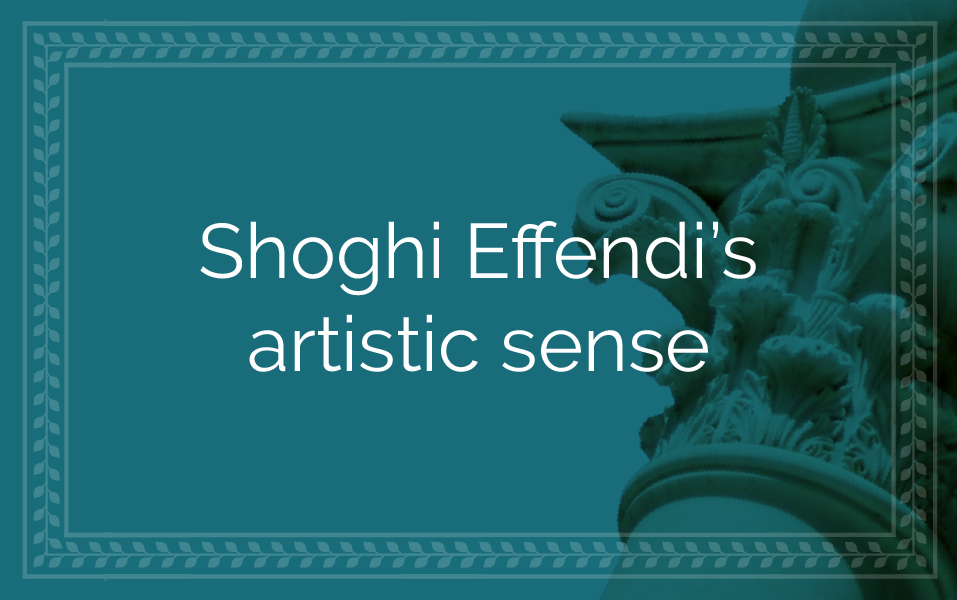

The perfect simplicity of a genius artist: a shining white edifice, pristine white paths, bright red geraniums, lush green cypresses forming a guard of honor, perfectly setting off the ruby red of the flowers. Source: Bahá'í Media Bank, © Bahá'í International Community 2023.
Shoghi Effendi had a truly extraordinary artistic sense. Of course, Shoghi Effendi’s art was the written word, he was a sublime writer, but he had a heightened aesthetic sensibility, a painter’s eye, an architect’s instinct, and an absolutely perfects sense of proportion, down to the millimeter.
This is particularly exceptional because Shoghi Effendi was born in 'Akká, one of the ugliest cities imaginable, a former prison colony with no beauty or greenery. Added to that, Shoghi Effendi never came into contact with any art growing up, at least until he went to Syrian Protestant College, and his family home didn’t have any art in it, when he was growing up.
As William Sutherland Maxwell designed the Shrine of the Báb, it was Shoghi Effendi’s style he implemented, drawing after drawing, detail after detail. Both the Shrine and the International Archives Building were, in fact, Shoghi Effendi’s design, not Mr. Maxwell’s. Mr. Maxwell realized Shoghi Effendi’s artistic and design vision.
The Guardian was the one who laid out the magnificent gardens in Haifa and Bahjí, making all the measurements himself with no help or advice from professional gardeners or horticulturalists.
It was the Guardian himself who designed the sublime interior atmospheres of the shrines of Bahá'u'lláh, the Báb and 'Abdu'l-Bahá, the Mansions of Bahjí, Mazra’ih, and the House of ‘Abbúd, down to the smallest details. He was the one who steadily, methodically, added ornaments, framed photographs, lamps, carpets, and furnishings that elevated the beauty and harmony of all these interiors, without the help of professional designers. Every single ornament or photograph was placed exactly to his specifications.
The Guardian’s sense of proportions were photographic. The only opportunity Rúḥíyyih Khánum had to clean his room was when Shoghi Effendi went to the Shrines or gardens, Rúḥíyyih Khánum, and no matter how exactly, how precisely she tried to reposition the many objects on his desk in their original position, Shoghi Effendi would return, cast one glance on the desk and adjust the various items by twisting them ever so slightly back to their correct position. No other person could have detected the infinitesimal change, but the Guardian did. He was phenomenally tidy and neat.
Shoghi Effendi loved elegant, ornate, and beautifully proportioned ornaments and items. He loved the classical Greek style of the Parthenon, Gothic architecture, and the massive Signoria in Florence, a quintessential example of Italian Gothic and Renaissance architecture, although they were so different. His artistic sense was so deep, and his design instinct so sound and solid that he could love such different styles, and bring them together in a harmonious way in his designs.
Shoghi Effendi deeply enjoyed all forms of art, including music, for which he had a great love. He also appreciated a diversity of architecture. One of the photographs handing in his room was a large framed picture of the cathedral of Milan. Another one of his personal items was a photograph of the Alhambra of Seville, which he later placed in the Mansion of Bahjí.
Perhaps the most important aspect of Shoghi Effendi’s aesthetic sense was that not only did he get inspiration from a wide variety of styles, but he was completely free by the limitations imposed by traditional design. Classical schooling in design, architecture and art limit personal style by imposing arbitrary rules of what does and does not go together, what can and cannot be combined in design. Shoghi Effendi transcended all the disciplines he mastered.
A perfect example of this is the International Archives Building. The exterior of the building is classical Greek style. Inside, Shoghi Effendi created two narrow balconies in purely Renaissance style, and the cabinets holding the relics were Japanese lacquer or Chinese carved teak wood. The six great chandeliers which hung from the ceiling were a pure European design of cut crystal. There are also modern pieces of veneer furniture, and although everything seems to be from a different style, time period, and country, together they work to create a harmonious, rich and textured atmosphere of beauty, majesty and dignity, unique in all the world.
Shoghi Effendi was extremely ingenuous, and his artistic sense allowed him to turn any space into a work of living art.
The House of ‘Abbúd, in 'Akká, had a small, open courtyard. Using just a few extra tiles, some cast cement, an old wooden pedestal, a metal peacock, and a few plants, he turned the small open courtyard into a wholly unique and original tiny, square garden that amazed the people of 'Akká who were allowed to visit the House of ‘Abbúd when it was open to the public.
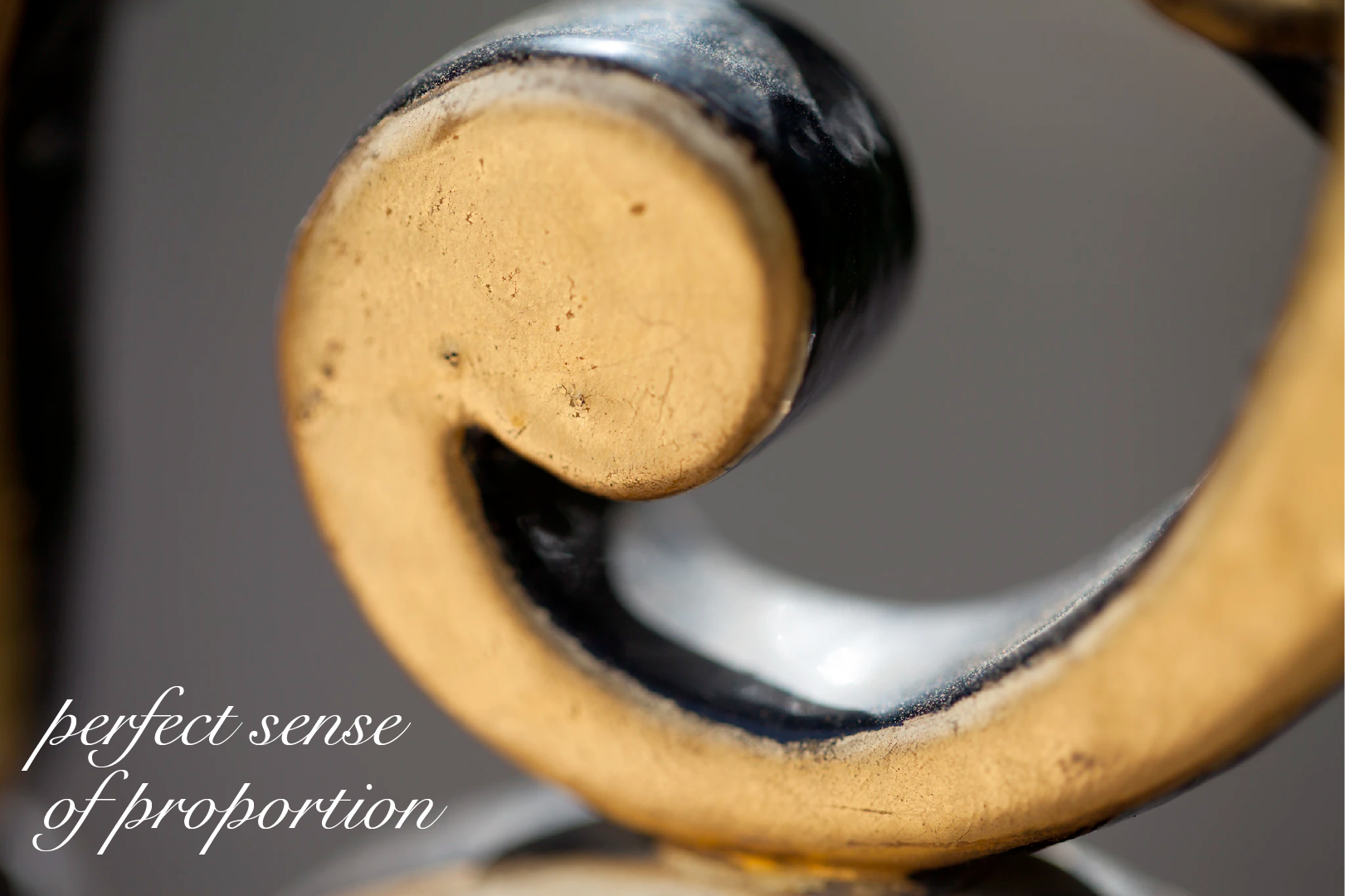
A perfect detail from one of the gates of the Monument Gardens. Source: Bahá'í Media Bank, © Bahá'í International Community 2023.
Shoghi Effendi had a perfect, almost otherworldly sense of proportion. It wasn’t that he could close his eyes and see the completed project. That was not how Shoghi Effendi worked, but once he had studied and carefully measured the terrain, the proportions in his drawings were perfect.
What made Shoghi Effendi’s designs incredibly unique was his characteristic originality, a sense of design that was innate, and had never been thwarted by schooling or excess information, which, added to his perfect sense of proportion, made all his designs absolutely original and unique, so fascinating, so beautiful.

The perfect design of the resting Place of the Greatest Holy Leaf, (Bahiyyih Khánum), the daughter of Bahá’u’lláh, in the Monument Gardens, 1930s. Source: Bahá'í Media Bank, © Bahá'í International Community 2023.
Sometimes, when the Guardian was about to leave their home, he found Rúḥíyyih Khánum impatiently waiting for him to get into his car. Shoghi Effendi would say:
I know you want to clean the room, don't you?
Yes.
As soon as the Guardian was gone, Rúḥíyyih Khánum and the girl servants of the house would immediately head to Shoghi Effendi’s two rooms and clean them thoroughly. These were the only moments when they could clean, because the Guardian was always, always, always working. And they had a limited time in which to complete the cleaning.
The Guardian had many, many things on his desk. These things—a photograph of the interior of the Shrine of Bahá'u'lláh, a box with stationery and letters, two pen-holders on either side of the desk, a blotting pad and many other beautiful things.
Once the cleaning was done, Rúḥíyyih Khánum and the girls worked very, very hard to replace everything exactly where they had found them in the first place.
Or so they thought.
When the Guardian returned, he would walk up to his desk, standing over it, and just with his fingertips, he would re-arrange, almost imperceptible, the angle of all his precious objects. With a little twist here, a little push there, a millimeter’s difference was obvious to him, until everything was back exactly where he wanted them—and where they had been before the deep clean.
Rúḥíyyih Khánum described the experience of watching the Guardian imperceptibly and gently rearrange his desk, she said it was:
The most extraordinary thing…But this was so typical of him, this marvelous sense of order.
The Guardian had a perfect eye.

According to Rúḥíyyih Khánum, The Guardian’s ideas had an organic pattern, similar to the movement of the sun through the daytime sky: dawn, glimmerings, and the noonday sun. All photos from Unsplash.
The Guardian’s ideas had an organic pattern, similar to the movement of the sun through the daytime sky.
First, was dawn, or first light.
The very, very faint outline of Shoghi Effendi’s new idea might be barely visible, like the tentative outline of the sun rising out of darkness. This could be seen in a few words, strung together to a visiting pilgrim, or the sketch of an idea hidden in the lines of a message to the Bahá'í world.
Second, were glimmerings.
Shoghi Effendi’s goal would begin to take shape, like the first rays of the sun after it had appeared out of the night. The Guardian’s concept was more defined, now, clearer, it began to take shape, because he concentrated his brilliant mind on it, and gave it life.
Third, the noon-day sun.
Once Shoghi Effendi had extracted the idea that had dawned, then discerned a viable, attainable goal in that idea, all of a sudden, in a blinding burst of light like the noonday sun we cannot look straight at, the idea would emerge in its full, glorious, blinding splendor. It would become a Seven Year Plan, a Ten Year Crusade, the International Bahá'í Archives, a new continental House of Worship, or an immense, life-altering letter like The Advent of Divine Justice or The Promised Day is Come.
SOURCES FOR PART XV
Hands of the Cause in the time of Bahá’u’lláh
Kitáb-i-Aqdas, Bahá’u’lláh.
Wikipedia: Hands of the Cause.
Hands of the Cause in the time of ‘Abdu’l-Bahá
Kitáb-i-Aqdas, Bahá’u’lláh, Note 183.
Wikipedia: Hands of the Cause.
Hands of the Cause named posthumously by the Guardian
Wikipedia: Hands of the Cause.
23 December 1951: The Guardian’s private cable to William Sutherland Maxwell
Maxwells of Montreal, The: Middle Years 1923-1937 Late Years 1937-1952. Violette Nakhjavani, George Ronald, Oxford (2011), Kindle Edition, Location 8488.
The cable of 24 December 1951: The Guardian inaugurates the Institution of the Hands of the Cause
The first contingent of Hands of the Cause
REFERENCES FOR THE TWO PREVIOUS STORIES:
The Will and Testament of ‘Abdu’l-Bahá.
The Priceless Pearl, Rúḥíyyih Rabbání, Bahá’í Publishing Trust, London, 1969, pages 253-255.
The Bahá’í Encyclopedia Project: Hands of the Cause.
Messages to the Bahá’í World: 1950–1957, Shoghi Effendi, Bahá’í Publishing Trust, Wilmette, Illinois, 1971, 24 December 1951: The Guardian Announces Appointment of Hands of the Cause, pages 18-20.
29 February 1952: The second contingent of Hands of the Cause
The Priceless Pearl, Rúḥíyyih Rabbání, Bahá’í Publishing Trust, London, 1969, pages 253-255.
One Vaḥíd of Hands of the Cause
The Priceless Pearl, Rúḥíyyih Rabbání, Bahá’í Publishing Trust, London, 1969, pages 253-255 and 258.
Far-reaching changes at the Bahá’í World Centre
The Priceless Pearl, Rúḥíyyih Rabbání, Bahá’í Publishing Trust, London, 1969, pages 255-257.
A day in the life of the Guardian
In the Days of the Guardian: Transcript of a talk by Hand of the Cause of God Leroy Ioas, Johannesburg, South Africa, 1958.
Shoghi Effendi and ‘Abdu’l-Bahá: “I am like a drop”
In the Days of the Guardian: Transcript of a talk by Hand of the Cause of God Leroy Ioas, Johannesburg, South Africa, 1958.
The story of the land at Bahjí
Leroy Ioas: Hand of the Cause of God, Anita Ioas Chapman, George Ronald, 1998, pages 188-189.
Mid-February – 29 February 1952: Músá and Samíhíh Banání’s second pilgrimage
Lights of Fortitude: Glimpses into the Lives of the Hands of the Cause of God, Barron Deems Harper, George Ronald, 1997, pages 339-345.
Bahaipedia: Músá Banání.
29 February 1952: Hand of the Cause Músá Banání
Lights of Fortitude: Glimpses into the Lives of the Hands of the Cause of God, Barron Deems Harper, George Ronald, 1997, pages 339-345.
Bahaipedia: Músá Banání.
24 February 1897 – March 1952: Colonel Jalál Kháḍih
Bahaipedia: Jalál Kháḍih.
Lights of Fortitude: Glimpses into the Lives of the Hands of the Cause of God, Barron Deems Harper, George Ronald, 1997, pages 164-167.
March 1952: Jalál Kháḍih’s life-altering pilgrimage
Lights of Fortitude: Glimpses into the Lives of the Hands of the Cause of God, Barron Deems Harper, George Ronald, 1997, pages 164-167.
Email communication with Yas Taherzadeh dated 14 December 2023 confirming details of Jalál Kháḍih’s pilgrimage as confirmed by her parents Mersede Taherzadeh and Ronald Taherzadeh. Ronald Taherzadeh having heard this story directly from Jalál Kháḍih at a summer school.
4 March 1952: Ugo Giachery meets Shoghi Effendi for the first time
Shoghi Effendi: Recollections, Ugo Giachery, George Ronald, 1973, pages 10-11, 79. and, 124 and 198.
Shoghi Effendi’s favorite scent and favorite flower
Shoghi Effendi: Recollections, Ugo Giachery, George Ronald, 1973 pages 146-147.
4 March 1952: Shoghi Effendi speaks to Ugo Giachery about the monumental Shrine of Bahá’u’lláh
Shoghi Effendi: Recollections, Ugo Giachery, George Ronald, 1973, pages 125-126 and 131-132.
4 March 1952: Shoghi Effendi’s vision for Bahjí
Shoghi Effendi: Recollections, Ugo Giachery, George Ronald, 1973, pages 124 and 132-134.
Shoghi Effendi: Recollections, Ugo Giachery, George Ronald, 1973, pages 31-32.
Shoghi Effendi speaks to Ugo Giachery about the Covenant-breakers
Shoghi Effendi: Recollections, Ugo Giachery, George Ronald, 1973, pages 17-18 and 123.
8 March 1952: Enlargement of the International Bahá’í Council
The Priceless Pearl, Rúḥíyyih Rabbání, Bahá’í Publishing Trust, London, 1969, pages 252-253.
Messages to the Bahá’í World: 1950–1957, Shoghi Effendi, Bahá’í Publishing Trust, Wilmette, Illinois, 1971, 4 May 1955 cablegram, page 86.
10 March 1952: Leroy Ioas: Shoghi Effendi’s “Hercules”
Leroy Ioas: Hand of the Cause of God, Anita Ioas Chapman, George Ronald, 1998, pages xi, 22, 157, 160
Bahaipedia: Leroy Ioas.
Shoghi Effendi: Recollections, Ugo Giachery, George Ronald, 1973, page 195.
Shoghi Effendi’s physical appearance
In the Days of the Guardian: Transcript of a talk by Hand of the Cause of God Leroy Ioas, Johannesburg, South Africa, 1958.
Shoghi Effendi’s two topics of consultation
Shoghi Effendi: Recollections, Ugo Giachery, George Ronald, 1973, pages 10-11 and 198.
Shoghi Effendi and the most precious documents of the International Bahá’í Archives
Shoghi Effendi: Recollections, Ugo Giachery, George Ronald, 1973, pages 149-150.
The Dawn-Breakers, Nabíl, translated by Shoghi Effendi: Epigraph page.
The Kitáb-i-Íqán, Bahá’u’lláh.
This quote is slightly different in The Kitáb-i-Íqán:
…We stand, life in hand, wholly resigned to His will; that perchance, through God’s loving-kindness and His grace, this revealed and manifest Letter may lay down His life as a sacrifice in the path of the Primal Point…
How the original Tablets revealed by the Báb for the Letters of the Living were found
Shoghi Effendi: Recollections, Ugo Giachery, George Ronald, 1973, pages 150-151.
After 25 March 1952: Ugo Giachery works on the Shrine of the Báb
Shoghi Effendi: Recollections, Ugo Giachery, George Ronald, 1973, pages 20-21.
5 April 1952: Nayyír Afnán—Pivot of machinations
The Covenant of Bahá’u’lláh, Adib Taherzadeh, George Ronald, Oxford, 1992: Chapter 32: The Faithless Relatives of Shoghi Effendi.
Messages to the Bahá’í World: 1950–1957, Shoghi Effendi, Bahá’í Publishing Trust, Wilmette, Illinois, 1971, Cable dated 5 April 1952, pages 24-25.
Shoghi Effendi Through the Pilgrim’s Eye Volume 1 Building the Administrative Order, 1922-1952. Earl Redman, George Ronald, Oxford, 2015, Kindle Edition, Location 8247.
The Will and Testament of ‘Abdu’l-Bahá.
A spiritual perspective on Covenant-breaking
The Covenant of Bahá’u’lláh, Adib Taherzadeh, George Ronald, Oxford, 1992 Chapter 32: The Faithless Relatives of Shoghi Effendi.
The Priceless Pearl, Rúḥíyyih Rabbání, Bahá’í Publishing Trust, London, 1969, pages 121-123.
Late May 1952: The Guardian’s design for the House of Worship in the Holy Land
Shoghi Effendi: Recollections, Ugo Giachery, George Ronald, 1973, pages 170-171.
Late May 1952: Leroy Ioas and the court case with the Covenant-breakers
The Guardian’s appeal to the Attorney General
REFERENCES FOR THE PREVIOUS TWO STORIES:
Leroy Ioas: Hand of the Cause of God, Anita Ioas Chapman, George Ronald, 1998, pages 188-190.
Messages to the Bahá’í World: 1950–1957, Shoghi Effendi, Bahá’í Publishing Trust, Wilmette, Illinois, 1971, pages 28-30.
29 May 1952: The Guardian formally begins laying out the gardens at Bahjí
Shoghi Effendi: Recollections, Ugo Giachery, George Ronald, 1973, pages 128-129.
Messages to the Bahá’í World: 1950–1957, Shoghi Effendi, Bahá’í Publishing Trust, Wilmette, Illinois, 1971, pages 28-30.
Leroy Ioas: Hand of the Cause of God, Anita Ioas Chapman, George Ronald, 1998, pages 188-190.
30 June 1952: The estimate for the colonnade of the Shrine of Bahá’u’lláh
Shoghi Effendi: Recollections, Ugo Giachery, George Ronald, 1973, pages 132-134.
Messages to the Bahá’í World: 1950–1957, Shoghi Effendi, Bahá’í Publishing Trust, Wilmette, Illinois, 1971, page 32.
Precious relics collected by Shoghi Effendi for 30 years
The Priceless Pearl, Rúḥíyyih Rabbání, Bahá’í Publishing Trust, London, 1969, pages 263-266.
Coronation on Carmel: The Story of the Shrine of the Báb Volume II: 1922-1963, Michael V. Day, George Ronald, 2018, pages 263-264.Leroy Ioas: Hand of the Cause of God, Anita Ioas Chapman, George Ronald, 1998, page 238.
Relics of Bahá’u’lláh and the Báb
October 1952: The need for an edifice for the International Bahá’í Archives
REFERENCES FOR THE FOUR PRECEDING STORIES:
The Priceless Pearl, Rúḥíyyih Rabbání, Bahá’í Publishing Trust, London, 1969, pages 263-266.
Coronation on Carmel: The Story of the Shrine of the Báb Volume II: 1922-1963, Michael V. Day, George Ronald, 2018, pages 263-264.
Leroy Ioas: Hand of the Cause of God, Anita Ioas Chapman, George Ronald, 1998, page 239.
Messages to the Bahá’í World: 1950–1957, Shoghi Effendi, Bahá’í Publishing Trust, Wilmette, Illinois, 1971, pages 43-44.
The Bahá’í World Volume 13: The Completion of the International Archives.
Wikipedia: La Madeleine (Paris).
Encyclopedia Britannica: Chaim Weitzmann.
Encyclopedia.com: Weitzmann, Chaim.
Wikipedia: Chaim Weizmann.
Wikipedia: Balfour Declaration.
Shoghi Effendi Through the Pilgrim’s Eye Volume 1 Building the Administrative Order, 1922-1952. Earl Redman, George Ronald, Oxford, 2015, Kindle Edition, Location 8756-8774.
Date of Chaim Weizmann’s State Funeral: Israeli Film Archive: The Sherman Grinberg Film Library: Israel & Palestine Footage: Pathé Newsreel, 10 November, 1952: The Funeral of Israeli President Chaim Weizmann.
10 November 1952: Corinne True and ‘Abdu’l-Bahá’s wallet
Leroy Ioas: Hand of the Cause of God. Anita Ioas Chapman, George Ronald, 1998, page 289.
Bahaipedia: Corinne True.
Corinne True: Faithful Handmaid of ‘Abdu’l-Bahá, Nathan Rutstein with the assistance of Edna True, George Ronald, Oxford (1987), pages 204-206.
In the Days of the Guardian: Transcript of a talk by Hand of the Cause of God Leroy Ioas, Johannesburg, South Africa, 1958.
10 November 1952: Corinne True, “spiritual politician”
Leroy Ioas: Hand of the Cause of God. Anita Ioas Chapman, George Ronald, 1998, page 289.
Bahaipedia: Corinne True.
Corinne True: Faithful Handmaid of ‘Abdu’l-Bahá, Nathan Rutstein with the assistance of Edna True, George Ronald, Oxford (1987), pages 204-206.
11 November 1952: Tomorrow morning, we all shall go to Bahjí
Shoghi Effendi: Recollections, Ugo Giachery, George Ronald, 1973, page 127.
12 November 1952: The Guardian obtains the Baydún land
The Priceless Pearl, Rúḥíyyih Rabbání, Bahá’í Publishing Trust, London, 1969, pages 88-89 and 233-234.
Shoghi Effendi: Recollections, Ugo Giachery, George Ronald, 1973, page 125.
Leroy Ioas: Hand of the Cause of God, Anita Ioas Chapman, George Ronald, 1998, pages 205-208.
Shoghi Effendi Through the Pilgrim’s Eye Volume 1 Building the Administrative Order, 1922-1952. Earl Redman, George Ronald, Oxford, 2015, Kindle Edition, Locations 8208-8292.
Bahaipedia: Lawrence Hutz.
Wikipedia: Golda Meir.
12 November 1952 at 2 PM: The Guardian begins planning the gardens around the Ḥaram-i-Aqdas
12 November 1952: Shoghi Effendi traces paths and begins planting
12 November 1952: Leveling the ground
The Guardian’s workroom at Bahjí
12 November 1952: Shoghi Effendi’s directing force
REFERENCES FOR THE FIVE PREVIOUS SECTIONS:
Shoghi Effendi: Recollections, Ugo Giachery, George Ronald, 1973, pages 127-128.
The Priceless Pearl, Rúḥíyyih Rabbání, Bahá’í Publishing Trust, London, 1969, pages 8-90.
Reflections on the Bahá’í Writings: The Guardian’s Workroom.
The Bahá’í Faith: The Official Website of the Worldwide Bahá’í community: The Shrine of Bahá’u’lláh.
Bahá’í Library Online: Notes on Pilgrimage to Haifa, 15 – 23 April 1957, Alice Dudley.
Shoghi Effendi’s white Galilee pebbles
Shoghi Effendi: Recollections, Ugo Giachery, George Ronald, 1973, page 130.
The Priceless Pearl, Rúḥíyyih Rabbání, Bahá’í Publishing Trust, London, 1969, pages 8-90.
‘Adasiyyah: A Study in Agriculture and Rural Development, Iraj Poostchi Baha’i Studies Review, Volume 16, Number 1, 1 April 2010, pp. 61-105(45).
The Bahá’í Faith: The Official Website of the Worldwide Bahá’í community: The Shrine of Bahá’u’lláh.
Bahá’í Library Online: Notes on Pilgrimage to Haifa, 15 – 23 April 1957, Alice Dudley.
15 November 1952: The gardens at Bahjí are complete
Shoghi Effendi: Recollections, Ugo Giachery, George Ronald, 1973, pages 128-129.
The Priceless Pearl, Rúḥíyyih Rabbání, Bahá’í Publishing Trust, London, 1969, pages 8-90.
‘Adasiyyah: A Study in Agriculture and Rural Development, Iraj Poostchi Baha’i Studies Review, Volume 16, Number 1, 1 April 2010, pp. 61-105(45).
The Bahá’í Faith: The Official Website of the Worldwide Bahá’í community: The Shrine of Bahá’u’lláh.
Bahá’í Library Online: Notes on Pilgrimage to Haifa, 15 – 23 April 1957, Alice Dudley.
A few days after 15 November 1952: A gates for a path at Bahjí
Shoghi Effendi: Recollections, Ugo Giachery, George Ronald, 1973, page 129.
Late 1952: The exquisite door to the Shrine of Bahá’u’lláh
Shoghi Effendi: Recollections, Ugo Giachery, George Ronald, 1973, pages 135-136.
Late 1952: Ugo Giachery’s experience with a first map by the Guardian
Shoghi Effendi: Recollections, Ugo Giachery, George Ronald, 1973, pages 43-44.
The Priceless Pearl, Rúḥíyyih Rabbání, Bahá’í Publishing Trust, London, 1969, page 24, 126, 128, 410-411, and 446.
Abdu’l-Baha’s Tablets of the Divine Plan: Geography Book used for the Tablets of the Divine Plan, Brent Poirier.
Winter 1952: The inspiration for the International Bahá’í Archives
Leroy Ioas: Hand of the Cause of God, Anita Ioas Chapman, George Ronald, 1998, page 239.
The Bahá’í World Volume 13: The Completion of the International Archives.
Wikipedia: La Madeleine (Paris).
29 December 1952: Rúḥíyyih Khánum describes the Shrines on Israeli radio
Bahá’í News, Issue 265 (March 1953).
1953: The design of the International Bahá’í Archives
Leroy Ioas: Hand of the Cause of God, Anita Ioas Chapman, George Ronald, 1998, pages 239-240.
The Bahá’í World Volume 13: The Completion of the International Archives.
Khan Academy: Greek Architectural Orders.
The Bahá’í World Volume 12: The Completion of the International Bahá’í Archives, Amatul’Bahá Ruḥíyyíh Khánum.
Shoghi Effendi: Recollections, Ugo Giachery, George Ronald, 1973, page 159.
The Priceless Pearl, Rúḥíyyih Rabbání, Bahá’í Publishing Trust, London, 1969, pages 141-143 and 359.
Transcript of: Amatul’Bahá Rúḥíyyih Khánum’s concluding address at the First Bahá’í World Congress in London, 1963, Timestamp: 01:19:10.
Shoghi Effendi’s flawless sense of proportion
The Priceless Pearl, Rúḥíyyih Rabbání, Bahá’í Publishing Trust, London, 1969, pages 87. 88, and 90.
Transcript of: Amatul’Bahá Rúḥíyyih Khánum’s concluding address at the First Bahá’í World Congress in London, 1963, Timestamp: 01:27:20.
Shoghi Effendi’s ideas and inspiration
The Priceless Pearl, Rúḥíyyih Rabbání, Bahá’í Publishing Trust, London, 1969, page 132.
![]()
 Hands of the Cause in the time of 'Abdu'l-Bahá
Hands of the Cause in the time of 'Abdu'l-Bahá



























